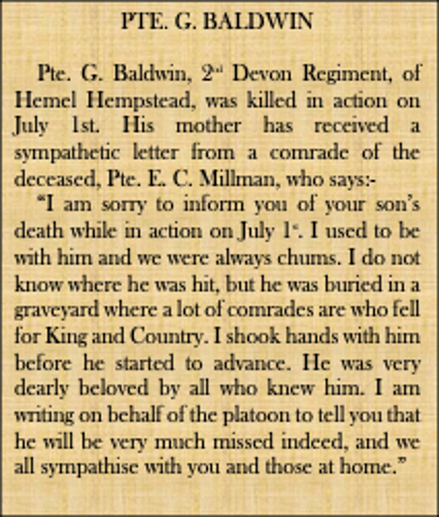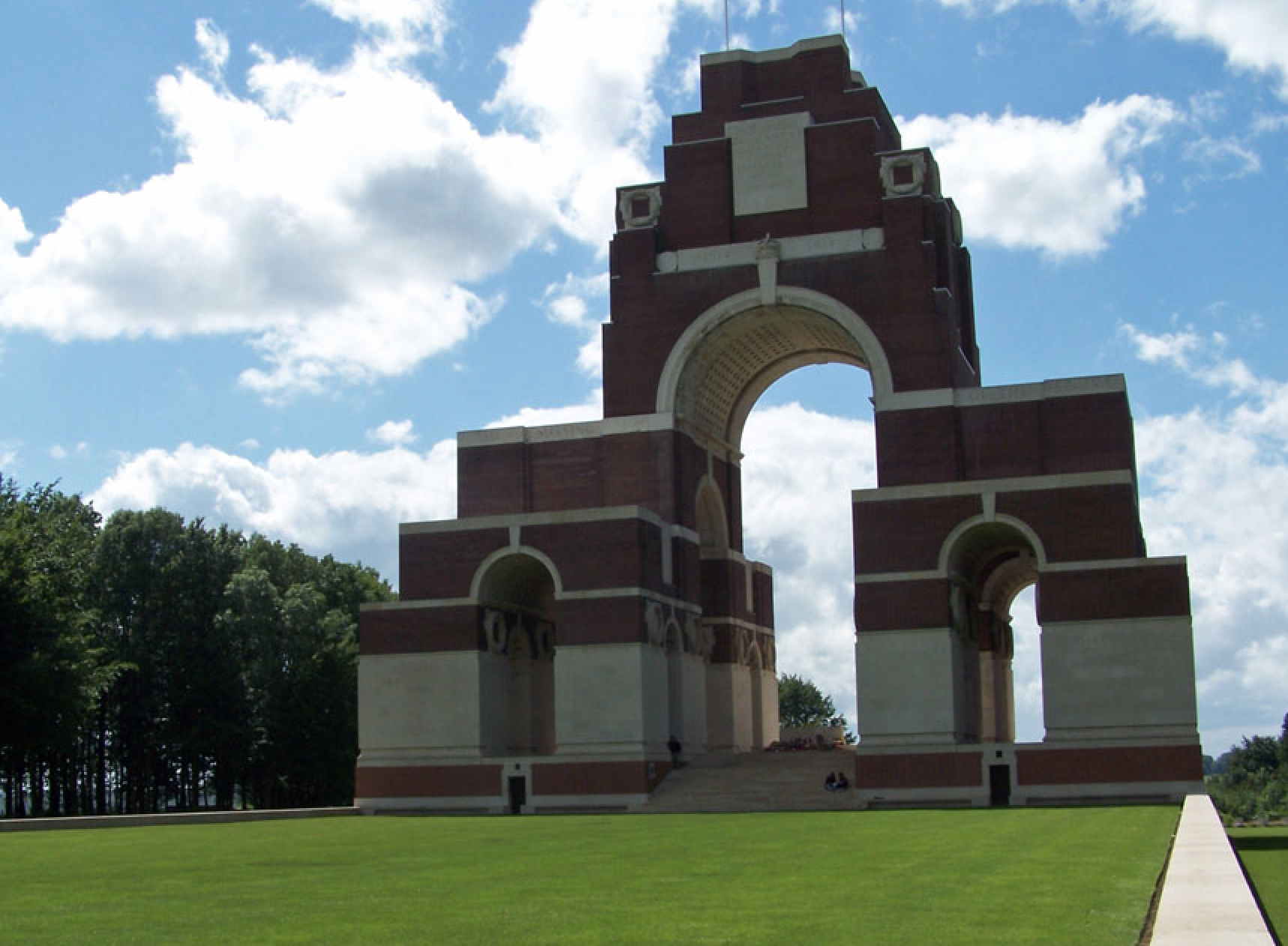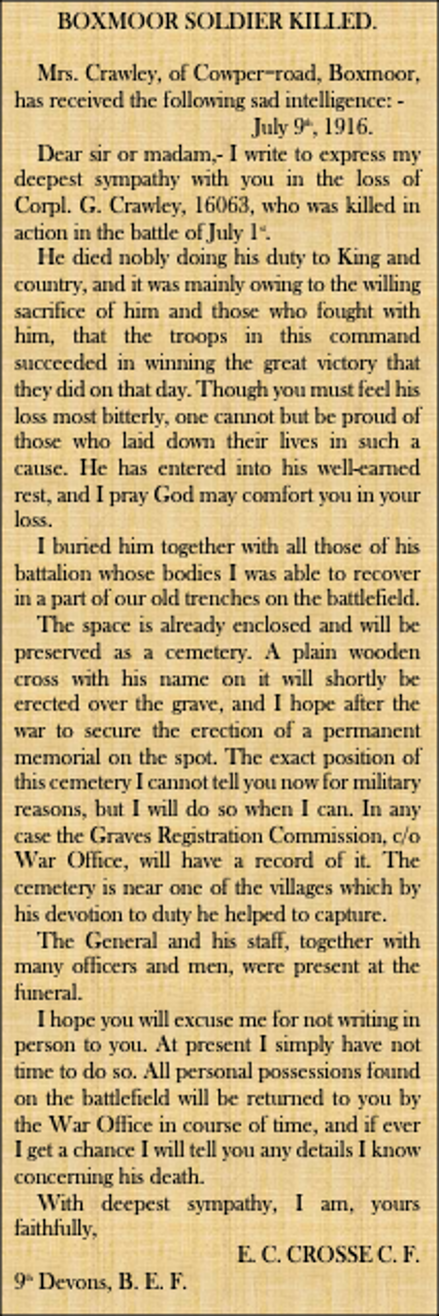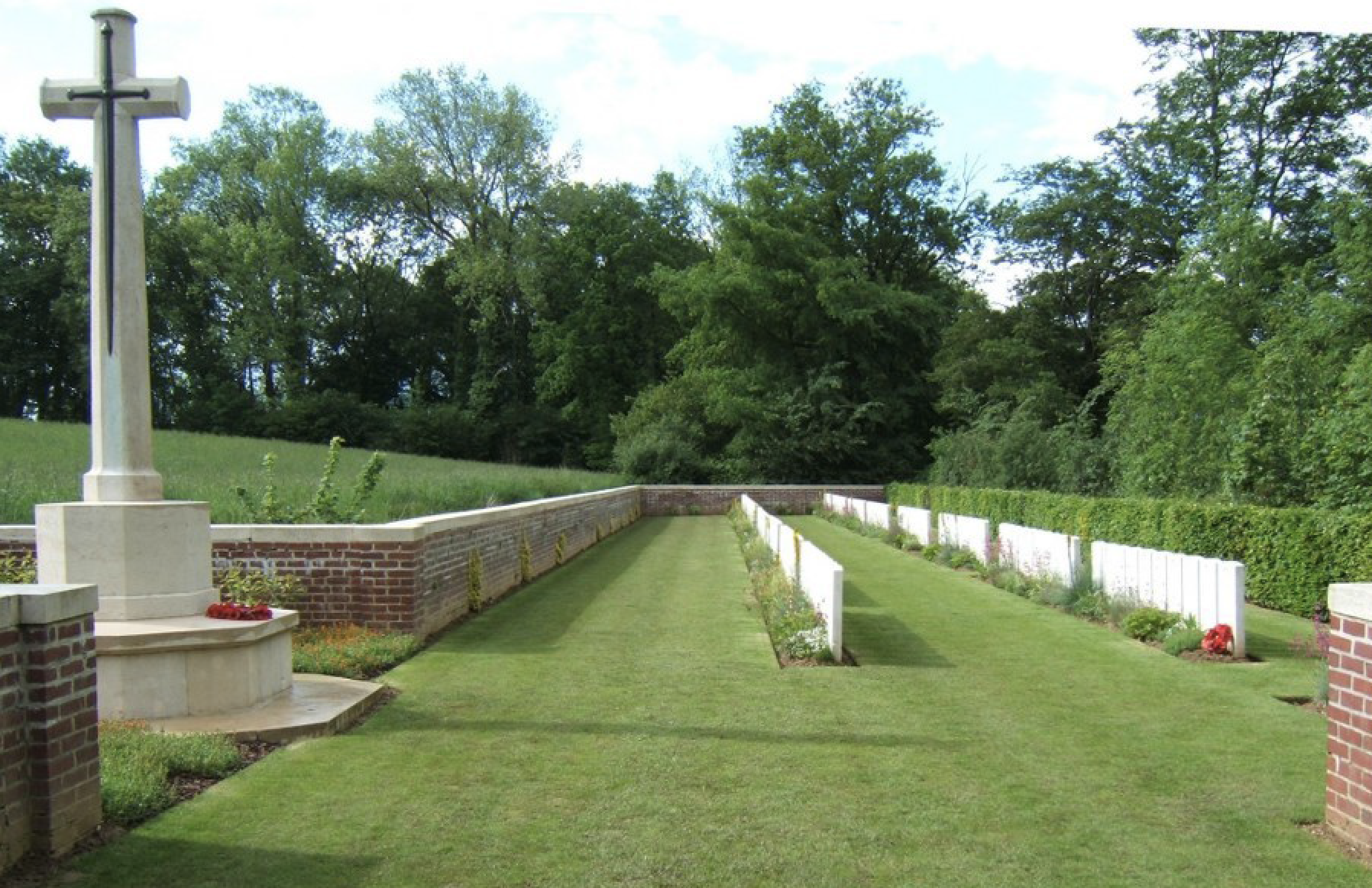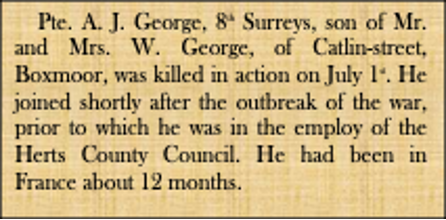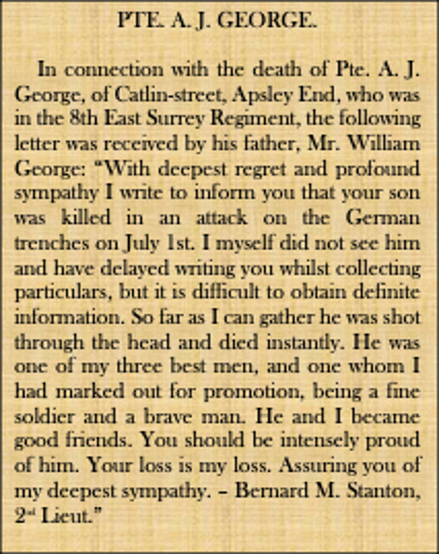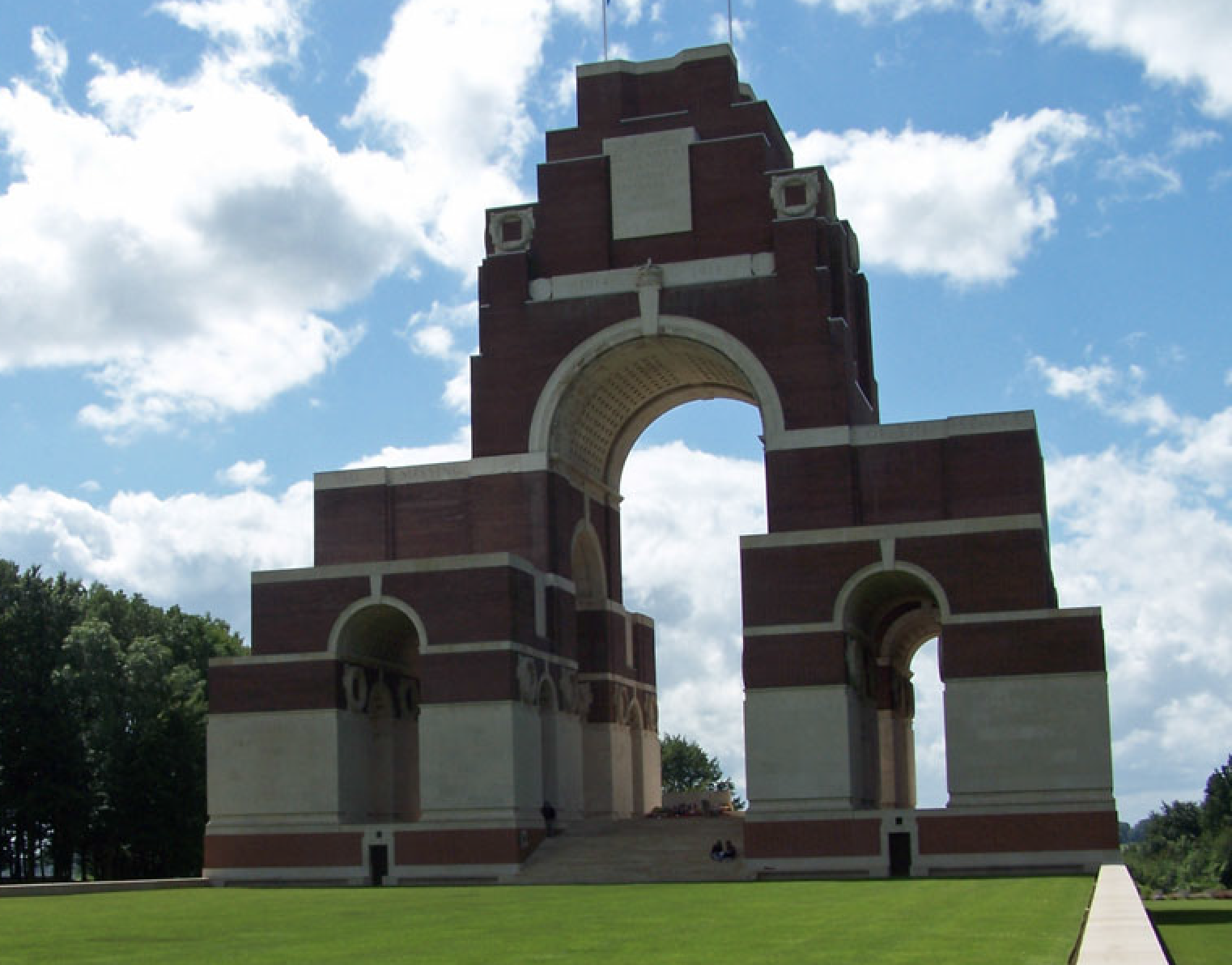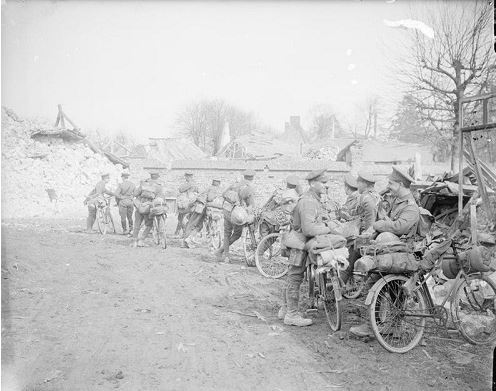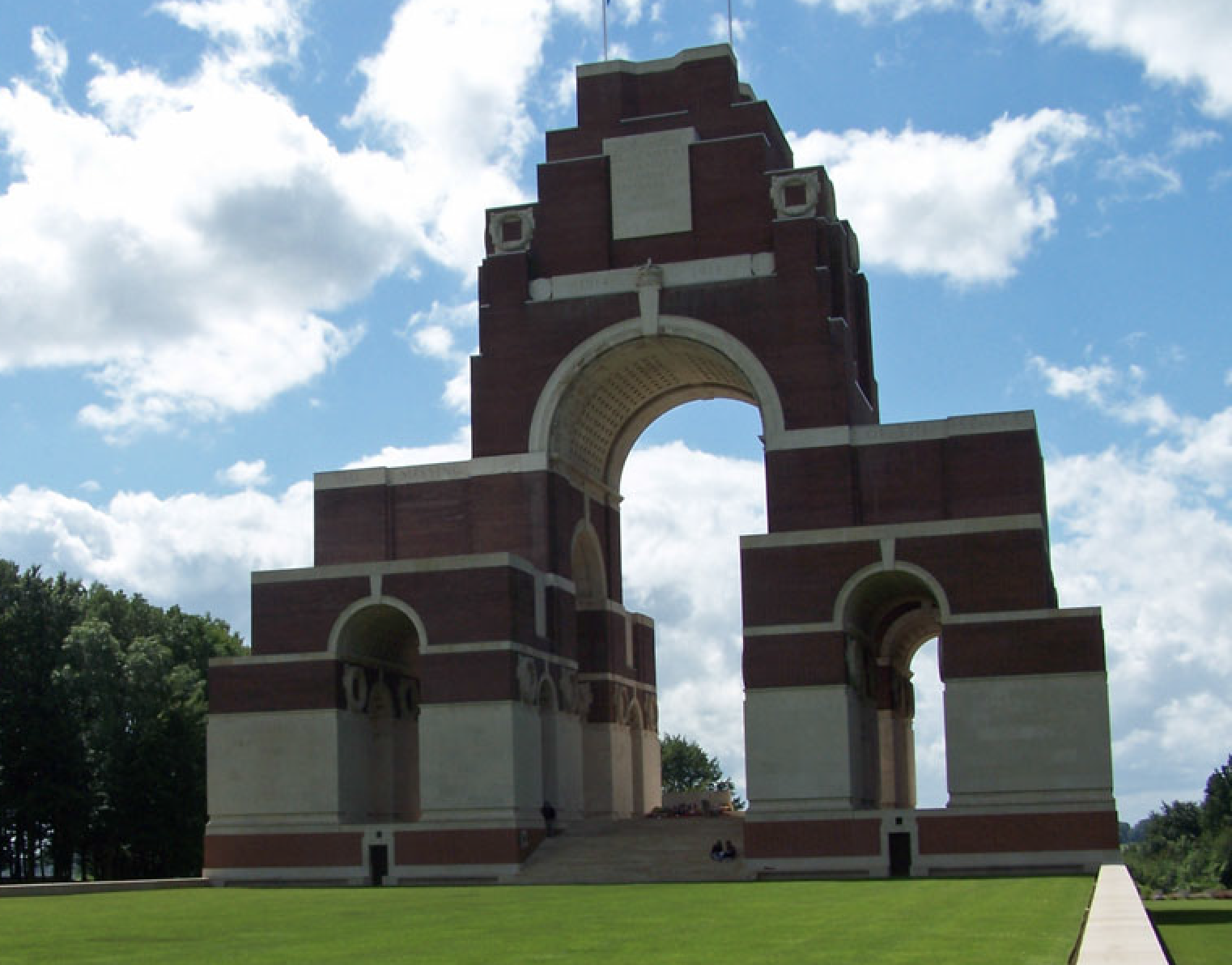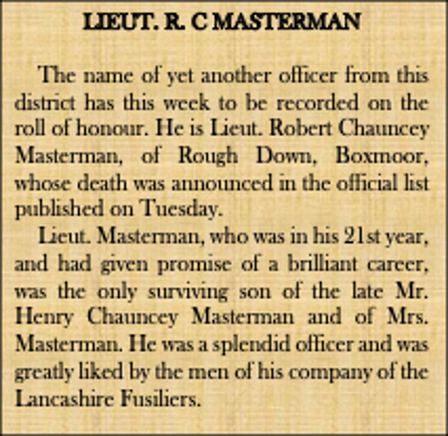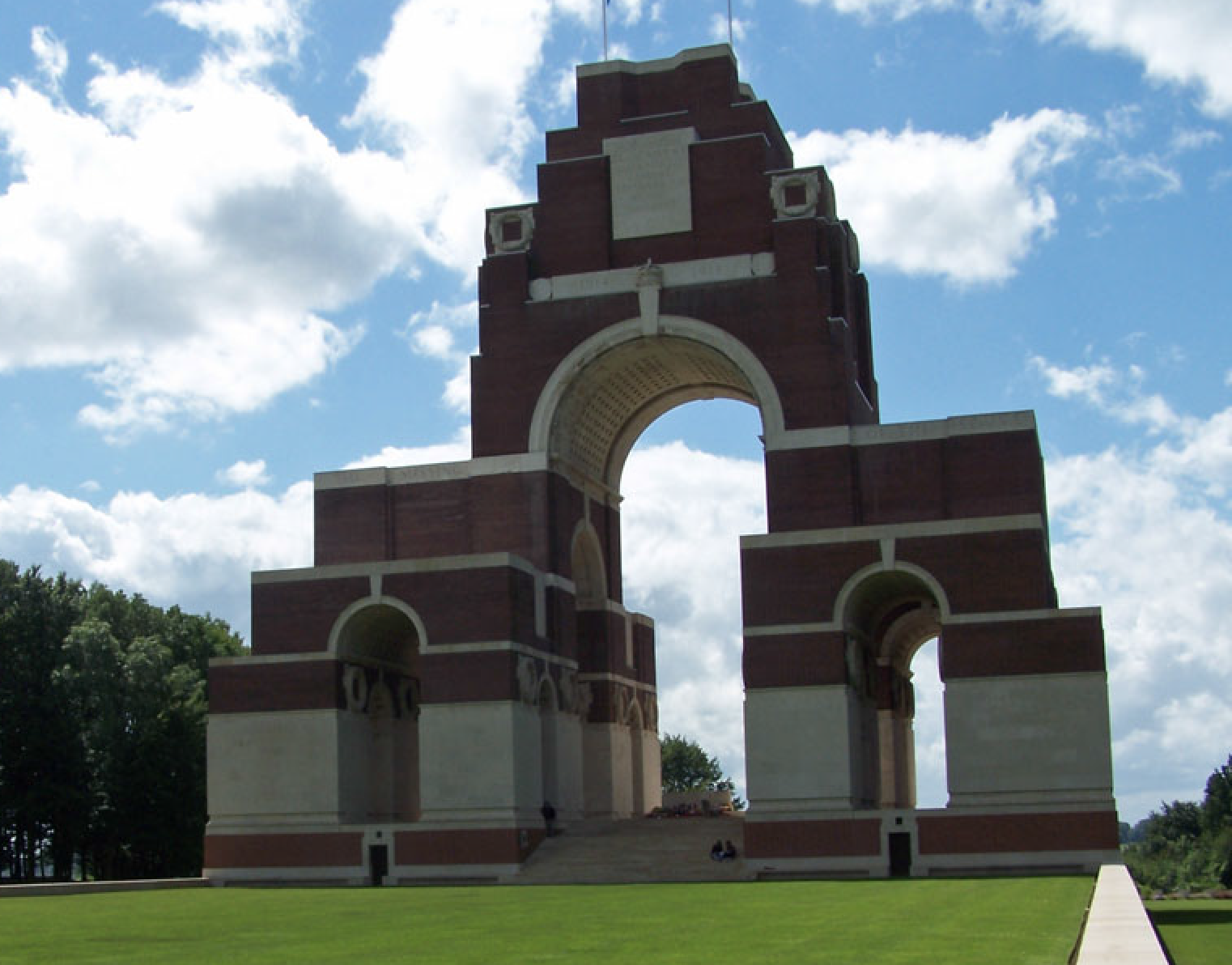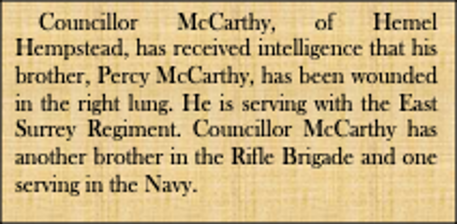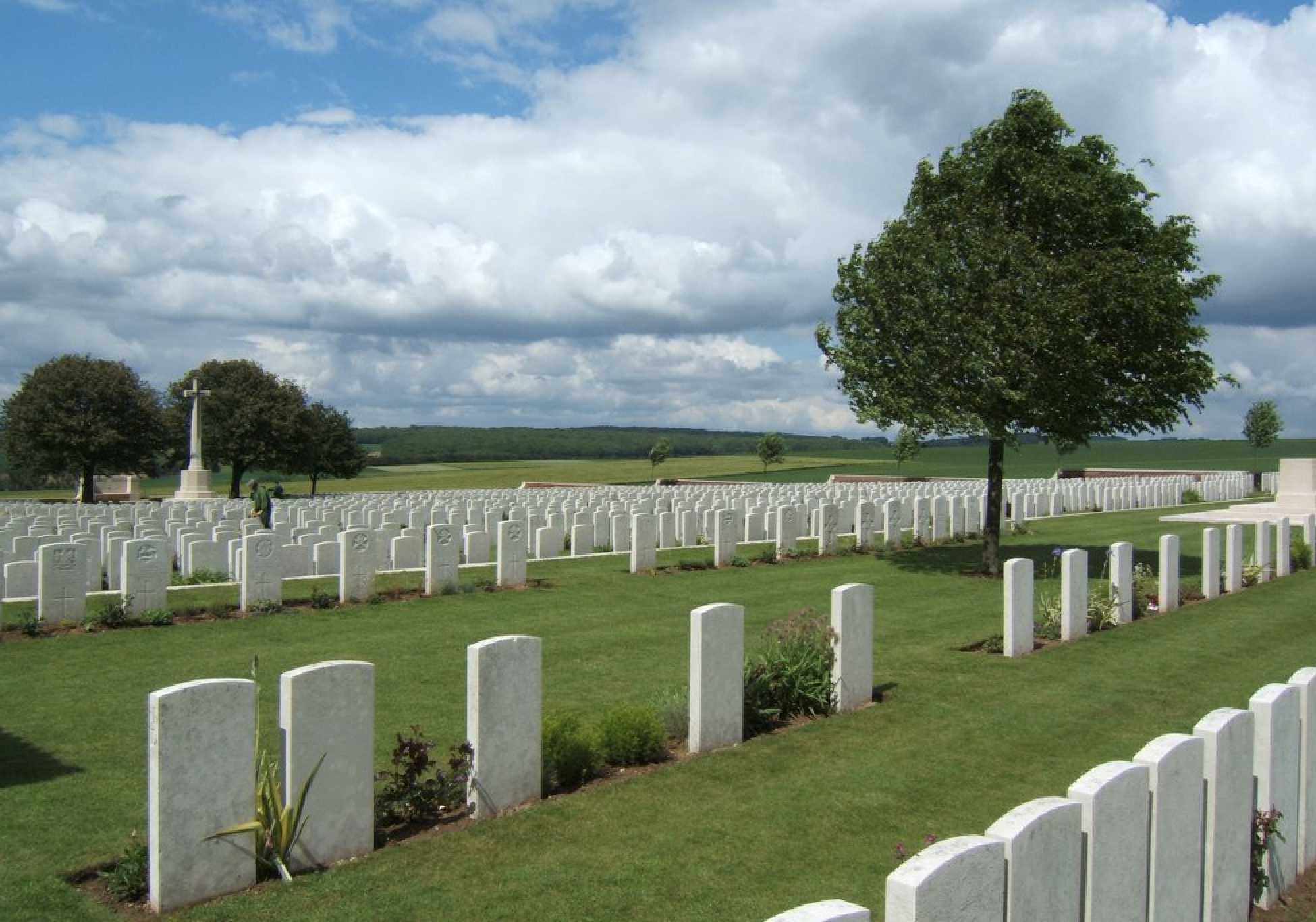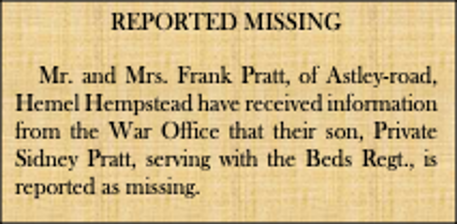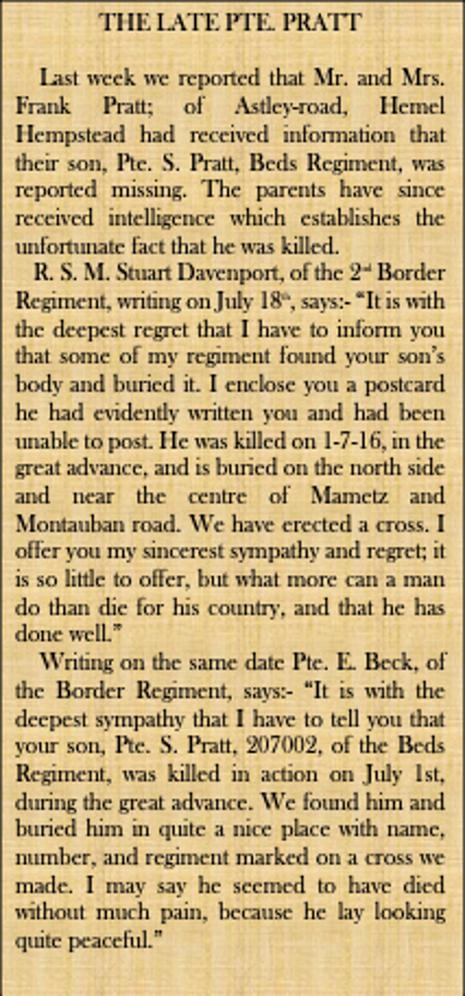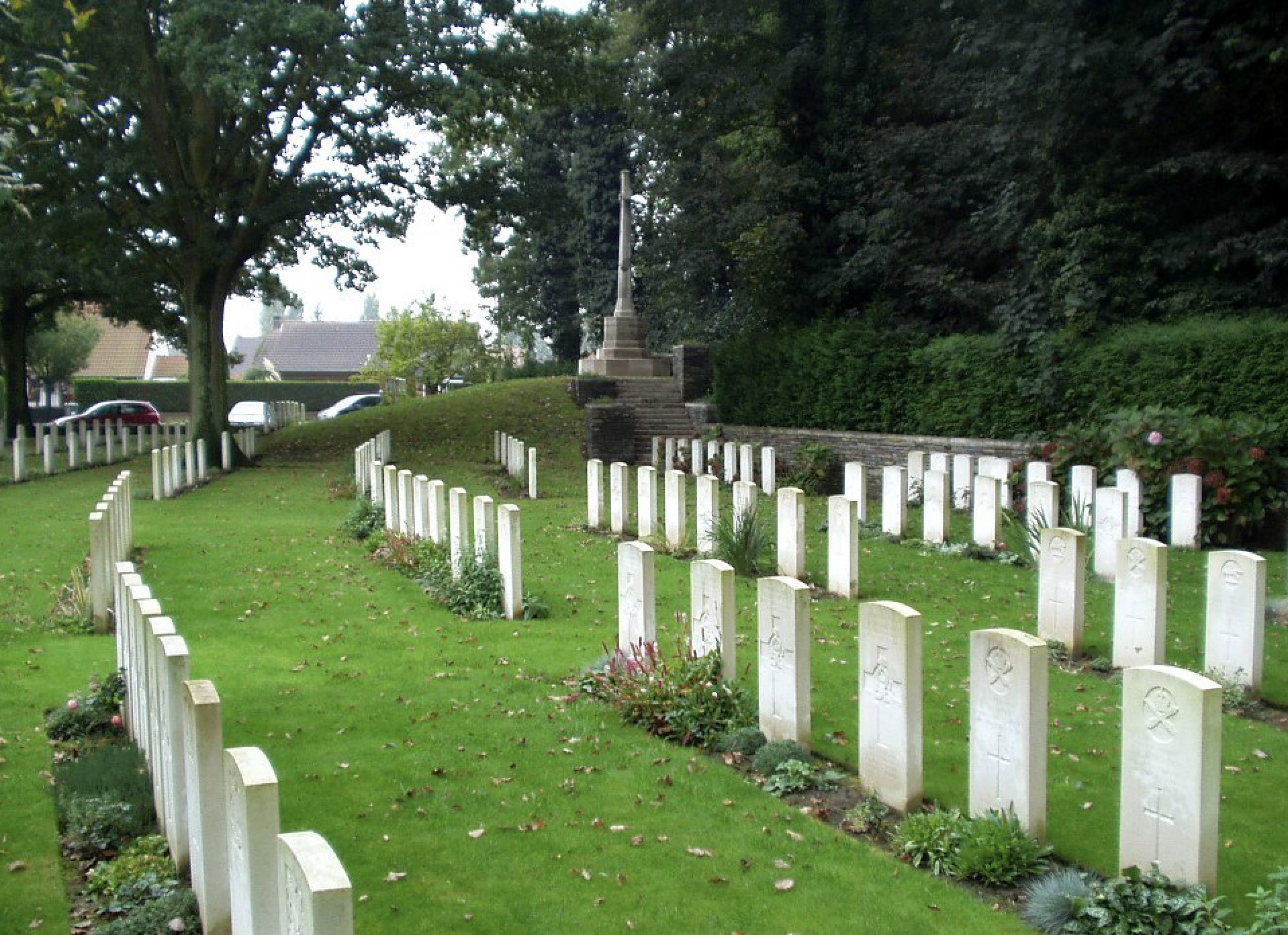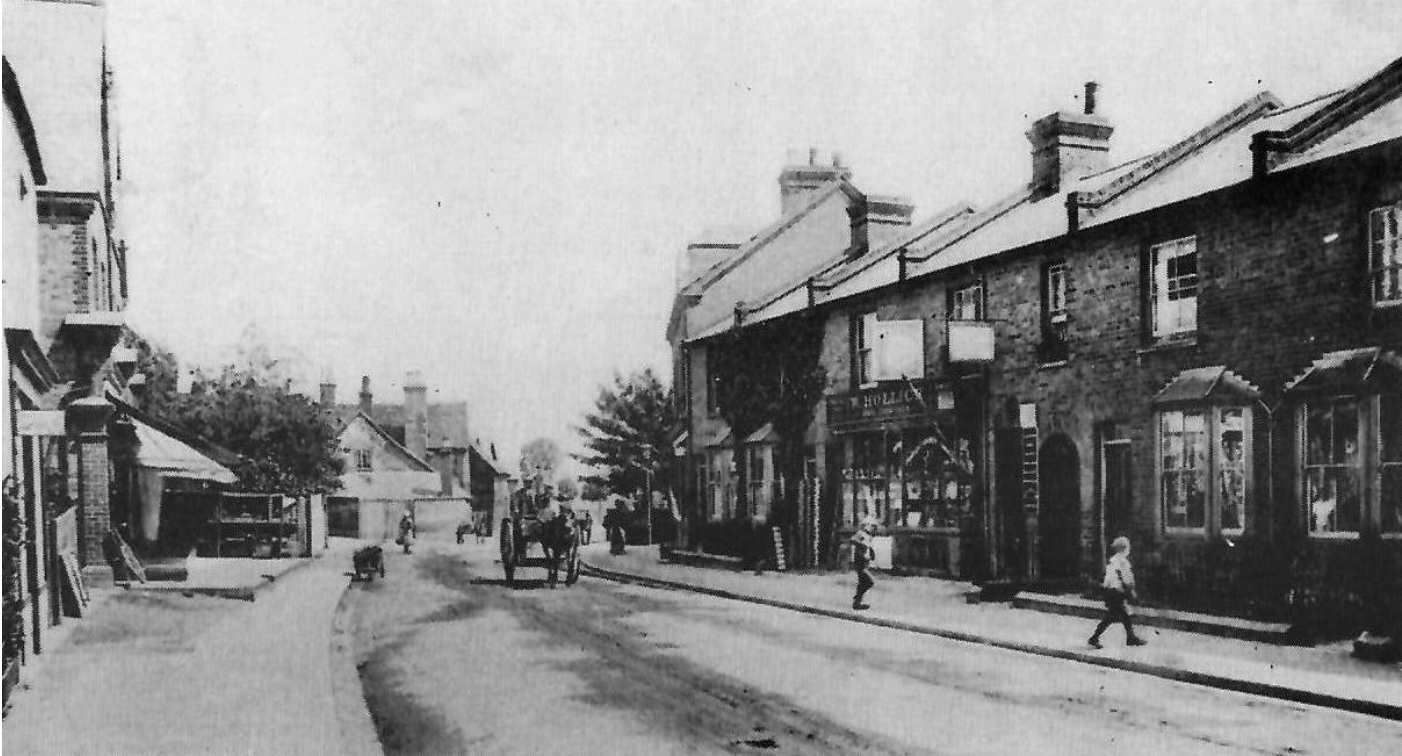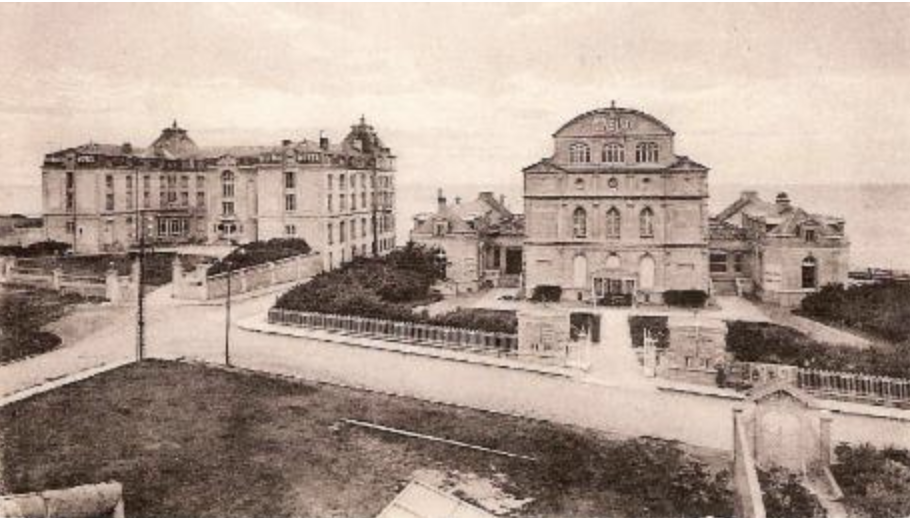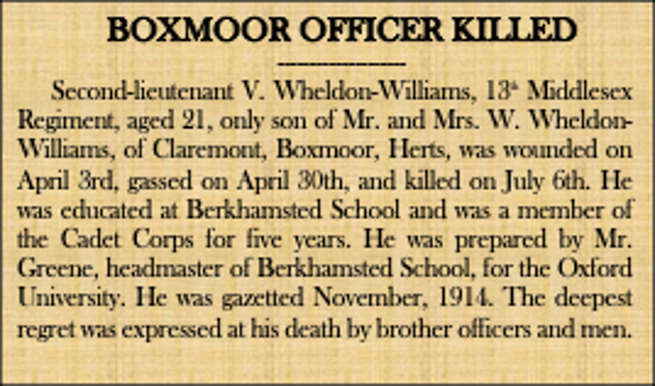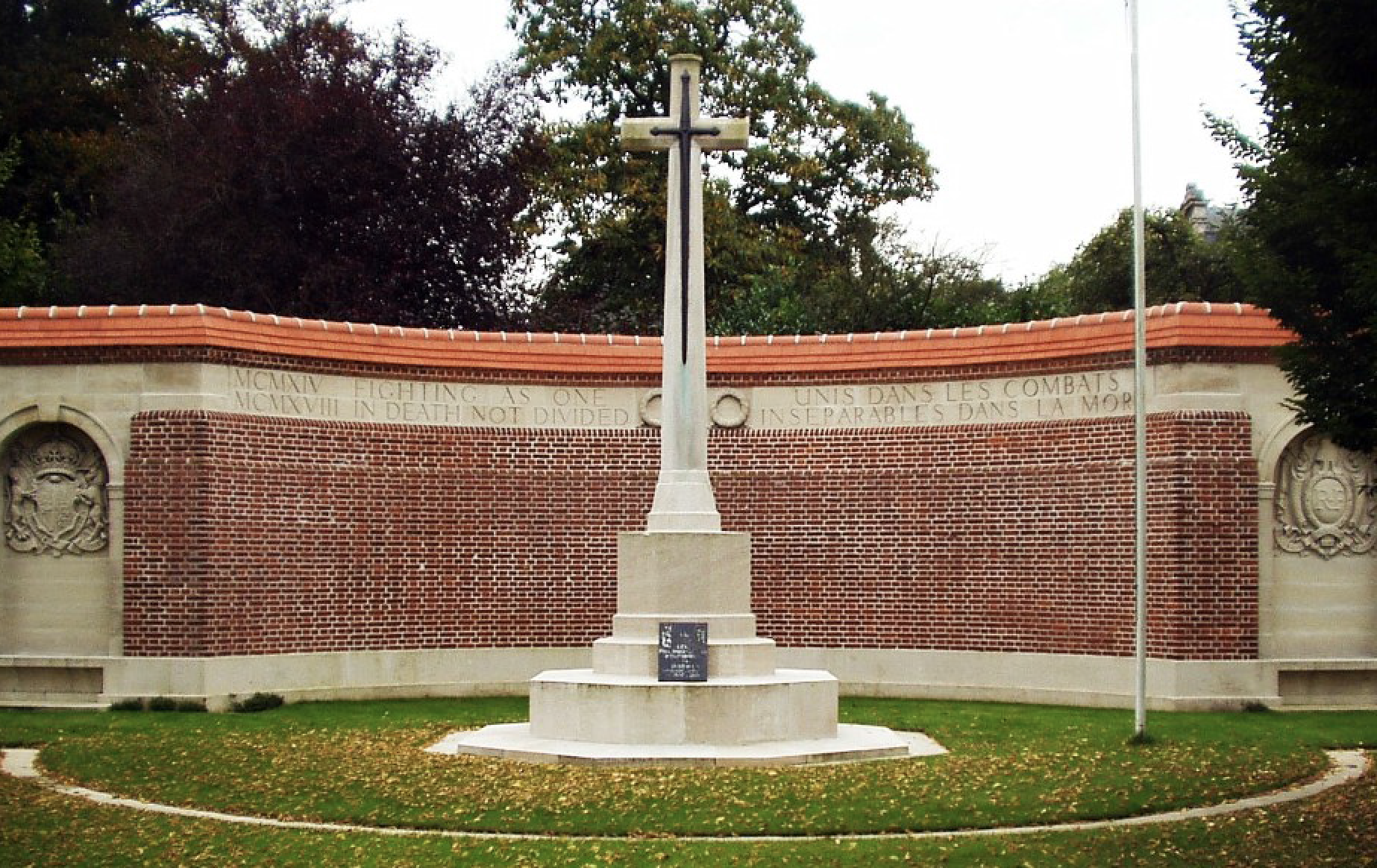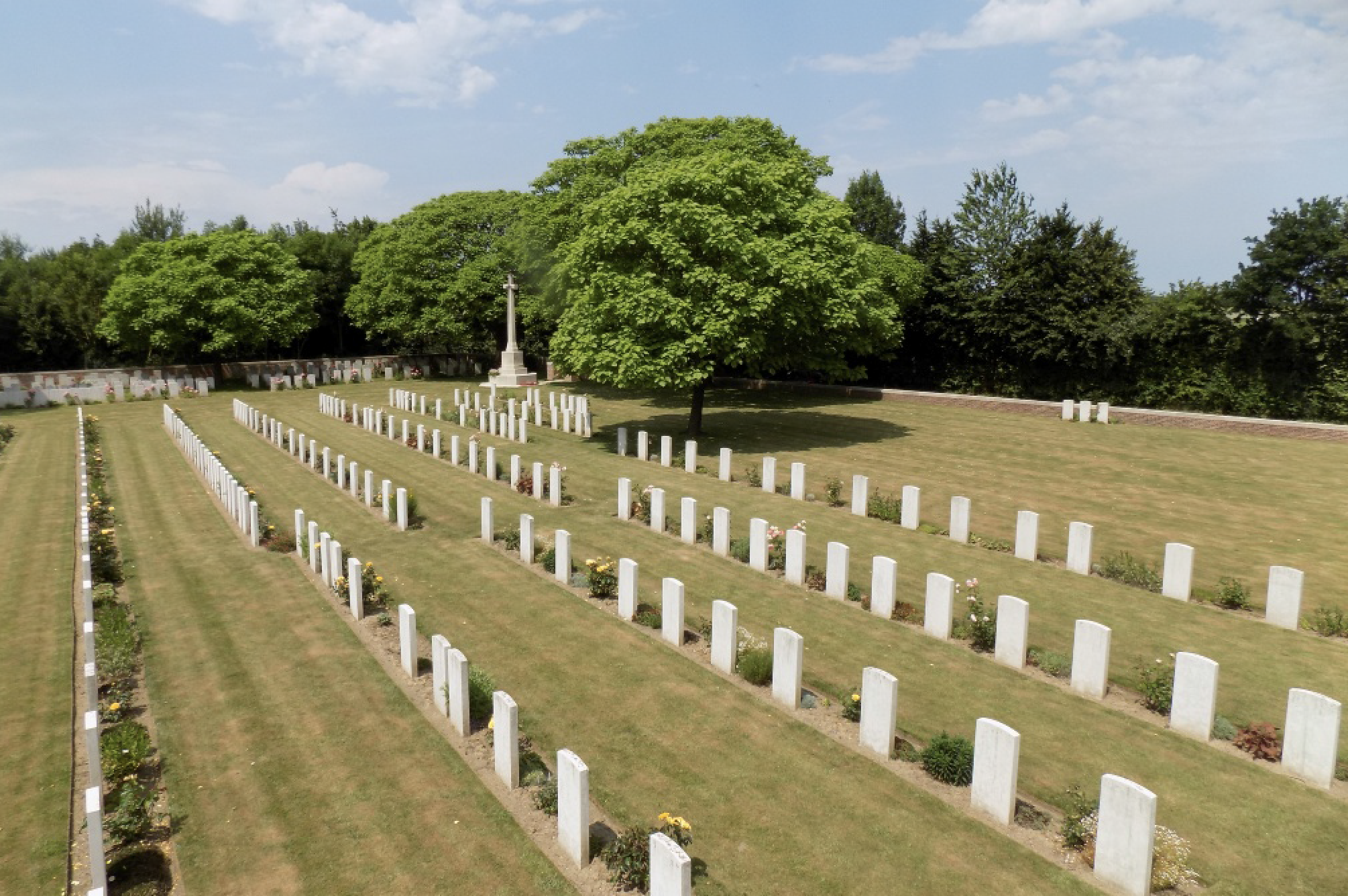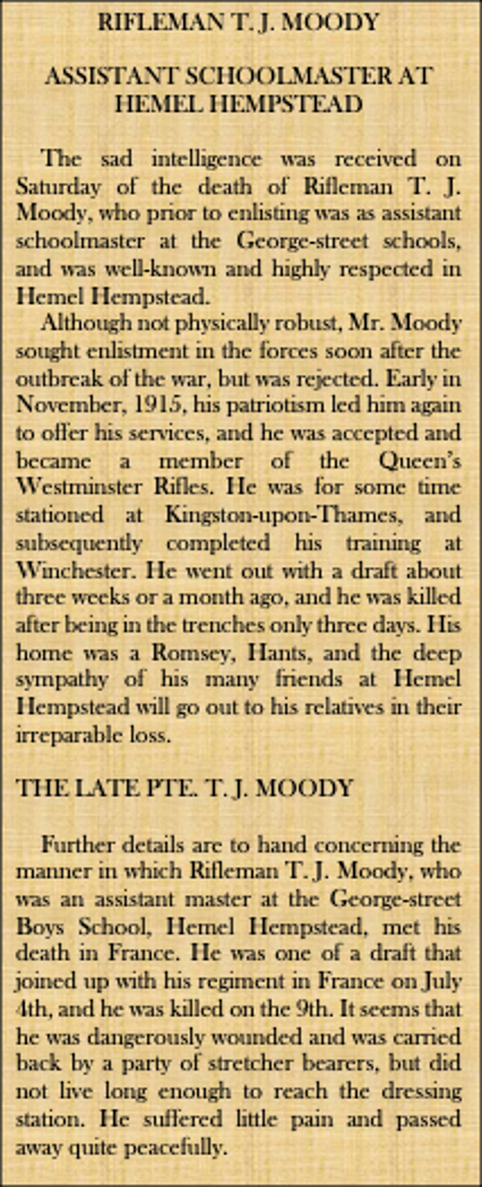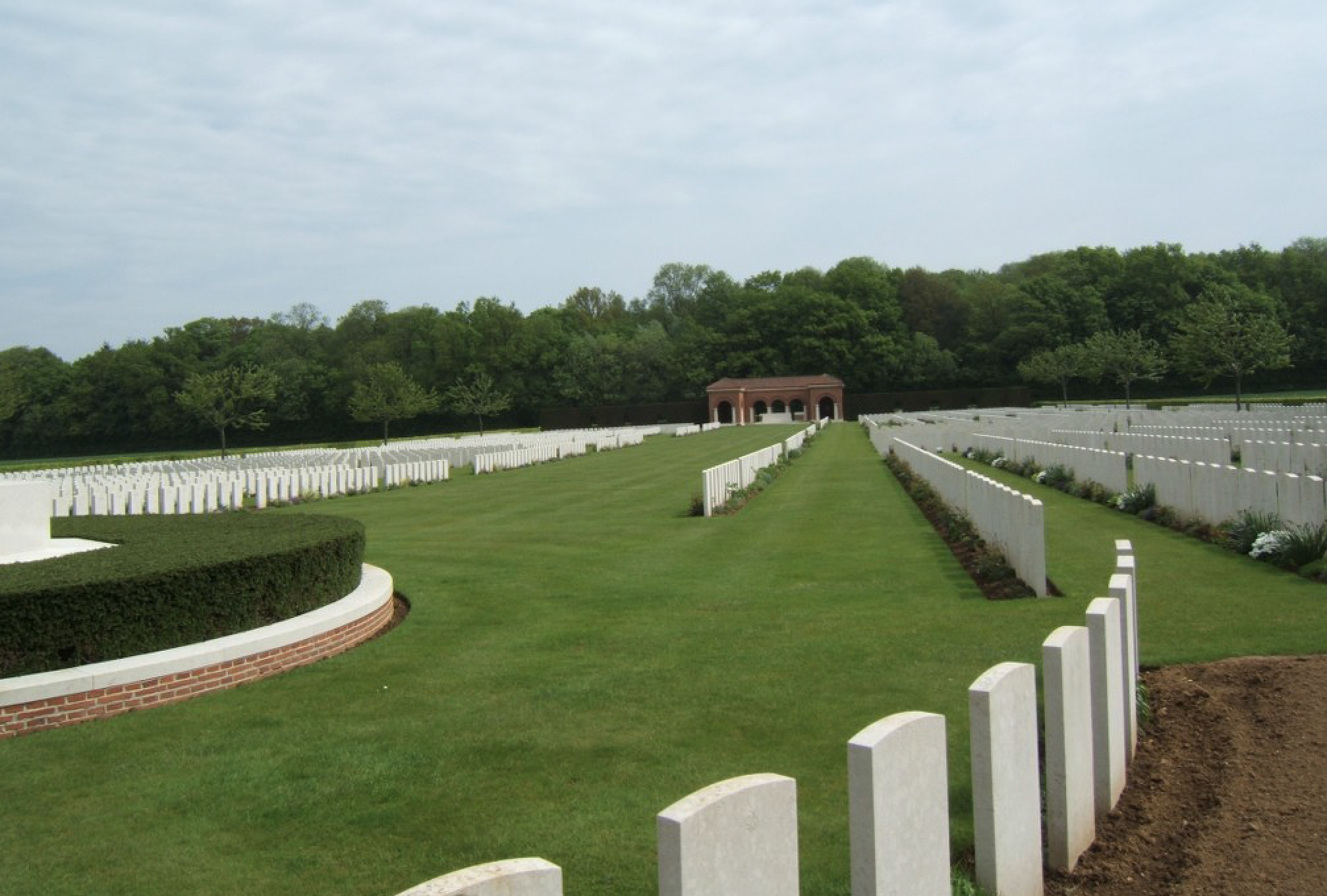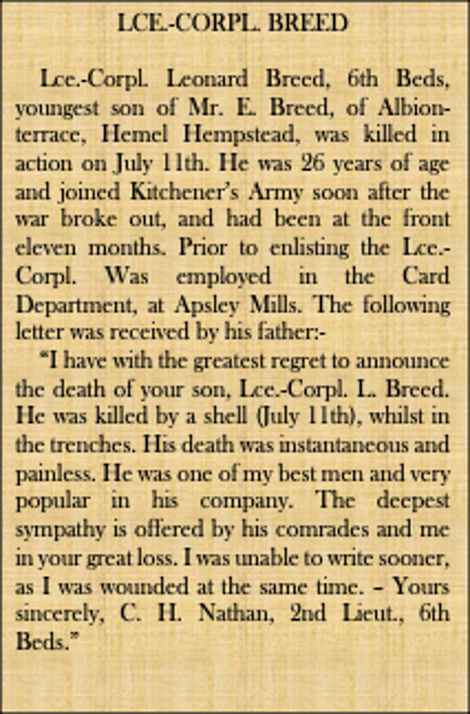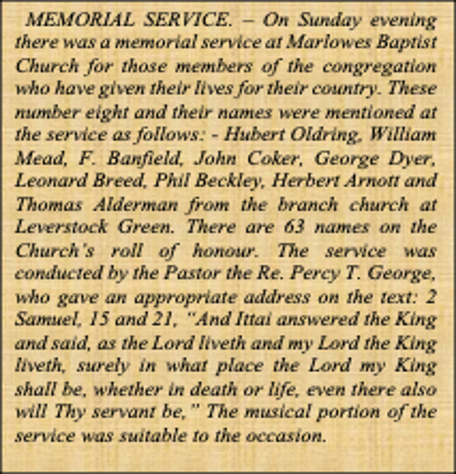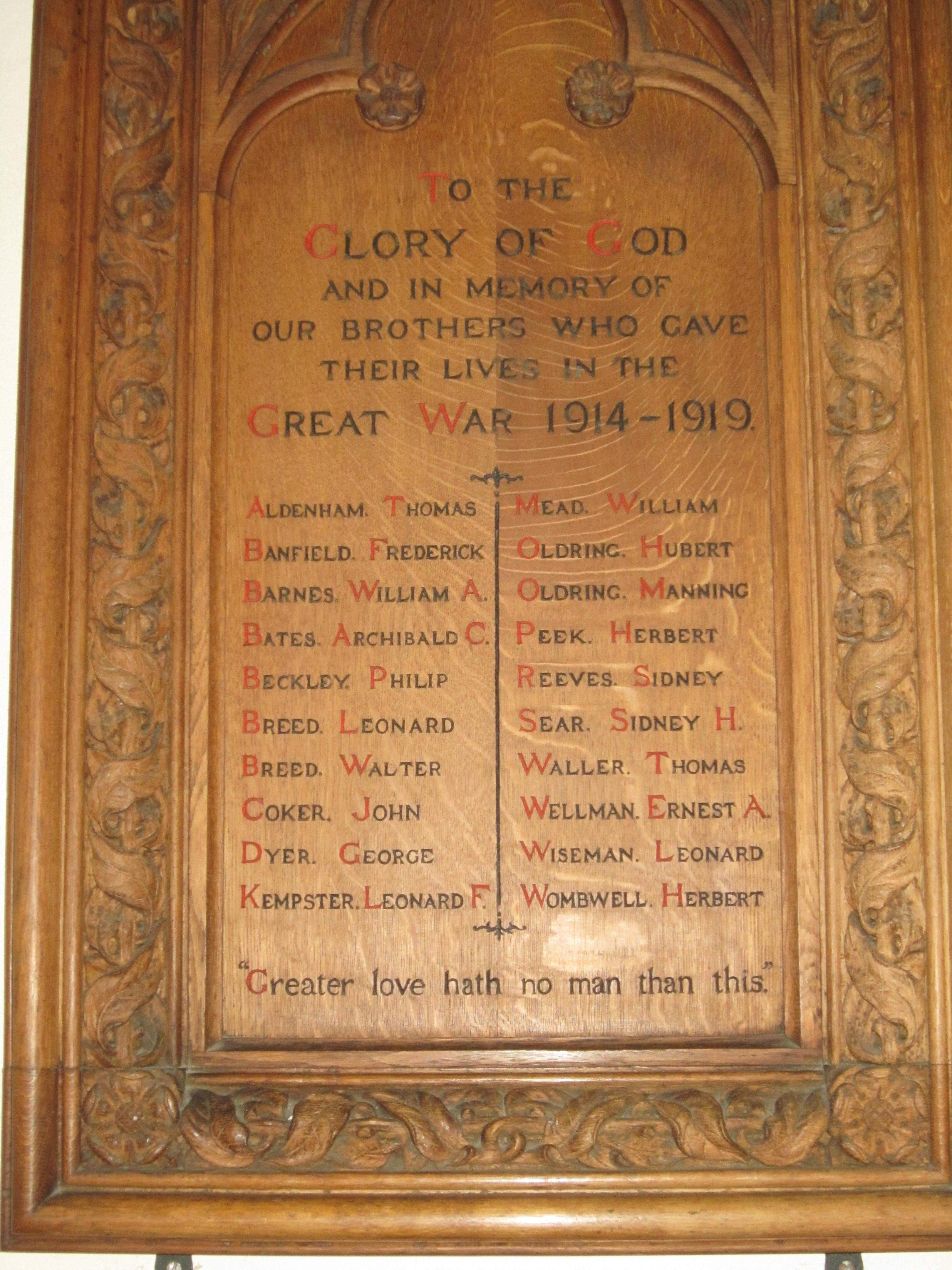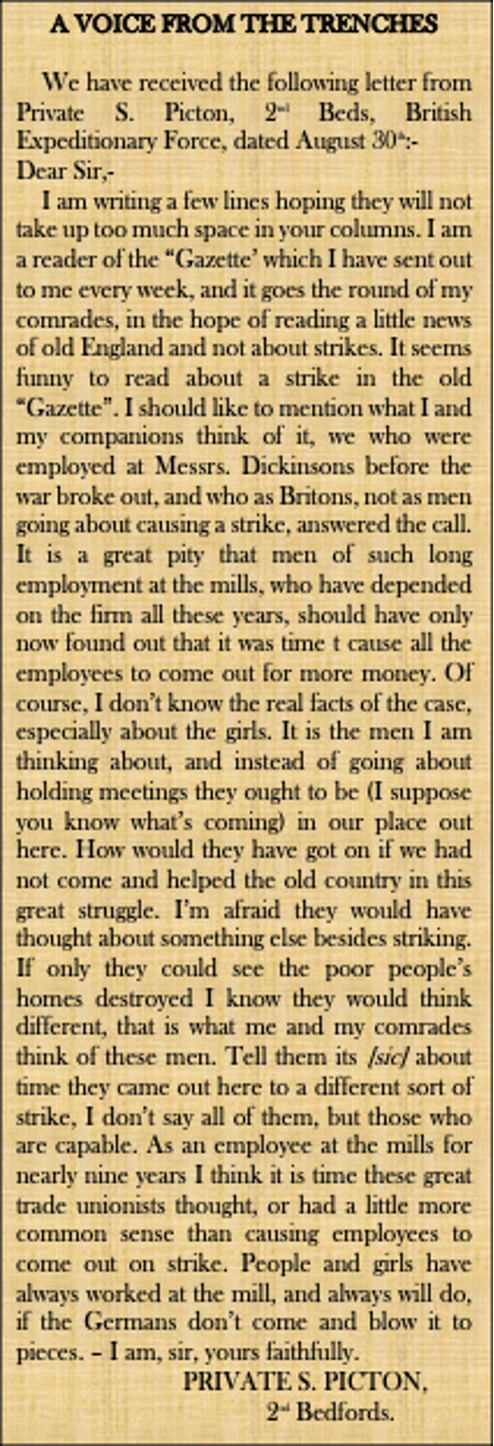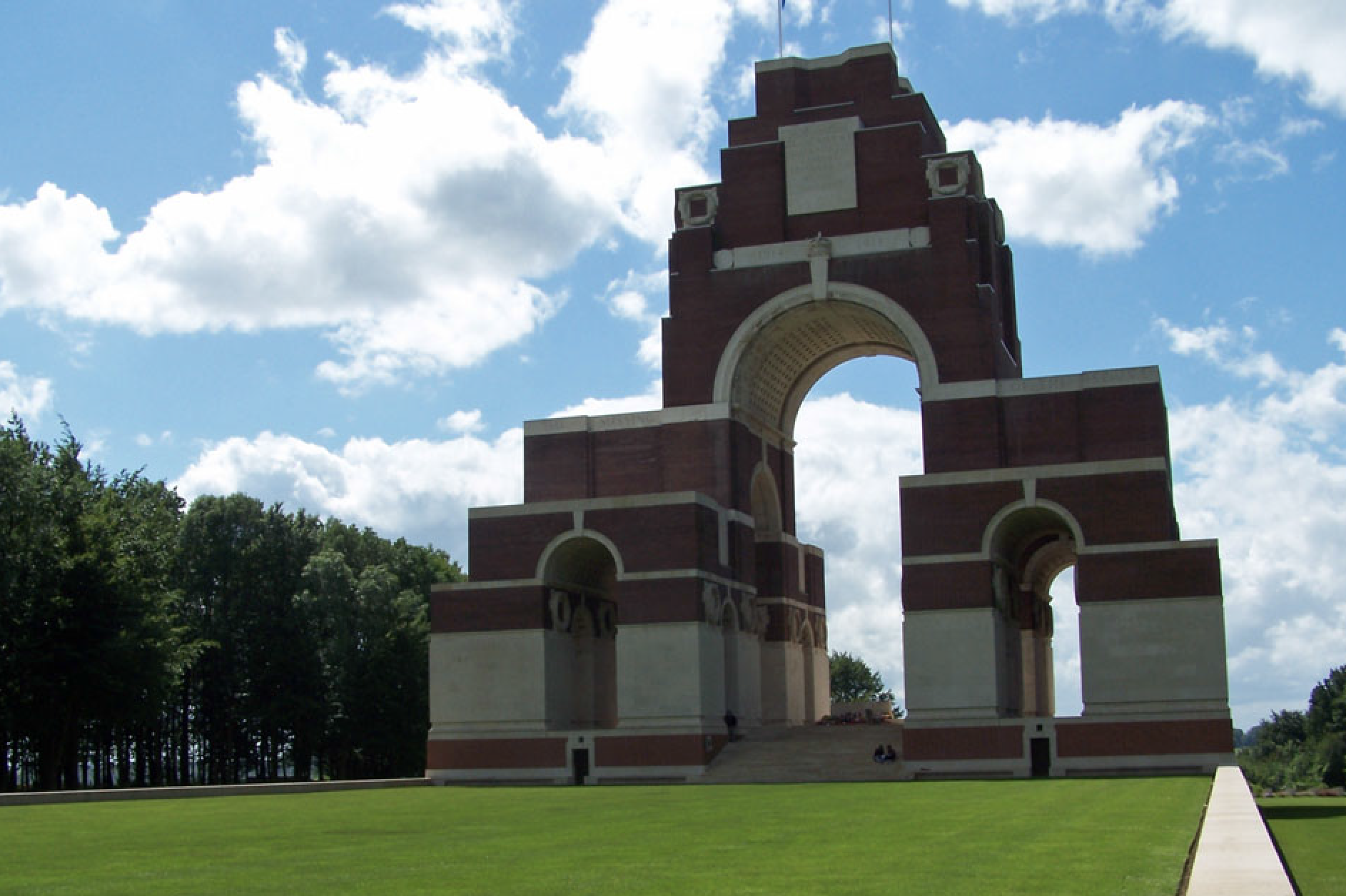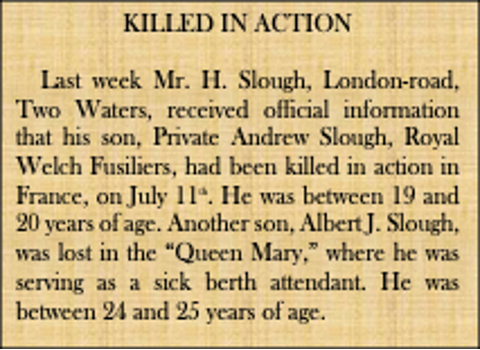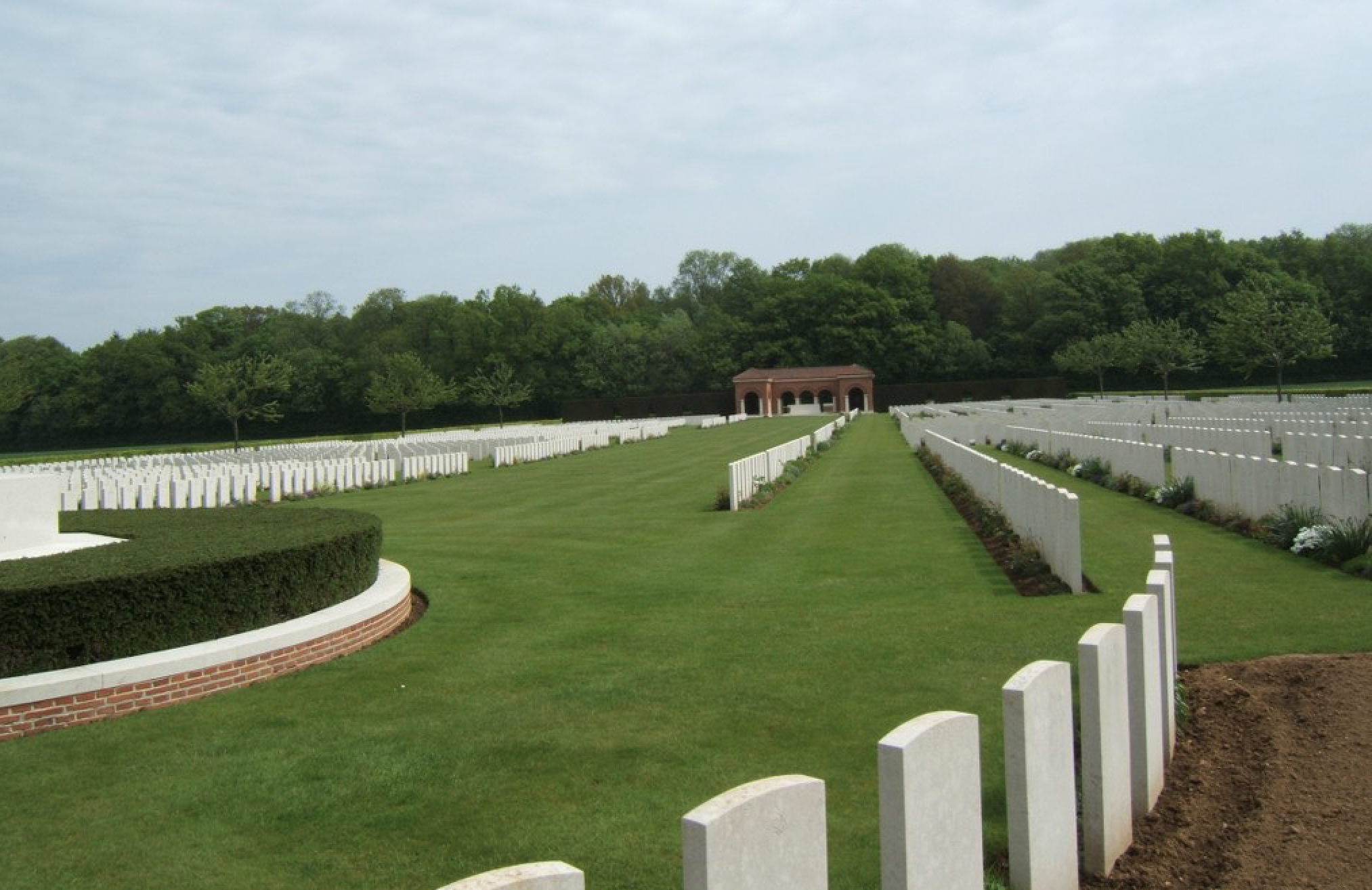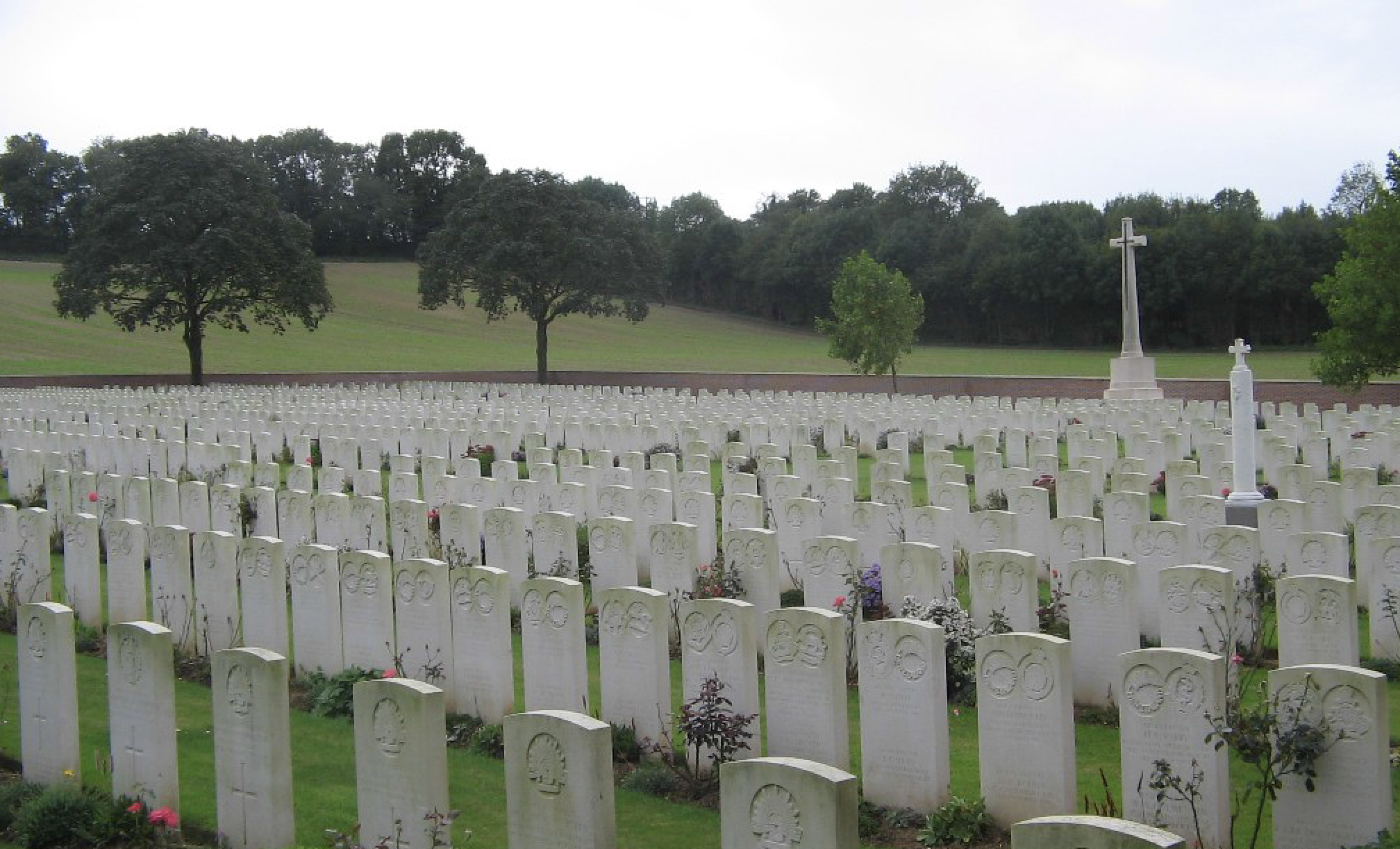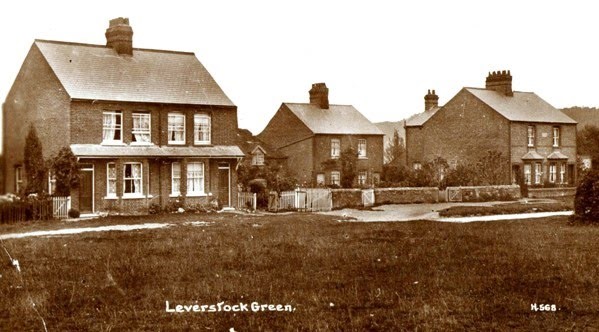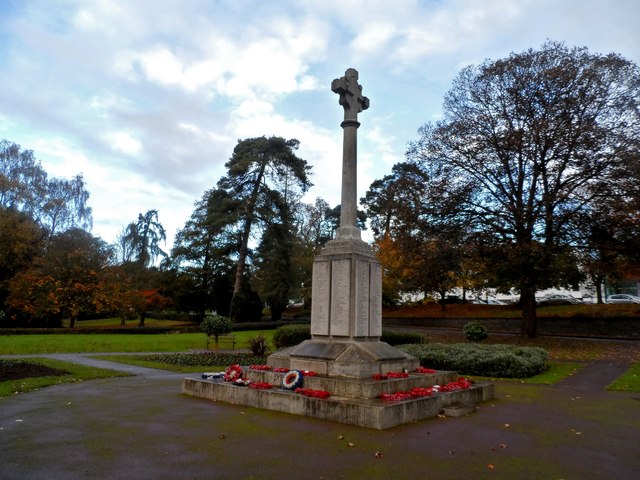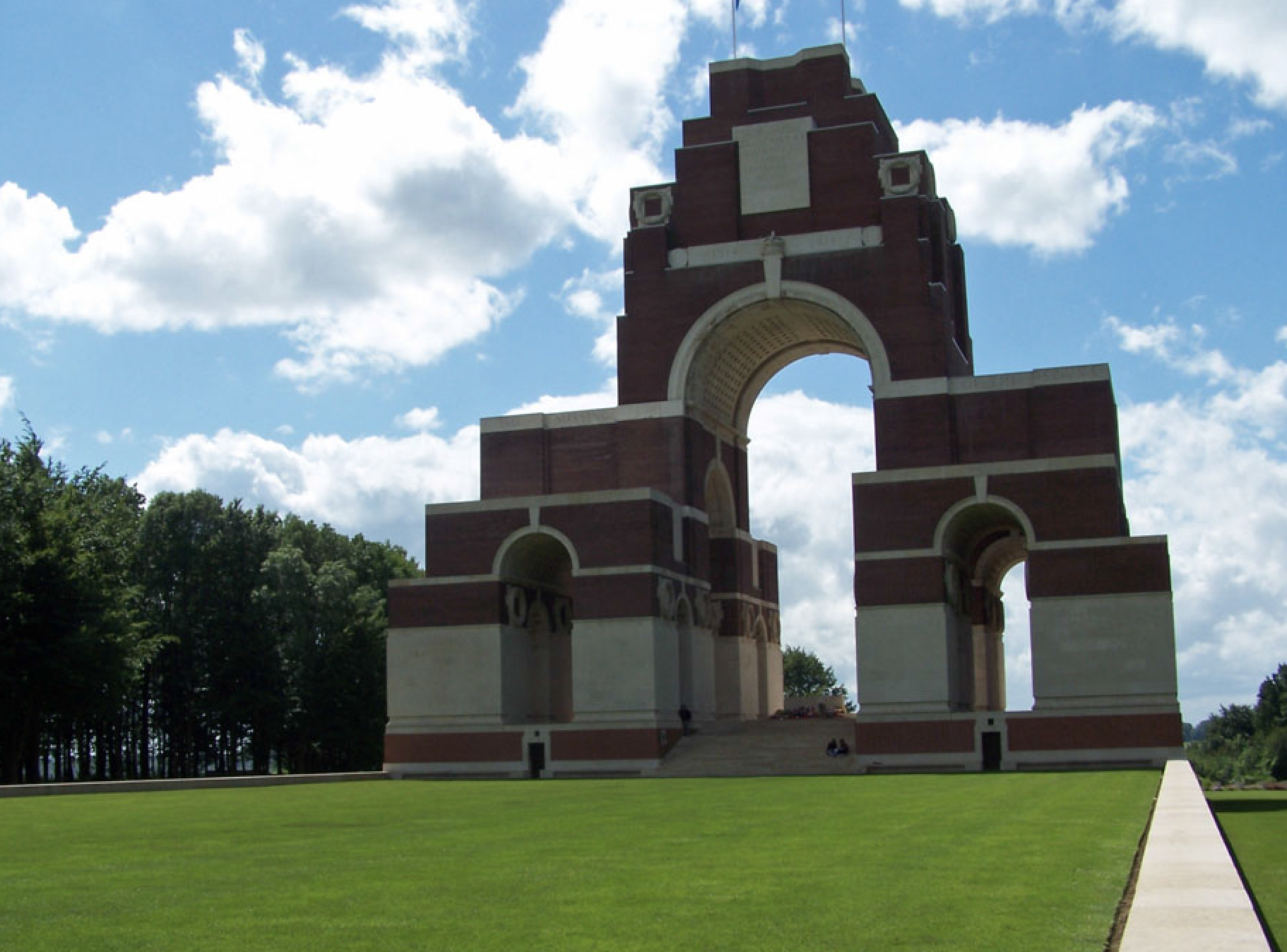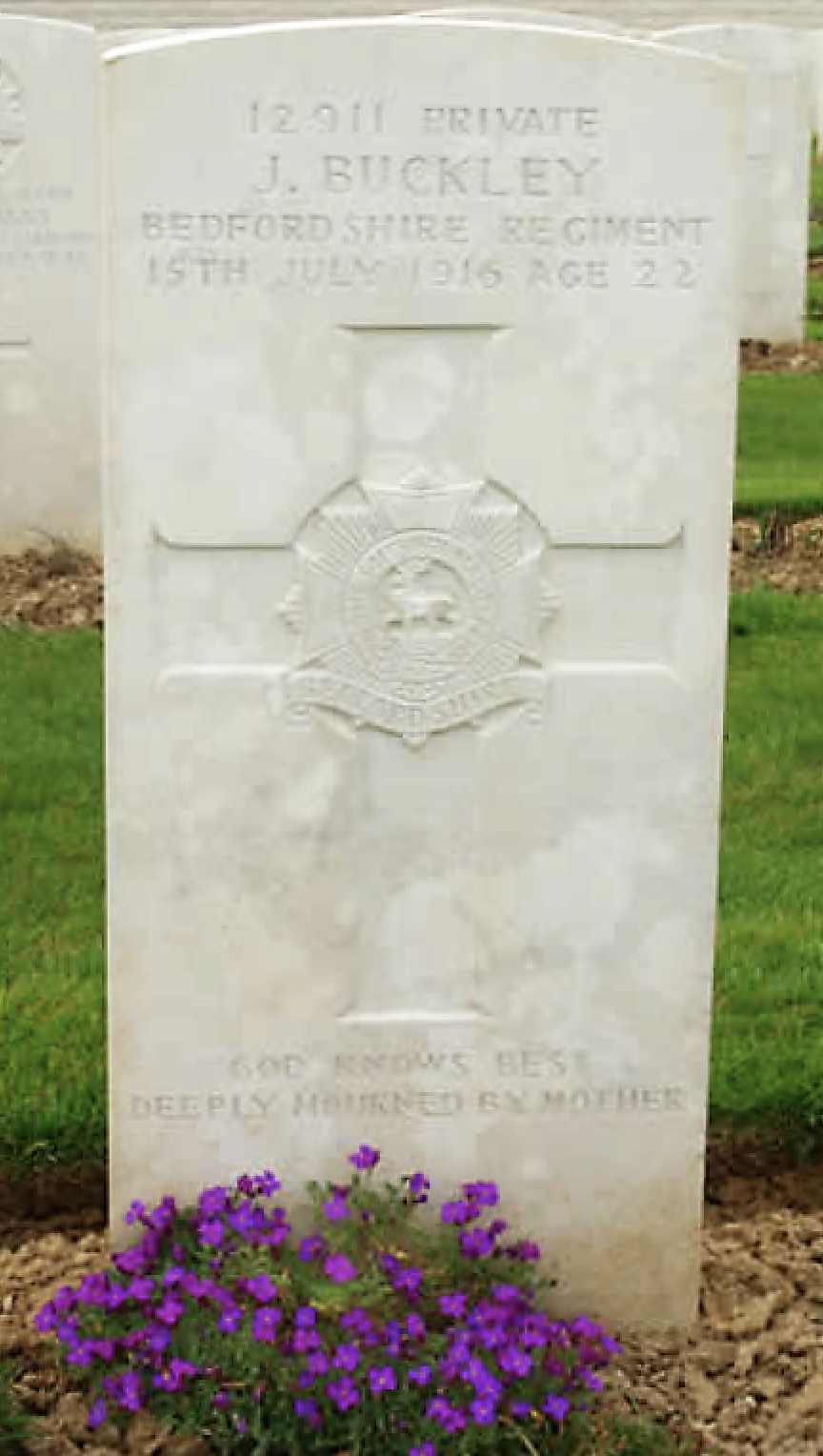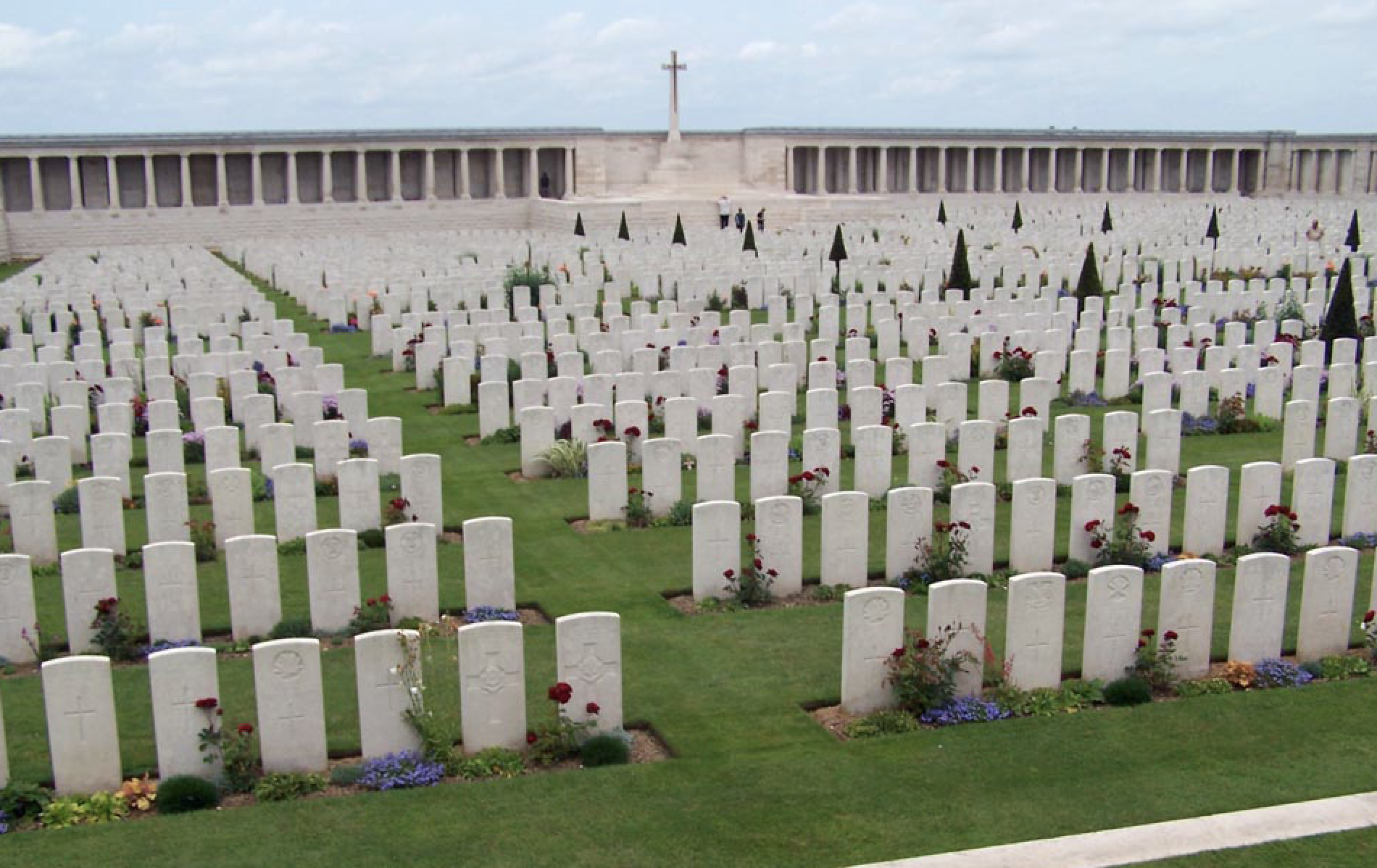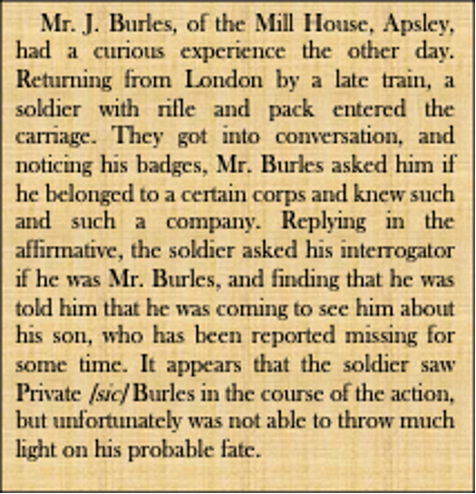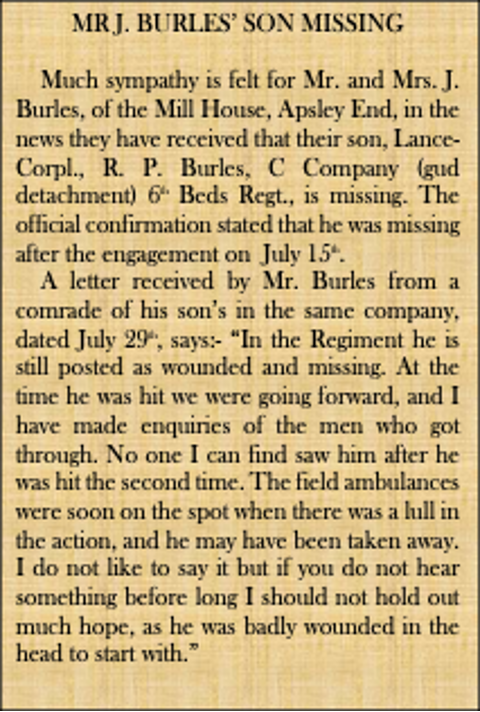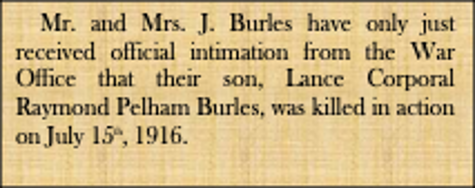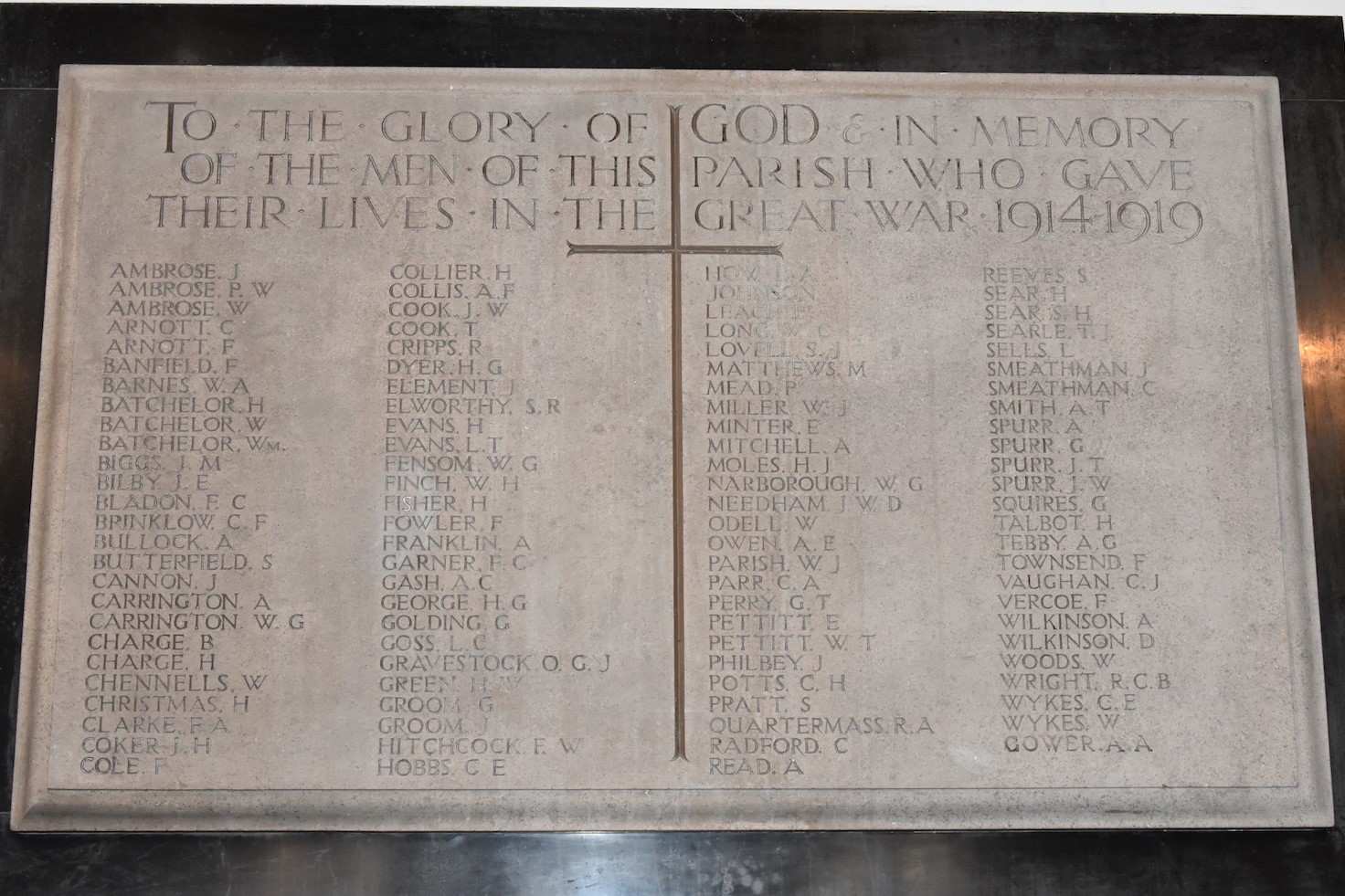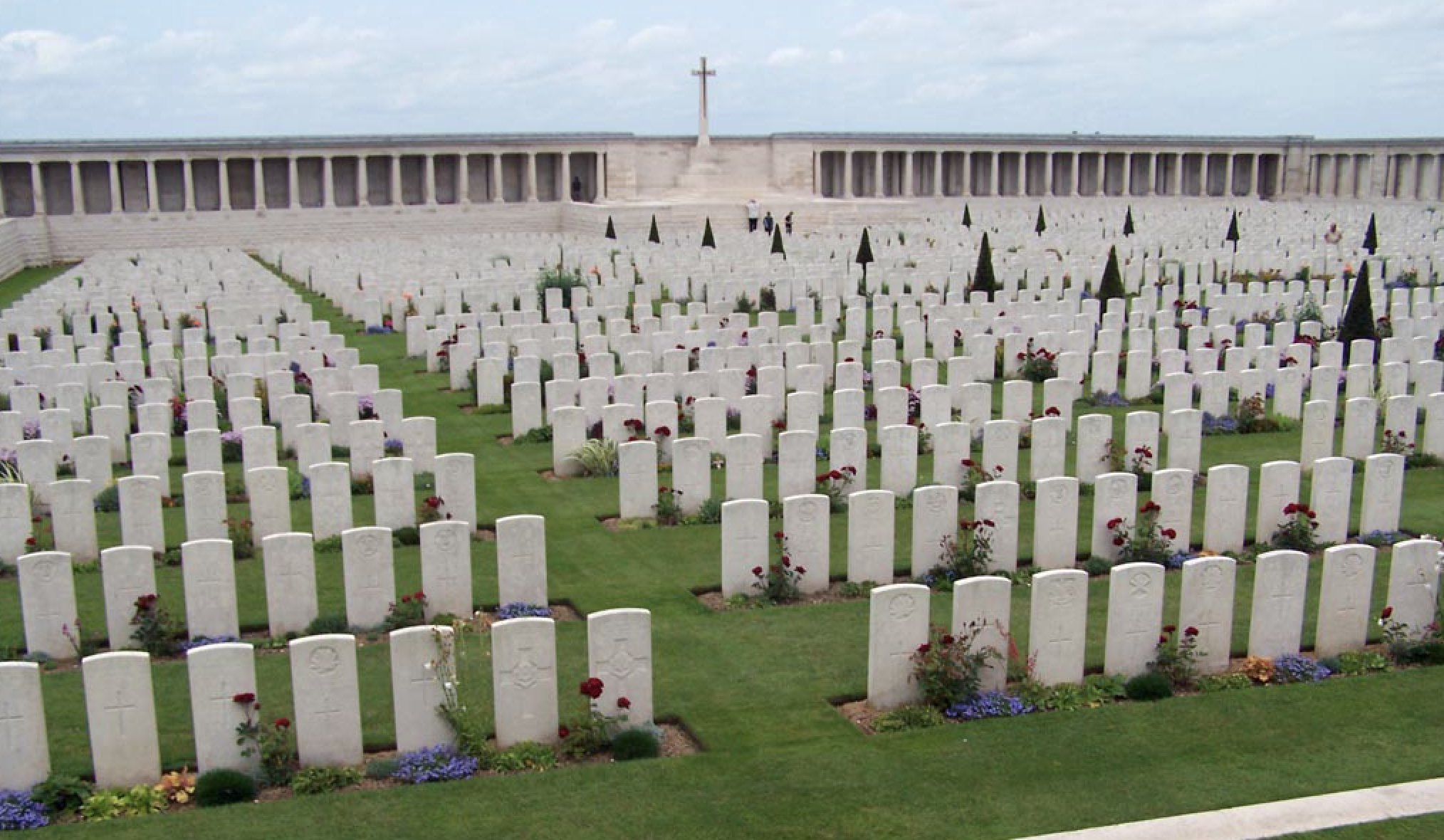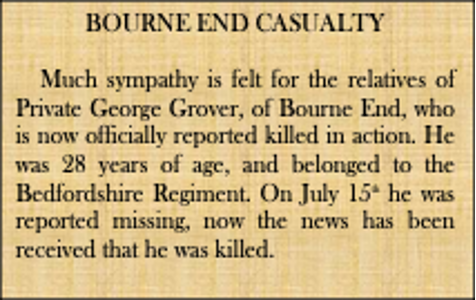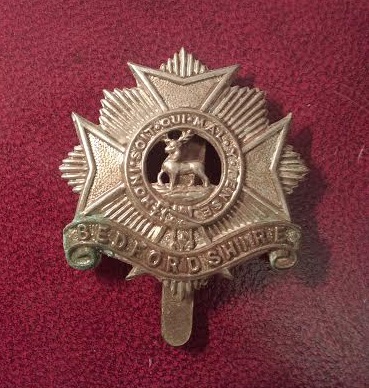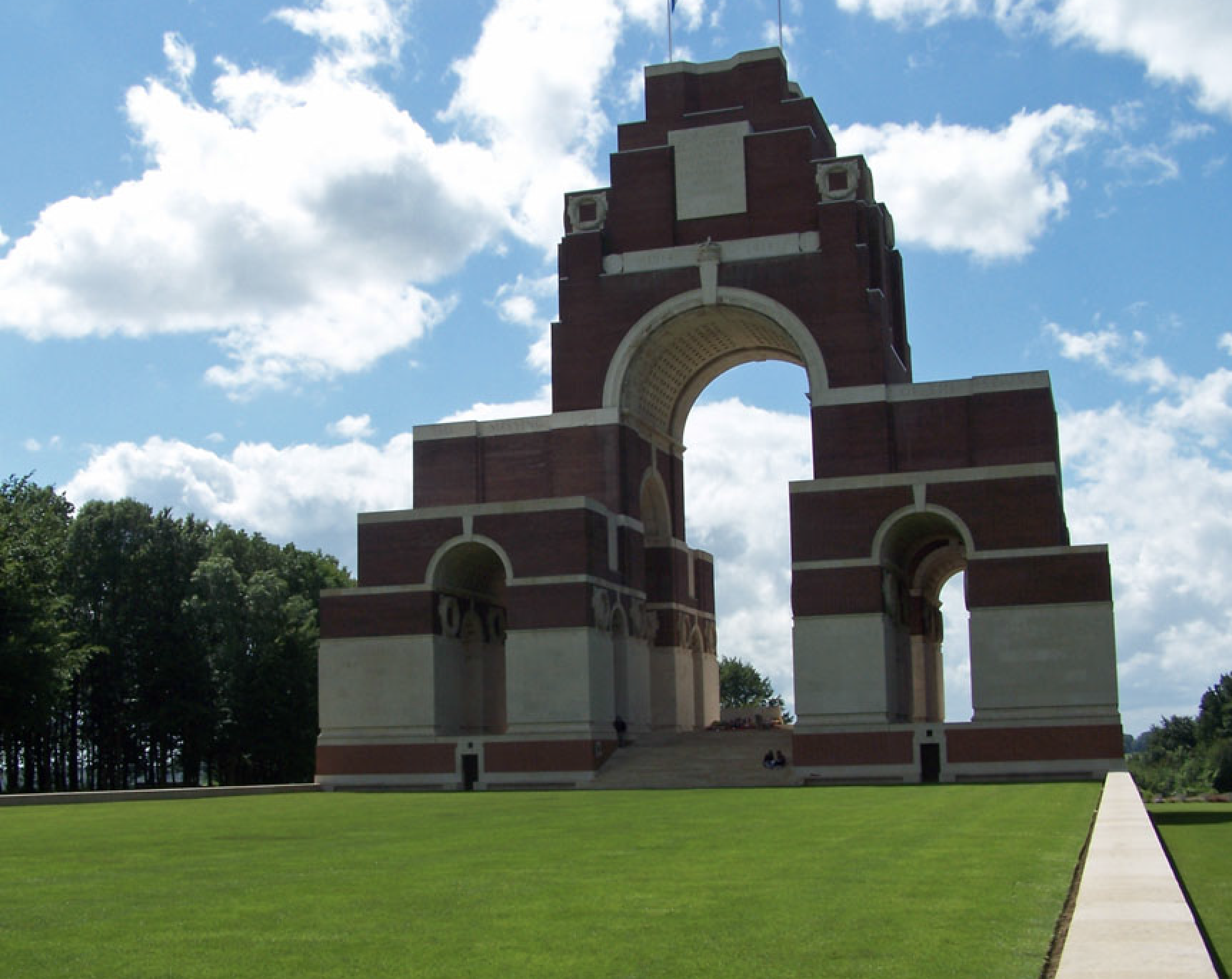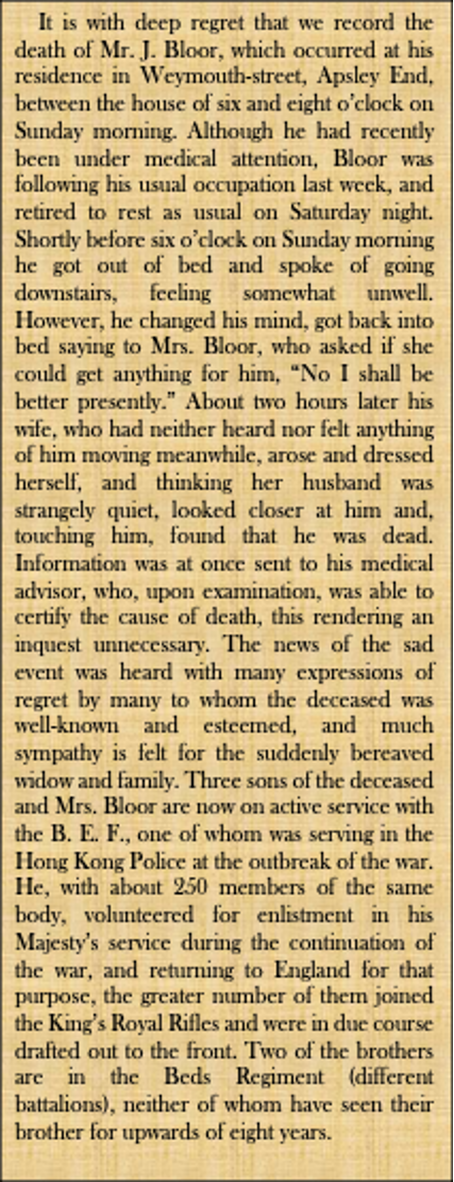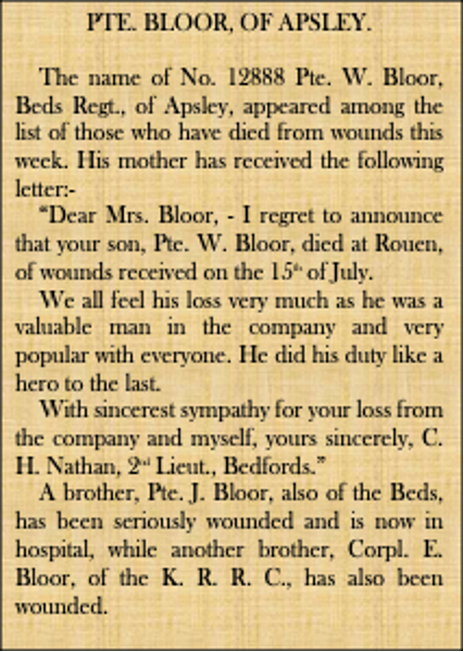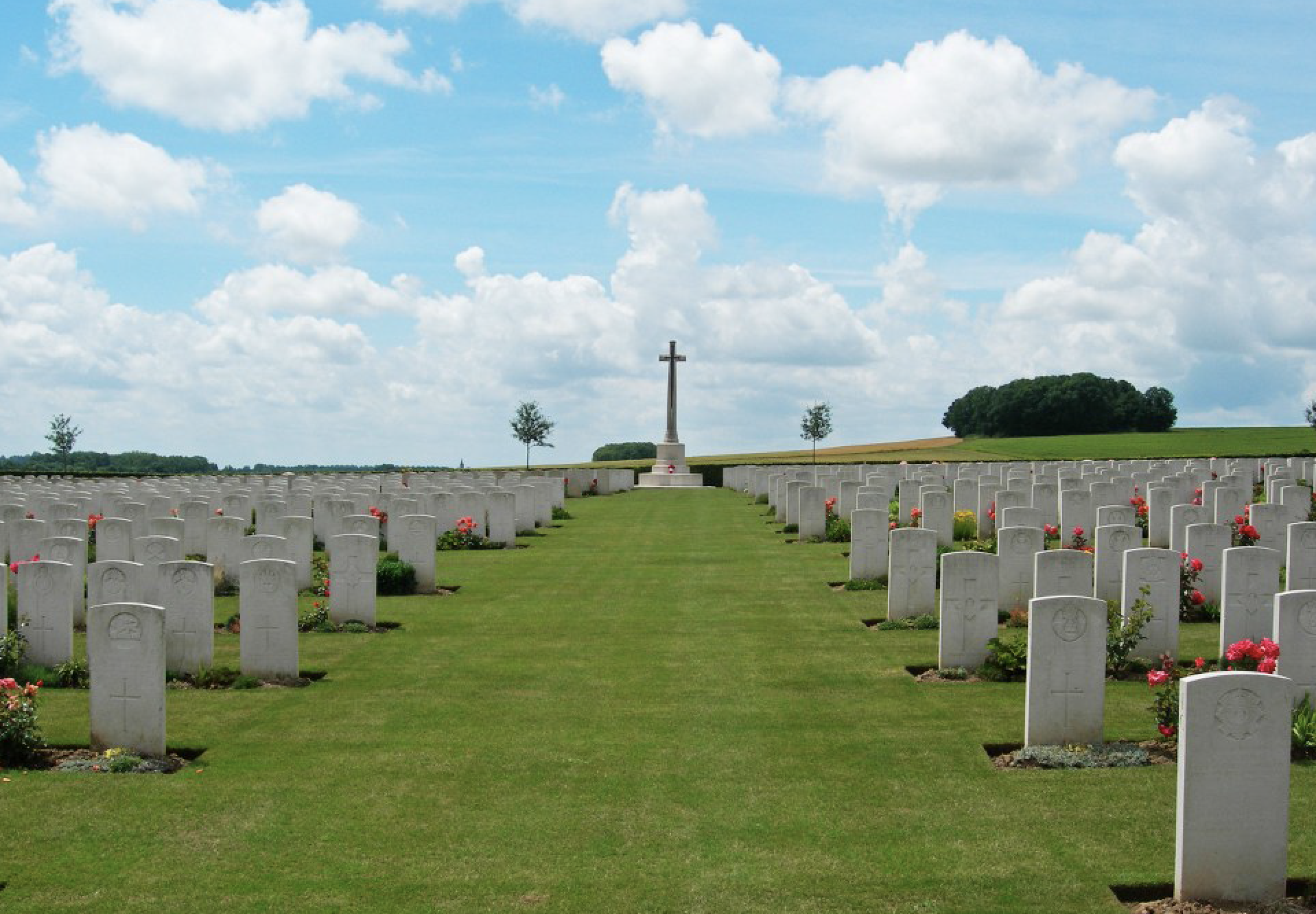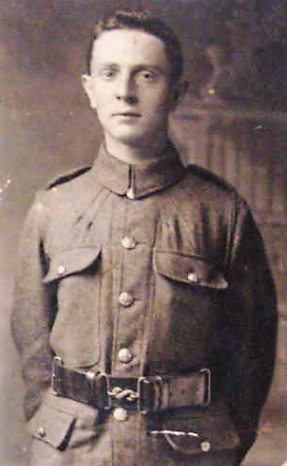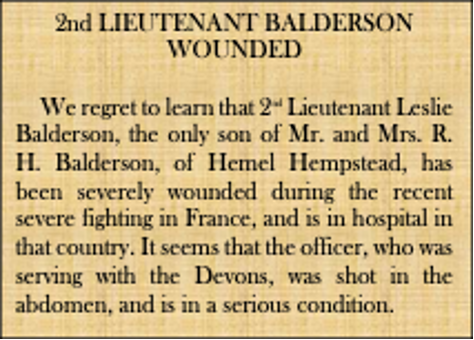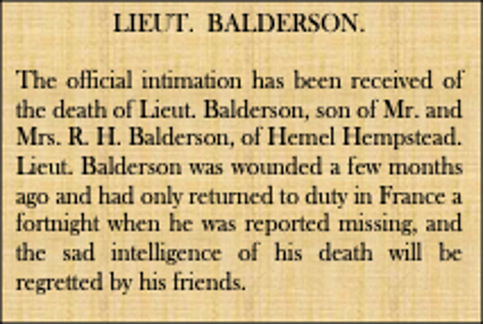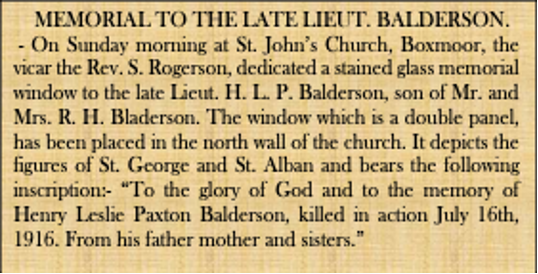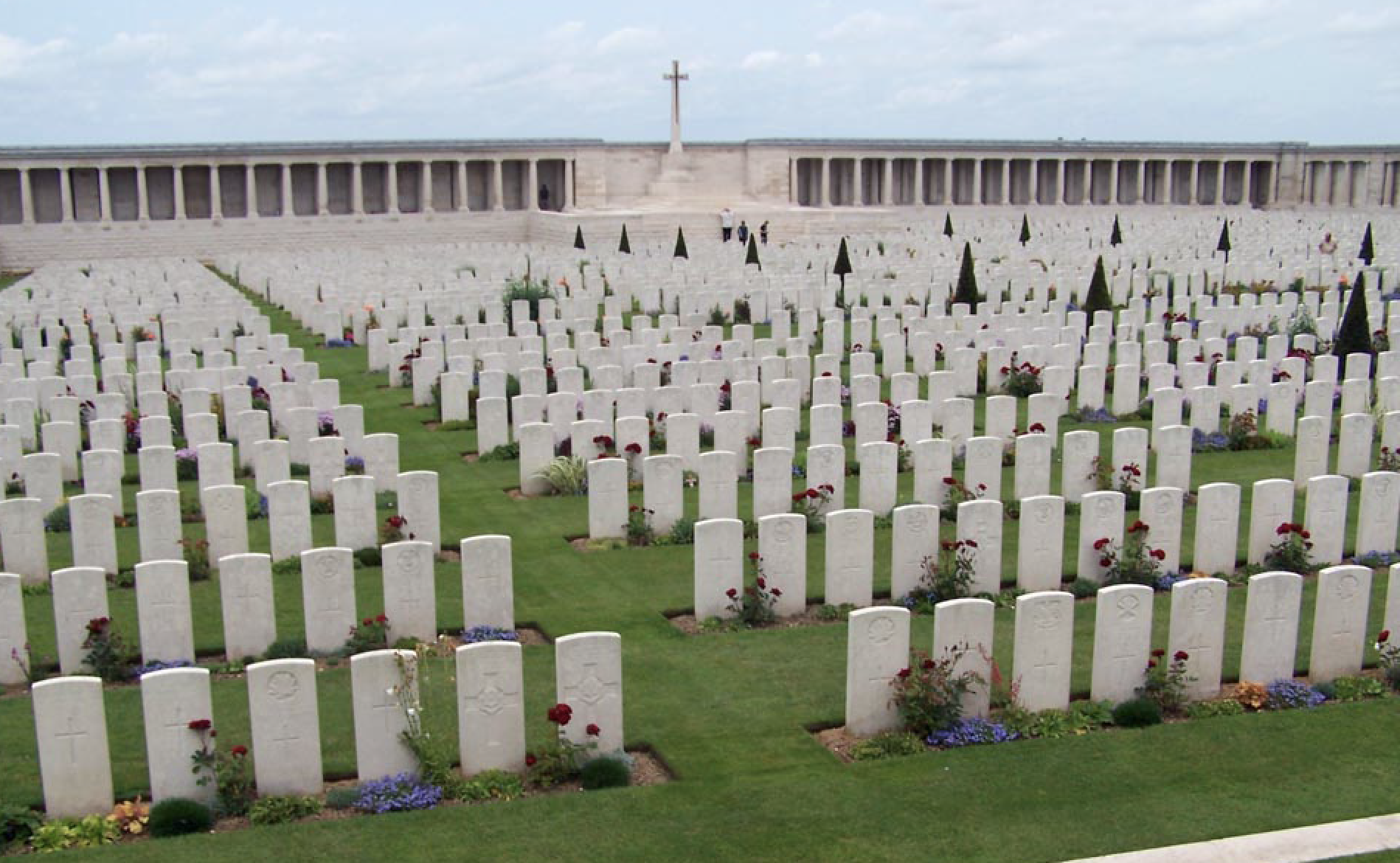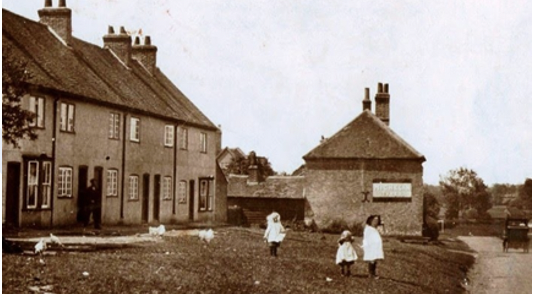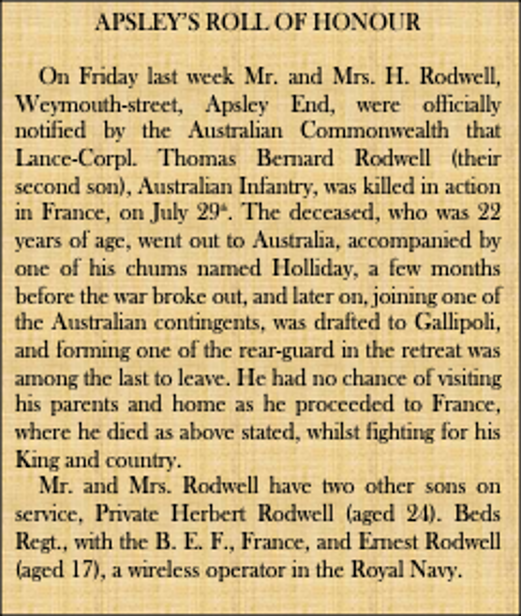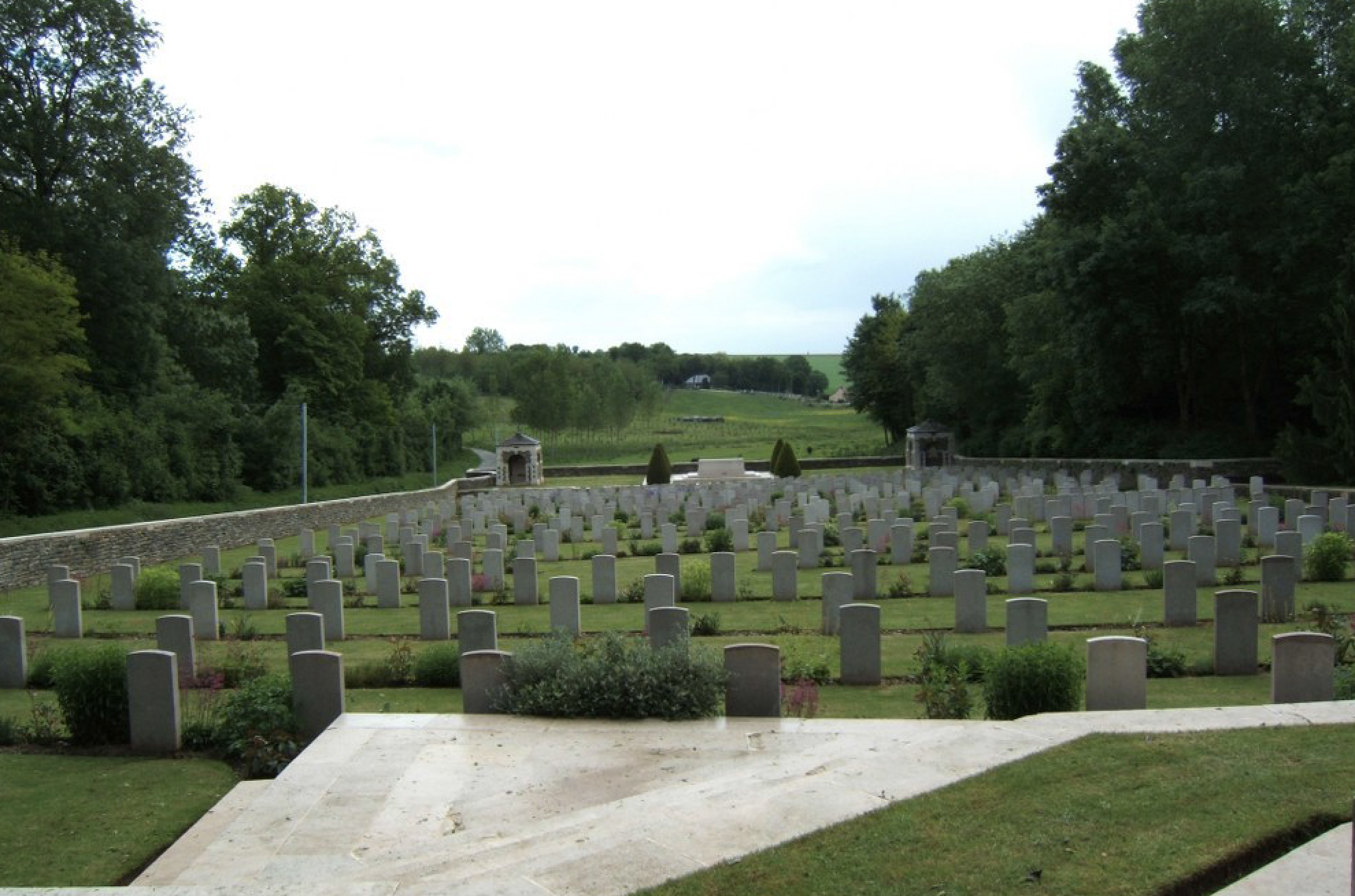Fallen in July 1916:
George Henry Baldwin
George Crawley
Archibald John George
Edward George Goodenough
Robert Chauncey Masterman
Percy McCarthy
Sidney Pratt
Walter William Pigg
Victor Wheldon Williams
Thomas John Moody
Leonard Breed
Stanley Picton
Andrew Slough
Alfred Stone
Harold Woodwards
Percy Mead
John Buckley
Raymond Pelham Burles
John Groom
George Grover
Harold George Gurney
William Bloor
Frederick Field
Walter Ernest Farrow
Robert Shepherd
Henry Leslie Balderson
John Biswell
Bernard Rodwell
GEORGE HENRY BALDWIN
9929 Private
2nd Bn., Devonshire Regiment
Killed in Action Saturday, 1st July 1916
Remembered with Honour, Thiepval Memorial, Somme, France, Pier and Face 1C
George
Henry Baldwin was born on Tuesday, 9th October 1894 in Hemel
Hempstead, Herts the first child of George Baldwin and Sarah Elizabeth Horton.
George had three younger siblings Bert, Elsie and Florence and a half-brother
Ernest Cox. George’s father died in 1907 aged only thirty-six and his mother
married for a second time in 1910 to Ernest Cox from Berkhamsted.
George’s father had been a ‘Blacksmith’s Labourer’ and when George was born, the family lived at ‘Moor Cottages’ in Boxmoor, also informally known as ‘Star Cottages’ on Blackbird’s Moor.
In February
1901 George was at Boxmoor JMI School where he successfully completed Standards
I, II and III before he left on the 4th October 1907 to start work
in a Coal Merchant’s office. His employer was Brentnall & Cleland at 33 St.
John’s Road, Boxmoor but he left only a few years later to start work with G.B.
Kent and Sons at the Frogmore Brushworks. His job at Kents was ‘Tooth Brush
Handle Finisher’.
George was still at G.B. Kent and Sons when war broke out, but he enlisted at Hertford within a week of the declaration, one of the first Hemel Hempstead men to join the Colours and a week before the recruiting office on Marlowes had even opened. He enlisted with the Devonshire Regiment and was posted initially to the 3rd (Reserve) Battalion at Exeter to undergo basic training.
George went
to France three months later disembarking at Le Havre on the 3rd December 1914
and joining the 2nd Battalion Devonshires near Estaires on the 17th December. He arrived just in time to participate in the famous ‘Christmas
Truce’ which the Battalion War Diary recorded as follows: ‘25th Dec. Trenches: Informal armistice during day light
[Germans got out of their trenches and came towards our lines. Our men met them
and they wished each other a Merry Xmas, shook hands, exchanged smokes etc.].
About 7.30pm sniping began again. We had one man killed and one wounded. Hard
Frost’
The Christmas truce (which was unofficial) occurred during an early period of the war. Leading up to Christmas Day, French, German, and British soldiers crossed trenches to exchange seasonal greetings and talk. In some areas, men from both sides ventured into no man's land on Christmas Eve and Christmas Day to mingle and exchange food and souvenirs. There were joint burial ceremonies and prisoner swaps, while several meetings ended in carol-singing. Men played games of football with one another, giving one of the most memorable images of the truce. Peaceful behaviour was not ubiquitous however and fighting continued in some sectors, while in others the sides settled on little more than arrangements to recover bodies.
In 1915 George saw action at the following engagements; the Battle of Neuve Chapelle in March, the Battle of Aubers Ridge in May and the action of Bois Grenier, a diversionary attack coinciding with the Battle of Loos in September.
By late June 1916 the 2nd Devons were at Long Valley, Albert for the preparatory stages of the Battle of Albert, the first phase of the infamous Battle of the Somme. The initial British artillery bombardment of the German lines began on the 24th June and continued for seven days.
On the 1st July 1916 the 2nd Devons attacked Pozieres. A report attached to the Battalion War Diaries describes how initially, the advance towards the German lines was carried out in “the most perfect order” and got within 100 yards of the enemy trenches. However, when the final assault started at 7.30am the advancing troops were met with “a terrific machine gun fire from the front and from both flanks, which mowed down our troops”. In this mayhem confusion reigned and the report records that “No accurate information could be ascertained as to the exact number of casualties the Battalion had suffered, although it was clear that there were very few left who had not been hit.”
By noon on the first day when the advance was called off, the Battalion had suffered 238 casualties in a little over two hours. In all, on the first day of the Battle, the British suffered an horrific 57, 470 casualties and would lose another 25,000 men in the next twelve days.
George was a victim of the initial carnage and died on Saturday, 1st July 1916
His death
was reported in the Hemel Gazette and a brief letter from one of his comrades
was published in the paper in August 1916. (see extract)
George is Remembered with Honour on Thiepval Memorial, Somme, France, Pier and Face 1C
He was 21 years old when he died.
George was eligible for the 1914-15 Star, the British War Medal and the Allied Victory Medal.
Pte. George Henry Baldwin c1914 (Courtesy: The Hertfordshire, Hemel Hempstead Gazette and West Herts Advertiser)
G.B. Kent and Sons Ltd., Apsley where George worked (Public Domain)
1914 Christmas Truce Daily Mirror 8th Jan. 1915 (Courtesy: Daily Mirror)
Extract from The Hertfordshire, Hemel Hempstead Gazette and West Herts Advertiser 19th Aug. 1916
Thiepval Memorial, Somme, France (Courtesy: CWGC)
GEORGE CRAWLEY
16063 Corporal
9th Bn., Devonshire Regiment
Killed in Action Saturday, 1st July 1916
Remembered with Honour, Devonshire Cemetery, Mametz, Somme, France, Plot A. 4.
George Crawley was born in Boxmoor, Herts on Monday, 1st June 1891 the eighth child born to Daniel Crawley and Annie Birch. Daniel and Annie had a total of eleven children who were; Annie Elizabeth, Alice Mary, Herbert William, Daniel, Florence Louisa, Percy Dean, Alfred, Lily, George, Montague and Harold. Lily died in infancy in 1889 and Alfred died in 1902 aged sixteen. George’s brother Montague fought and died in the Great War in September 1918 and his biography also appears in this book.
The Crawley family lived at 9 Cowper Road in Boxmoor for more than fifty years and when George was born his father was working at Foster’s Saw Mills on Kingsland Road.
In 1901 George was at Boxmoor JMI School where he successfully complete five of the six Standards expected before leaving in June 1904 to start work with Dickinson & Co. Limited at Apsley Mills. He worked at Dickinsons for only a couple of years before moving to Islington in London to start work in the Drapery trade.
By 1911 he was boarding at the home of Frederick Taylor on Shepperton Road, Islington and working as a Packer in a Drapery store. It was here that he met his wife Isabella Green, Frederick Taylor’s niece who was also living at her Uncle’s house. George and Isabella were married at St Saviour’s Church, Hoxton in London on Sunday, 26th May 1912 in a ceremony witnessed by George’s youngest brother Harold and Isabella’s sister, Elizabeth. George and Isabella had one child, a son named Alfred Montague born in Hemel Hempstead on the 4th July 1914 just two months before the war broke out.
George
enlisted with the Devonshire Regiment attesting in London in August 1914 and
was then posted to the 9th (Service) Battalion at Rushmore, near
Aldershot for his basic training. The Battalion went to France in 1915 and
disembarked in Le Havre on the 28th July as part of the 20th Brigade in the 7th Division.
George saw action at the Battle of Loos in September 1915 before moving with the 9th Battalion to Fricourt near Albert where he celebrated his twenty-fifth birthday in the trenches. Towards the end of June 1916, the Battalion prepared for an assault on the German positions in what was the Battle of Albert. As the first phase of the Battle of the Somme, Albert proved to be particularly bloody and the British suffered over 80,000 casualties over the first thirteen days of July.
George was a casualty on the first day when he was Killed in Action during the initial advance on Saturday, 1st July 1916.
His death
was reported in the Hemel Gazette when a letter to his parents from the
Battalion Chaplain was published in August. (see extract)
George is Remembered
with Honour in Devonshire Cemetery, Mametz, Somme, France, where he is interred in Plot A. 4.
He was 25 years old when he died. George was eligible for the 1914-15 Star, the Britosh War Medal and the Allied Victory Medal.
Extract from the Hertfordshire, Hemel Hempstead Gazette and West Herts Advertiser 19th Aug. 1916
Devonshire Cemetery, Mametz, Somme, France (Courtesy: CWGC)
ARCHIBALD JOHN GEORGE
3005 Private
8th Bn., East Surrey Regiment
Killed in Action Saturday, 1st July 1916
Remembered with Honour, Thiepval Memorial, Somme, France, Pier and Face 6B
John Archibald
George, known as Archie, was born on Wednesday, 28th February 1894
in Apsley End, Hertfordshire and baptised the following month on Sunday, 25th March at St Mary’s Church. His parents were William George and Ellen Putman who
had twelve children in all, four of whom died. The known children were; Louisa,
Minnie, Kate, William Charles ‘Charlie’, Alice, Violet, John Archibald
‘Archie’, Annie, Henry and Harold. Louisa died in 1914 aged thirty-three, Annie and Henry
both died in infancy in 1896 and 97 respectively.
Archie’s family lived at 46 Weymouth Street, Apsley End when he was born and his father was a ‘Road Worker’ whilst four of his older siblings worked for Dickinson & Co. Limited in Apsley Mills.
By the time
he was seventeen, the family had moved to 3 Catlin Street, Apsley End and
Archie was working as a ‘Farm Labourer’. He would later work for Herts County
Council.
On the outbreak of war Archie enlisted with the East Surrey Regiment, attesting at Watford in October 1914. He was posted to the 11th (Service) Battalion at Devonport to undergo basic training. He moved with the Battalion to Dartmouth in December and in April 1915 the 11th became a ‘Reserve’ battalion and moved to Colchester.
George completed his training there and was posted to the 8th East Surreys which came under orders of the 55th Brigade in the 18th (Eastern) Division. He left for France landing at Boulogne on the 25th August 1915 and joining his comrades at Dernancourt on the 29th August. Between September and the following June Archie saw action in the trenches just south of Albert. In common with most other units during this time the 8th Battalion did not move very far and it stayed no more than a few miles from Albert and by late June it was in position for the planned assault at the beginning of July 1916.
The Battle of Albert began on Saturday, 1st July 1916 and the 8th Battalion East Surreys were tasked to capture Montauban Ridge. The initial assault is remembered particularly for the actions of Captain W. P. ‘Billie’ Nevill of ‘B’ Company and what became known as the “Football Charge”. The story was widely reported in the press within days of the attack, telling how Captain Nevill provided four footballs for his platoons to kick across No Man’s Land as they advanced and capturing the imagination of the British public.
“The captain of one of the companies had provided four footballs, one for each platoon, urging them to keep up a dribbling competition all the way over the mile and a quarter of ground they had to traverse. As the company formed on emerging from the trench, the platoon commanders kicked off, and the match against Death commenced. The gallant captain himself fell early in the charge, and men began to drop rapidly under the hail of machine-gun bullets. But still the footballs were booted onwards, with hoarse cries of encouragement or defiance, until they disappeared in the dense smother behind which the Germans were shooting. Then, when the bombs and bayonets had done their work, and the enemy had cleared out, the Surrey men looked for their footballs, and recovered two of them in the captured traverses. These will be sent to the Regimental Depot at Kingston as trophies worth preserving.” One football was printed with the words ‘The Great European Cup-Tie Final. East Surreys v Bavarians. Kick off at zero.’ Another read: “NO REFEREE”, which was Captain Nevill’s way of telling the men they needn’t treat the Hun too gently.
The East Surreys successfully took Montauban Ridge but at a cost of eight Officers and 125 Other Ranks Killed and five Officers and 400 Other Ranks Wounded. The vast majority of these casualties were incurred in ‘No Mans Land’ and were due to “extremely heavy machine gun fire”.
Archie was one of the unfortunate men killed in the assault and he died on Saturday, 1st July 1916.
His death
was reported in the Hemel Gazette in July and a letter of sympathy from his C.O.
was published in August 1916. (see extracts)
Archie is Remembered
with Honour on Thiepval Memorial, Somme, France, Pier
and Face 6B.
He was 22 years old when he died. Archie was eligible for the 1914-15 Star, the British War Medal and the Allied Victory Medal.
Pte. Archie John George c1914 (Courtesy: The Hertfordshire, Hemel Hempstead Gazette and West Herts Advertiser)
Caitlin Street, Boxmoor c1906 (Courtesy:http://www.hertfordshire-genealogy.co.uk)
Extract from the Hertfordshire, Hemel Hempstead and West Herts Gazette 29th Jul. 1916
Extract from the Hertfordshire, Hemel Hempstead and West Herts Gazette 12th Aug. 1916
Thiepval Memorial, Somme, France (Courtesy: CWGC)
EDWARD GEORGE GOODENOUGH
27458 Private
2nd Bn., Royal Berkshire Regiment
Killed in Action Saturday, 1st July 1916
Remembered with Honour, Thiepval Memorial, Somme, France, Pier and Face 11D
Edward George Goodenough was born in Leverstock Green near Hemel Hempstead on Thursday, 19th May 1892 and baptised in Holy Trinity Church in the village on Sunday, 10th July in the same year. He was the fourth child born to Frank Joseph Goodenough and Eliza Tarbox who had six other children: Catherine, Ethel and Ada, all older and Ruth, James and Hulbert. Catherine his oldest sister died shortly after birth in 1885.
His mother Eliza died a year before Edward fell in the Great War when she was fifty-one years old.
The Goodenough family lived in New Cottage, Bennetts End close to Leverstock Green and it was here that Edward grew up. His father Frank worked as a ‘Brickmaker’ in the nearby Acorn brickworks but when Edward went to work, like so many from the Hemel Hempstead area, he joined John Dickinson and Co. Limited in Apsley Mills. He was employed initially in the Envelope Department but when he left to enlist, he had moved to the Book Department.
Edward was a keen sportsman and often turned out for both Leverstock Green and Dickinsons Book Department football teams.
On the outbreak of war in August 1914, Edward was amongst the first 100 men to attest at Hemel Hempstead in the last two weeks of the month. He enlisted with the Army Cyclist Corps and was sent for basic training. Seven months after enlisting he went to France on 24th March 1915 and was posted to the 8th Divisional ACC under the direct command of Divisional HQ.
The ACC was
a specialist mounted unit and Edward’s duties were mainly in reconnaissance,
communications and offering mobile fire power. As the war progressed more and
more of his time would have involved trench works and manual labour.
He arrived
with the 8th Division shortly after the Battle of Neuve Chappelle
when casualties were high and in May he was at The Battle of Aubers Ridge. This
was followed by
the action of Bois Grenier which was a diversionary attack coinciding with the
Battle of Loos in September.
The following year in May 1916, the divisional cyclist companies were withdrawn to form a cyclist battalion for each Corps Headquarters and at this point Edward was transferred along with seventy-six other cyclists to 2nd Battalion Princess Charlotte of Wales (Royal Berkshire) Regiment as it made preparations for the start of the Somme Offensive.
Only five
weeks after joining his new unit Edward went into action on the 1st July 1916, the fateful and appallingly costly first day of the Battle of the
Somme. By the close of the first day of the battle, the Berkshires had lost
almost half of their fighting strength and sadly Edward was among the almost
300 men killed in action.
Army Cyclist Corps WW1 (Courtesy: https://www.longlongtrail.co.uk)
John Dickinson and Co Limited War Memorial, Apsley End (Courtesy: Traquair Photography 28th Aug. 2016)
Thiepval Memorial, Somme, France (Courtesy: CWGC)
He died on Saturday, 1st July 1916.
Edward is commemorated on the John Dickinson and Co. Limited War Memorial in Apsley End where he worked before, he went to war.
Edward is Remembered with Honour on the Thiepval Memorial, Somme, France where his named is engraved on Pier and Face 11D.
He was 24 years old when he died.
Edward was eligible for the 1914-15 Star, the British War Medal and the Allied Victory Medal.
ROBERT CHAUNCEY MASTERMAN
Lieutenant
19th Bn., Lancashire Fusiliers
Killed in Action Saturday, 1st July 1916
Remembered with Honour, Thiepval Memorial, Somme, France, Pier and Face 3 C and 3 D
Robert
Chauncey Masterman was born on Thursday, 23rd Jan 1896 in Boxmoor,
Hertfordshire and baptised two months later on Sunday, 29th March at
St Paul’s Church in Hemel Hempstead. He was the second son and youngest child
born to Henry Chauncy Masterman and Alice May Cotes who had four other
children; Henry Everard, Mary Ellen, Nesta Cotes and Stella Marion. His older
brother Henry died in 1893 aged only six.
The family
lived at Nos. 1 & 2 Roughdown Villas near Boxmoor when Robert was born and
his father was a practicing Solicitor and partner with Masterman and Everington
in London. The Villas were originally built to house significant personnel of
the London & North Western Railway of which Henry Masterman was a
shareholder.
Robert entered Harrow School between Easter and Midsummer 1910 and whilst there joined the School Officer Training Corps (OTC) which would mark him out for a future commission. He played football, cricket, racquets and fives for his house and the school and was the recipient of an Oxenham Latin prize in 1913.
He suffered three family bereavements when at school; his grandmother Ellen died on the 29th December 1911 aged ninety-three, followed eight days later by his mother Alice on the 6th January 1912; finally, his father Henry died in Egypt, succumbing to illness in Cairo Hospital on the 22nd February 1913. This death left Robert and his three sisters, Mary, Nesta and Stella orphaned and the girls moved to Oxford to live with a maternal Uncle and Aunt.
On the outbreak of war Robert enlisted in the Army whilst still at Harrow, joining the Bedfordshire Regiment as a Private in September 1914. Posted initially to the 7th (Service) Battalion (‘The Shiny Seventh’) to begin training he transferred briefly to the 6th (Service) Battalion shortly afterwards. Robert was gazetted on 28th November 1914 and in December he was discharged from the Bedfordshires with a view to gaining a commission.
During this time, he went up to Oxford University where he won the Harrow Scholarship at Hertford College and was accepted for admission. However, he did not matriculate having been promoted 2nd Lieutenant and immediately posted to 9th Battalion Lancashire Fusiliers. Robert joined his new battalion at Belton Park near Grantham and in April 1915 he moved to Witley Camp near Godalming in Surrey where his training was completed.
The Battalion was mobilised and sailed from Liverpool on the 5th July 1915, eventually disembarking at Suvla Bay. The landing at Suvla Bay commenced on the night of the 6th August 1915 as the final British attempt to break the deadlock of the Battle of Gallipoli. The landing was intended to support a breakout from the Anzac sector, but despite light opposition it was mismanaged from the outset and quickly reached stalemate.
Robert acted as Captain in Gallipoli but he was one of the thousands of men incapacitated by illness, in his case dysentery. Anecdotal evidence suggests that every man suffered from stomach problems at some time due to the unsuitability of rations and the heat. Officially statistics puts the number of ‘non-battle casualties’ in the Dardanelles during 1915 at 1,239.9 per 1,000. In effect every man became ill and many more than once.
Robert was invalided back to England in October and following time in hospital in Oxford he was fit enough to be reposted. He joined ‘C’ Company, 19th Battalion Lancashire Fusiliers and went to France.
In late June the Battalion was at Black Horse Bridge, Authuille and at 2 a.m. on the 1st July it attacked at Thiepval. It was to pass through the 97th Brigade at Leipzig Redoubt and capture the German intermediate line at Mouquet Farm two miles to the north east. However, the assault only got as far as the Redoubt by which time the Battalion had lost eleven of twenty Officers and 270 of 577 men.
Robert was one of two officers killed during the initial advance on Saturday, 1st July 1916.
The battalion war diary noted, “Throughout the operation the Battalion behaved with the greatest steadiness, and the advance was carried out without hesitation on the part of the men – in spite of the intense artillery and machine gun enfilade fire.”
Following
his death, Robert’s sister Marion received a letter for his Captain which said,
“He was killed when leading his men to
attack the enemy trenches. The ground we
had to cross was swept by heavy machine gun fire and I am sorry to say that
your brother was hit just before he got up to the enemy’s wire. He led his men with great dash and was such a
brave fellow. He had not been with us
long, but during that short time he had become most popular with us all.”
Lieut. Robert Chauncey Masterman (Courtesy of Harrow School)
Nos.1 &2 Roughdown Villas, Boxmoor, Robert’s childhood home (Courtesy: Traquair Photography 12th Jun. 2017)
Extract from The Hertfordshire, Hemel Hempstead Gazette and West Herts Advertiser 15th Jul. 1916
Thiepval Memorial, Somme, France (Courtesy: CWGC)
His death was reported in the Hemel Gazette two weeks after he was killed. (see extract)
Robert is Remembered with Honour on the Thiepval Memorial, Somme, France, Pier and Face 3C and 3D.
He was 20 years old when he died. Robert was entitled to the 1914-14 Star, the British War Medal and the Allied Victory Medal.
PERCY McCARTHY
4894 Private
8th Bn., East Surrey Regiment
Killed in Action Saturday, 1st July 1916
Remembered with Honour, Thiepval Memorial, Somme, France, Pier and Face 6 B and 6 C
Percy McCarthy was born in August 1890 in Islington, London the eighth and youngest child born to Thomas McCarthy and Frances Mary Warrener. Their other children were; Emma, Thomas, Dominick, George, Charles, Harry and Jack.
Percy’s father Thomas and two of his older brothers worked in the print trade and his oldest brother Thomas was a ‘Linen Draper’s Clerk’ in 1891, but he would go on to become a councillor in Hemel Hempstead. Two of Percy’s older brothers also served during the Great War in the Royal Field Artillery and the Royal Navy.
Percy’s father died in 1893 leaving Frances to raise the children and by 1901 only Harry and Percy were still at home with their mother. By the time of the next Census, Percy had found work as a Barman and is listed as ‘visiting’ the Waterton family in Elgin Avenue less than a mile from Lord’s Cricket Ground.
When war broke out Percy enlisted with the East Surrey Regiment attesting at Hampstead, Middlesex in October 1914. He was posted to the 8th battalion and went to Purfleet near Dartford to start his basic training. Early in 1915 the Battalion moved to Colchester and finally in May it transferred to Salisbury Plain to await orders for mobilisation.
These orders came in July and Percy entrained with his comrades on the 27th July 1915 and sailed from Southampton, arriving in Boulogne the following morning. In September Percy saw action in the Battle of Loos before the East Surreys moved to the area around Albert in spring 1916 in preparation for the first phase of the Battle of the Somme.
On the first day of the Battle of the Somme, the East Surrey’s were ordered to capture Montaubin Ridge and during what became known as the “Football Charge”, when ‘B’ Company went into the attack dribbling two footballs across ‘No Man's Land’, the 8th Surreys was one of the few battalions to reach and hold their objective. On that day, the 8th Battalion won two DSOs, two MCs, two DCMs and nine MMs, but 446 officers and men were killed or wounded.
The East Surreys “Football Charge” was huge news in Britain and around the world, lauded as an outstanding example of British courage. The German newspapers dismissed it as an outstanding example of British insanity. In the Daily Mail, house poet “Touchstone” wrote a tribute:
"On through the hail of slaughter,
Where gallant comrades fall,
Where blood is poured like water,
They drive the trickling ball.
The fear of death before them,
Is but an empty name;
True to the land that bore them,
The Surreys played the game."
Percy was
killed in the initial attack on Saturday, 1st July 1916.
"B" Coys. football used in the legendary "Football Charge" (Courtesy: Exploring Surrey's Past)
Extract from The Hertfordshire, Hemel Hempstead Gazette and West Herts Advertiser 15th Jul. 1916
Thiepval Memorial, Somme, France (Courtesy: CWGC)
He was reported wounded in the Hemel Gazette but in fact he had already been Killed in Action by the time the report was published. (see extract)
Percy is Remembered with Honour on the Thiepval Memorial, Somme, France, Pier and Face 6B and 6C.
He was 25 years old when he died.
Percy was eligible for the 1914-15 Star, the British War Medal and the Allied Victory Medal.
SIDNEY PRATT
20702 Private
7th Bn., Bedfordshire Regiment
Killed in Action Saturday, 1st July 1916
Remembered with Honour, Dantzig Alley British Cemetery, Mametz, Somme, France, Grave III. D. 3.
Sidney Pratt was born in Leverstock Green near Hemel Hempstead on Sunday, 29th August 1897 and baptised at Holy Trinity Church on Sunday, 24th October in the same year. He was the second child and first son born to Frank Pratt and Emma Sear and Sidney had two sisters, Ellen (Nellie) and Hilda and three brothers, Leslie, Arthur and Frank. His cousin Harry Sear also fought in the Great War and was killed in 1918. Harry’s biography also appears on this site.
When Sidney was born his family were living at 15 Astley Road in Hemel Hempstead and his father Frank worked as a ‘Grocer’s Carman’ or what we know as a delivery driver today. By 1911 the family had moved to the top end of Astley Road and lived at number 43. By this time Sidney aged 13 had left school and started work in the printing trade.
On the outbreak of war, Sidney was not old enough to enlist but he could not wait until his eighteenth birthday and joined the colours at Hemel Hempstead in May 1915, when he was still seventeen years old. He enlisted with the Bedfordshire Regiment and was posted to the 7th (Service) Battalion at Salisbury Plain to begin basic training.
The 7th Battalion had the nickname “The Shiny Seventh” which was also adopted by a number of other 7th Battalions in the British Army. The nickname derives from the 7th (City of London) Battalion, London Regiment as it was the only red-coated and brass-buttoned battalion in a brigade otherwise uniformed in rifle green with black buttons.
It seems that Sidney was sent to France in early 1916 and joined his comrades in ‘C’ Company at Fricourt to the east of Albert. He saw some action in the trenches during the next few months and then took part in the Battle of Albert, the first stage of the Somme Offensive in July 1916.
On the first day of the battle the 7th Battalion were ordered to attack with the objective of capturing the German front lines and support trenches and ultimately the Pommiers Redoubt. This they did successfully but with significant casualties, losing 15 Officers and 306 Other Ranks. Six men were listed as ‘Missing’ and unfortunately Sidney was amongst this group. (see extract)
Sidney was subsequently reported ‘Killed in Action’ on Saturday, 1st July 1916.
His death was reported in the Hemel Gazette along with letters of sympathy to his parents from soldiers of the 2nd Border Regiment who found and buried his body after the initial attacks. (see extract)
His parents posted an ‘In Memoriam’ message in the Gazette a year later to commemorate Sidney’s death.
Sidney is Remembered with Honour at the Dantzig Alley British Cemetery, Mametz, Somme, France, Grave III. D. 3. The inscription on his headstone requested by his mother Emma reads: “UNTIL WE MEET R.I.P.”
He was only 18 years old when he died.
Sidney was entitled to the British War Medal and the Allied Victory Medal.
Dantzig Alley British Cemetery, Mametz, Somme, France, (Courtesy: CWGC)
Pte. Sidney Pratt c 1914 (Courtesy: The Hertfordshire, Hemel Hempstead Gazette and West Herts Advertiser)
Extract from The Hertfordshire, Hemel Hempstead and West Herts Gazette 22nd Jul. 1916
Extract from The Hertfordshire, Hemel Hempstead and West Herts Gazette 29th Jul. 1916
WALTER WILLIAM PIGG
25796 Private
1st Bn., Cameronians (Scottish Rifles)
Killed in Action Sunday, 2nd July 1916
Remembered with Honour, Gorre British and Indian Cemetery, Pas de Calais, France, Grave II.B.6
Walter William Pigg was born in Palmer’s Green, Middlesex on Sunday, 8th January 1893 to Daniel Pigg and Sarah Hunt. Daniel and Sarah had nine children in total who were; John Thomas, Mary, George, Arthur, Henry (Harry) Charles, Walter William, Lois Martha, Ernest, and Frank Herbert.
When Walter was born, the family lived in Tile Kiln Lane in Palmers Green where his father Daniel worked as a Gardener, but the family moved in around 1898 and settled in Hemel Hempstead. They lived at ‘Cangles Bridge’ in an area of Boxmoor known as ‘The Fishery’, close to the watercress beds in Fishery Lane. By the time Walter died his parents were running the Post Office on Glenview Road in Hammerfield near Hemel Hempstead.
Walter’s education began in 1898 when he started at Boxmoor JMI School before moving to Bourne End School a year later. He left Bourne End to start work when he was thirteen years old in January 1906. He was apprenticed to Mr P.J. Cook a ‘Clothier’ in Apsley and a member of Hemel Hempstead Town Council. Walter later moved away to work for William Chappell, a ‘Clothier, Outfitter and Boot Dealer’ of Bell Green in Lower Sydenham, as a ‘Shop Assistant’.
He worked with Chappells until the outbreak of war, following which he enlisted in the Army, attesting in London and joining the newly formed Army Cyclist Corps in March 1915. The cyclist battalions were employed on coastal defences in the United Kingdom and their role was considered to be so important that, initially, none of them were sent overseas. In time however, one cyclist company was formed for each infantry division and these units were technically regular army. Most units of the Corps served out their time in the United Kingdom, providing replacement drafts to infantry battalions when required.
The primary roles of the cyclists were reconnaissance and communications (message taking). They were armed as infantry and could provide mobile firepower if required. Those units that went overseas continued in these roles, but once the mobile phase of war had settled down into entrenched warfare, they spent much time in trench-holding duties and on manual work.
Walter was posted to the 33rd Divisional Cyclist Company and assigned to No.3 Platoon which had been attached to 1st Battalion Cameronians (Scottish Rifles) in January 1915. He went to France in November 1915 and initially performed the duties assigned to the Cyclists, however along with others from the unit he was drafted to the Cameronians in early 1916 and went into the front line.
By late June the 1st Cameronians were in the trenches on the ‘right sector’ at Givenchy in support of the impending Somme offensive. On the 2nd July shortly after they were relieved by the 20th Royal Fusiliers the battalion war diary records events: ‘Sun 2nd July. The battn. was relieved by 20th R. Fusiliers and went back to Brigade Support in Village Line. A mine was exploded on the right which shook in a sap and buried two men. Casualties :-Killed No. 11275 Pte. DOHERTY – No.[25796] Pte. PIGG – D Coy.’
Walter was killed on Sunday, 2nd July 1916.
His death was reported in the Hemel Gazette shortly after he was killed and a letter from his C.O. was published. (see extract)
The same edition of the Gazette published a letter from the Brigade Chaplain which described Walter’s funeral and the cemetery where he was buried.
Walter is Remembered with Honour at the Gorre British and Indian Cemetery, Pas de Calais, France, where he is interred in Grave II.B.6.
He was 23 years old when he died.
Walter was entitled to the 1914-15 Star, the British War Medal and the Allied Victory Medal.
Pte. Walter William Pigg (Courtesy: The Hertfordshire, Hemel Hempstead Gazette and West Herts Advertiser)
Extract from the Hertfordshire, Hemel Hempstead Gazette and West Herts Advertiser 15th Jul. 1916
Gorre British and Indian Cemetery, Pas de Calais, France, (Courtesy: CWGC)
VICTOR WHELDON-WILLIAMS
Lieutenant
13th Bn., Middlesex Regiment
Died Accidentally Thursday, 6th July 1916
Remembered with Honour, Hazebrouck Communal Cemetery, Nord, France, Grave III.G.29.
Victor Wheldon Williams was born in Dulwich, London on Tuesday, 30th April 1895 the only child of William Wheldon-Williams and Fanny Elliott (nee Markham). When Victor was born his parents were living at 14 Maxted Road East Dulwich but shortly afterwards they moved to Boxmoor near Hemel Hempstead and took up residence in a house called “Claremont” on St. John’s Road.
The family was well off and Victor’s father William is recorded on the 1901 Census as “Living on own means” suggesting he had inherited wealth. He had been a Medical Student when he met and married Victor’s mother Fanny in 1894, but it appears that he did not complete his studies or qualify to practice medicine.
Sadly, Victor’s mother Fanny suffered from her husband’s violent and abusive behaviour leading her to petition for divorce in October 1907 citing a catalogue of violent behaviour on her husband’s part which included beatings and culminated in a threat to kill her. Fanny had already moved out of the family home and gone back to her parents in Bury St. Edmunds, whilst Victor had been sent away to board at Berkhamsted School in 1904 so may have been unaware of the traumas at “Claremont”. He started at Berkhamsted just as the author Graham Greene, whose father was Headmaster, was born at the school.
Victor remained at Berkhamsted after his parents parted although it seems he still came home to Boxmoor to stay with his father during and immediately after he left school. Victor was preparing to go up to Oxford University after leaving Berkhamsted, but on the outbreak of war he immediately enlisted and applied for a commission in the Duke of Cambridge’s Own Middlesex Regiment, an application signed by his mother Fanny as he was still under twenty-one and supported by his old Headmaster C. H. Greene who vouched for his character.
He was duly Gazetted 2nd Lieutenant on the 23rd November 1914 and posted to his unit to train on the South Downs, overwintering in Hove, Sussex before moving to Shoreham and finally Pirbright in June 1915 where training was completed. The Battalion sailed for France on the 2nd September 1915 and Victor followed on the 23rd October, shortly after the unit had suffered heavy losses at Loos.
At the beginning of April the following year, The Battalion was in the trenches at Messines and despite “nothing unusual” occurring, Victor was the victim of a gunshot wound to the chest on the 4th April. He was immediately taken down the line and evacuated to 14 General Hospital for treatment and recovery. Whilst in hospital he was Gazetted Temporary Lieutenant, and he was back with his unit with his new rank eleven days after being wounded.
His return was brief as at the end of the month he was again wounded in action, this time suffering from gas poisoning. He was one of over seventy officers and other ranks affected by the German gas attack and Victor found himself back in 14 General Hospital for treatment. It was not very serious, and he was back with the Battalion by the end of May.
At the start of July, Victor was sent for training at the 2nd Army Grenade School in Terdeghem, Northern France and it was there that he received wounds as a result of an accident during instruction. Despite being admitted to 12 Casualty Clearing Station his wounds proved fatal and Victor died on Thursday 6th July 1916.
A brief obituary was published in the Hemel Gazette just over three weeks later. He was commemorated on the War Memorial at Berkhamsted School and in his local church, St. John the Evangelist in Boxmoor.
Victor is Remembered with Honour at the Hazebrouck Communal Cemetery, Nord, France, where he is interred in Grave III.G.29. The inscription on his headstone, requested by his mother Fanny, reads: “OH FOR THE TOUCH OF A VANISH'D HAND & THE SOUND OF A VOICE THAT IS STILL'D”.
These are lines taken for the poem ‘Break Break Break’ by Alfred Lord Tennyson and profoundly describe the intense grief felt for the loss of a loved one.
He was 21 years old when he died.
Victor was entitled to the 1914-15 Star, the British War Medal and the Allied Victory Medal.
St. John's Road around 1900 as Victor would have known it (Photo: https://boxmoorgoodneighbours.org.uk)
Berkhamsted School Victor's alma mater (Photo: http://www.hertfordshire-genealogy.co.uk)
14 General Hospital, Wimereux, France where Victor was admiited for wounds on two occasions (Photo: http://www.scarletfinders.co.uk)
Instruction at an Army Grenade School (Photo: Public Domain)
Extract from The Hertfordshire, Hemel Hempstead Gazette and West Herts Advertiser 29th Jul. 1916
Hazebrouck Communal Cemetery, Nord, France (CWGC)
THOMAS JOHN MOODY
4723 Rifleman
1/16th Bn., London Regiment (Queen's Westminster Rifles)
Killed in Action Sunday, 9th July 1916
Remembered with Honour, Foncquevillers Military Cemetery, Pas de Calais, France, Grave I.L.1.
Thomas John Moody, known as Tom, was born on Tuesday, 30th May 1889 the youngest son born to Charles Moody and Matilda Henrietta Payn. Together Charles and Matilda had seven children who were; Matilda, Philip, William, Mabel, Rosa, and twins Thomas and Alice. Tom’s oldest sister Matilda died in 1896.
The family lived at 13 Church Street, Romsey, Hampshire when Tom was born and where his father worked as a ‘Gunmaker/Cutler’ employing his two oldest sons Philip and William. The Moody business still exists today at the same address which Tom’s father bought and rebuilt in 1918. When Charles Moody died in 1927, his eldest surviving daughter discovered an ancient building hidden behind the crumbling exterior which dated back to the 1570’s. Today it stands behind the shop as King John’s House and the Tudor Cottage and is the site of the local heritage centre.
Tom’s mother Matilda was from St Helier in the Channel Islands and she married Charles there in June 1878. Her unusual, but distinguished, surname ’Payn’ derives from a medieval French male name ‘Paien’ meaning “rustic or country dweller” and comes from the Latin ‘Paganus’, which has also given us the word ‘Pagan’ today. Matilda died when the twins Tom and Alice were only eight years old in 1898.
Tom trained and qualified as a teacher and in 1912 obtained a post as Assistant Schoolmaster at George Street primary school in Hemel Hempstead. On the outbreak of war Tom immediately sought to enlist but was rejected and deemed unfit for service. However, he made a second attempt in October 1915 and was accepted for service in the Colours.
He enlisted with the London Regiment (Queen’s Westminster Rifles) and was sent to nearby Leverstock Green where the Westminster Rifles were billeted. His training lasted until June 1916 when he was posted to the 1st/16th Battalion and sent to France, disembarking on the 24th June and arriving at Saint-Amand about twelve miles south west of Arras, on the 4th July 1916.
Within two days Tom was in the trenches at Foncquevillers and the Battalion War Diary recorded the appalling conditions: ‘1916 July 6th …parts of fire trenches 2’ 6” deep in water. Communication Trenches waist deep in parts. Trenches as bad as any the Battalion has ever taken over. Part of Trench Z.48 on S. Side of FONQUEVILLERS [sic]-LA BRAYELLE ROAD has been blown in by hostile shelling and in parts was waist deep in water…’
The next two days were reported to be ‘very wet’ until the 9th July, a ‘Fine Day’, when only one death was recorded. It is likely that this was Tom who is officially recorded ‘Killed’ on Sunday, 9th July 1916. He had been at the Front for only five days when he died.
He had been dangerously wounded when he was shot by a sniper and was being stretchered to a Casualty Clearing Station but succumbed en-route.
Tom’s father Charles had written to him on the 13th July 1916 four days after he died and tragically, before the family had been informed of his death. The letter was subsequently returned by the War Office marked-up ‘Killed’ and stamped ‘Deceased’.
A report about his death appeared in the Hemel Gazette shortly after he died followed a week later with further information about how Tom died. (see extract)
Tom is Remembered with Honour at the Foncquevillers Military Cemetery Pas de Calais, France where he is interred in Grave I.L.1. The inscription on his headstone, requested by his father Charles, reads: “YOUNGEST SON OF CHARLES & MATILDA HENRIETTA MOODY ROMSEY, HAMPSHIRE, ENGLAND BORN MAY 30TH 1889”
He was 27 years old when he died.
Tom was entitled to the British War Medal and the Allied Victory Medal.
Foncquevillers Military Cemetery, Pas de Calais, France (Courtesy: CWGC)
13 Church Street, Romsey today – Thomas’ childhood home (Courtesy: Traquair Photography 20th Jun. 2017)
Charles’ letter to Tom marked ‘Killed’ (Courtesy: King John’s House and Heritage Centre, Romsey, Hants)
Extract from The Hertfordshire, Hemel Hempstead Gazette and West Herts Advertiser 22nd Jul. 1916
LEONARD BREED
14501 Lance Corporal
6th Bn., Bedfordshire Regiment
Killed in Action Monday, 10th July 1916
Remembered with Honour, London Cemetery and Extension, Longueval, Somme, France, Grave XI.G.31.
Leonard Breed was born in Hemel Hempstead in 1890 the third child of Edward Breed and Elizabeth Hosier. He had two older siblings, William and Louisa and two younger, Rosy and Flory (Florence). Louisa died when she was a young child.
When Leonard was born the family lived in Albion Terrace in Hemel Hempstead and his father Edward worked as a ‘Farm Labourer’. His mother Elizabeth rather intriguingly worked in a shop as a ‘Marine Store Sorter’ probably for a Marine Store Dealer. A Marine Store Dealer was a licensed broker who bought and sold used cordage, bunting, rags, timber, metal and other general waste materials as well as mending sacks. It is most likely that she worked for William Timms on Bury Road who is listed as a Marine Store Dealer in the 1897 OS Map. Elizabeth died in 1909 when Leonard was nineteen years old.
Leonard was educated at Bury Mill End School and in May 1898 he was the recipient of a prize having achieved a laudable 423 days unbroken attendance. When he left school at the age of thirteen in 1903 he went to work for Dickinson & Co. Limited at Apsley Mills and in 1911 he was employed as an ‘Embosser’ at the factory.
On the outbreak of war Leonard enlisted in the army attesting in Hemel Hempstead at the end of August 1914. He joined the Bedfordshire Regiment and was posted to the 6th (Service) Battalion at Aldershot for basic training. Initially, the battalion was attached to the 9th (Scottish) Division but when the 37th Division was formed in March 1915, the Battalion was moved to join them at Andover and trained on Salisbury Plains, where it was transferred into the 112th Brigade.
On completion of his training Leonard was sent to France where he disembarked on the 11th August 1915 and joined his battalion close to Armentières before moving south to Bienvillers-sur-Bois later in the year. Through early 1916 Leonard was in the trenches, until in July at Contalmaison to the east of Albert, the Battalion was providing a defensive flank in the frontline and came under sustained shelling by the Germans for five days.
Between the 8th and 12th July the 6th Battalion incurred 191 casualties comprising; 27 Killed, 6 Missing and 158 Wounded . Leonard was killed by a shell landing in the trenches on Monday, 10th July 1916.
The report published in the Hemel Gazette states that he died on the 11th July however, all of Leonard’s military records record his official date of death as the 10th. The report included details of a letter sent to his father by Leonard’s C.O. (See extract)
A memorial service was held at the Baptist Church in the Marlowes to commemorate Leonard and seven other members of the congregation who had fallen. This was reported in the Hemel gazette in November 1916. (see extract)
Leonard was commemorated on a Memorial Plaque in Marlowes Baptist Church.
He is commemorated on the Dickinson & Co. Limited war memorial in Apsley.
Leonard is Remembered with Honour at the London Cemetery and Extension, Longueval, Somme, France where he is interred in Grave XI.G.31.
He was 26 years old when he died.
Leonard was entitled to the 1914-15 Star, the British War Medal and the Allied Victory Medal.
London Cemetery and Extension, Longueval, Somme, France (Courtesy: CWGC)
Extract from The Hertforshire, Hemel Hempstead Gazette and West Herts Advertiser 5th Aug. 1916
Extract from The Hertfordshire, Hemel Hempstead Gazette and West Herts Advertiser 4th Nov. 1916
Memorial Plaque, Marlowes (Carey) Baptist Church (Courtesy: Kathleen McLeod, 4th Mar. 2018
John Dickinson & Co., Limited, War Memorial, Apsley End (Courtesy: Traquair Photography 30th Aug. 2016)
STANLEY PICTON
14515 Private
2nd Bn., Bedfordshire Regiment
Killed in Action Tuesday, 11th July 1916
Remembered with Honour, Thiepval Memorial, Somme, France, Pier and Face 2 C
Stanley Picton was born in late 1890 in Hemel Hempstead, Herts the fourth child of Frederick Picton and Mary Jane Hicks. Stanley had three sisters; Lily, Mabel and Hilda and two brothers; Frederick and Bertie. His father Frederick was a Carpenter and the family lived at 6 Astley Road in Hemel Hempstead when Stanley was born.
Stanley’s mother Mary Jane died in 1899 when he was only nine years old leaving his father Frederick to raise the young family alone. By 1901 the Pictons had moved and were living at 37 Cotterells in Hemel Hempstead with nineteen year old Lily helping her father look after the children.
Stanley started work at Dickinson & Co. Limited shortly after leaving school in 1906 and stayed with the company until the outbreak of war. Whilst at Dickinsons he met Ellen Plested, a Watford girl whose family had moved to Anchor Lane in Boxmoor when she was a child. She worked as a Clerk in Apsley Mills and she and Stanley became sweethearts.
Following the outbreak of war, Stanley enlisted in late August 1914 attesting at Hemel Hempstead and joining the Bedfordshire Regiment. He was immediately posted to the 4th Battalion at Felixstowe to undergo basic training. During a spell of home leave at the end of the year, Stanley and Ellen married in Hemel Hempstead, on Sunday, 27th December 1914 and in early 1915 their only daughter Alice Ellen was born.
Stanley returned to his Battalion after his marriage and a few months later in April 1915 he was posted to the 2nd Battalion Bedfordshire Regiment and sent to France. He disembarked at Le Havre on the 21st April and joined the Battalion at Estaires six days later.
Less than a month after arriving, Stanley saw his first significant action at the Battle of Festubert from the 15th to the 25th May when the 2nd Bedfords incurred over 320 casualties including 45 Killed. He then fought in and survived the 2nd Action at Givenchy in June followed by the Battle of Loos in September 1915 in which a further 355 casualties were incurred.
In 1915 Dickinsons suffered a strike by both male and female employees in a dispute over pay. This was not well received by many people and Stanley felt moved to write to the Hemel Hempstead Gazette with his views. His letter was published in early September. (see extract)
By June 1916 Stanley was at Albert where he fought in the opening phase of the Battle of the Somme in early July. On the 10th July the 2nd Bedfords were ordered to attack Trones Wood which was occupied by a well-entrenched enemy. Early in the morning on the 11th July the assault began and from the start the men ran into difficult terrain and very intense German machine gun fire and shelling. Progress was slow and the casualty rate high throughout the day with only a little ground gained from the enemy. Numerous attempts were made to improve the gains but to no real effect and within 24 hours the Bedfords pulled back from the Wood. They had suffered over 200 casualties.
At some point during the assault, probably in the first wave of attacks, Stanley had been killed and his death is recorded as Tuesday, 11th July 1916.
He is commemorated on the Dickinson & Co. Limited War Memorial in Apsley.
Stanley is Remembered with Honour on the Thiepval Memorial, Somme, France, Pier and Face 2 C.
He was 26 years old when he died.
Stanley was entitled to the 1914-15 Star, the British War Medal and the Allied Victory Medal.
Extract from the Hertfordshire, Hemel Hempstead Gazette and West Herts Advertiser 4th Sep. 1915
John Dickinson & Co. Limited War Memorial, Apsley (Courtesy Traquair Photography 30th Aug. 2016)
Thiepval Memorial, Somme, France, (Courtesy: CWGC)
ANDREW SLOUGH
21726 Private
"B" Coy., 15th Bn., Royal Welsh Fusiliers
Killed in Action Tuesday, 11th July 1916
Remembered with Honour, London Cemetery and Extension, Longueval, Somme, France, Grave X.E.23.
Andrew’s brothers Robert, Albert and Edward also fought in the Great War. Edward survived the conflict, but Albert was killed in France just six weeks before Andrew’s death and Robert was killed in 1918. Their biographies are also on this site.
The Sloughs originated from St. Albans and Andrew’s father Henry, a ‘Machine Fitter’, brought them all to Boxmoor in 1885 when he started a job at Dickinson & Co. Limited. By the time Andrew was born in 1897 the family were living on London Road in the Two Waters area of Boxmoor where five of the seven children still at home were attending school.
In 1901, Andrew’s brother Richard died aged eleven and five years later in 1906, tragedy once more overtook the family when his mother Emily died aged fifty-two. Andrew started school the year before his mother’s death and attended Two Waters British School, beginning on the 1st February 1905 and leaving on the 9th February 1912 aged fourteen to start work with Dickinson & Co. Limited at Apsley Mills.
When war broke out, Andrew enlisted in October 1914 attesting at Holborn in London. He joined the Royal Welsh Fusiliers and was posted to the 15th Battalion known as the ‘1st London Welsh’ which had been formed at London on 20 October 1914.
After initial training in the London area the battalion came under orders of 128th Brigade, 43rd Division in December at Llandudno. This was renamed the 113th Brigade, 38th (Welsh) Division the following April and by August 1915 Andrew was at Winchester to complete his training.
He was mobilised with the Battalion and sent to France sailing from Southampton aboard TS (Turbine Steamer) Queen Alexandra, a ship which would later ram and sink the German Imperial Navy's U-Boat UC-78 off the French coast at Cherbourg on 9 May 1918.
Andrew disembarked at Le Havre on the 3rd December 1915 and for the next few weeks continued to train and receive instruction until going into the trenches for the first time on the 19th December, relieving the 1st Scots and 3rd Grenadier Guards at La Gorgue eight miles west of Armentières.
This pattern continued throughout 1916, without significant action, until the 10th July when the Division received orders to attack Mametz Wood. The Wood was heavily fortified and difficult to capture, but it was of key importance in the Battle of the Somme. The battle started on the 5th July 1916 and lasted for just over five days and for the Welsh soldiers it was the first significant action they had seen. The 38th (Welsh) Division paved the way for control of the wood, but during a bloody five-day battle it incurred 3,993 casualties which, put the division out of action for almost a year. The 15th Battalion Welsh Fusiliers suffered 180 casualties in the assault.
Andrew was killed towards the end of the battle on 11th July 1916.
The Hemel Gazette reported his death which followed only six weeks after his brother Albert had been lost when the HMS Queen Mary was sunk at the Battle of Jutland. (see extract)
Apsley Mills where Andrew worked (Courtesy: The endless web, John Dickinson and Co Ltd, 1804 - 1954, Joan Evans, 1955)
Extract from The Hertfordshire, Hemel Hempstead Gazette and West Herts Advertiser 26th Aug. 1916
John Dickinson & Co. Limited War Memorial, Apsley End (Courtesy: Traquair Photography, 30th Aug. 2016)
London Cemetery and Extension, Longueval, Somme, France, (CWGC)
Andrew is commemorated on the Dickinson & Co. Limited War Memorial in Apsley.
Andrew is Remembered with Honour in the London Cemetery and Extension, Longueval, Somme, France where he is interred in Grave X.E.23.
He was 19 years old when he died.
Andrew was entitled to the 1914-15 Star, the British War Medal and the Allied Victory Medal.
ALFRED STONE
20444 Private
6th Bn., Bedfordshire Regiment
Died of Wounds Thursday, 13th July 1916
Remembered with Honour, Heilly Station Cemetery, Mericourt-L'abbe, Somme, France, Grave II.B.27.
Alfred Stone was born in 1894 in Boxmoor the fifth child of George Stone and Mary Ann Harriet Odell who had twelve children in total, two of whom died young. Alfred’s five sisters who lived were: Louisa, Emily, Elizabeth, Hilda and Milly. His four brothers were: Arthur, William, George and Fred. His brother Arthur also fought and died in the Great War on the 19th April 1916 only three months before Alfred. Arthur’s biography also appears on this site.
In 1911 Alfred aged seventeen was working as a ‘Printer’ at Dickinson & Co. Limited at Apsley Mills and four of his older siblings also worked with the company. The Stone family of eleven lived in a ‘2 up 2 down’ house at 34 London Road, Boxmoor.
Whilst at Dickinsons, Alfred met Mabel Hunt an ‘Envelop Maker’[sic] at the factory, who lived at 33 Cotteralls in Hemel Hempstead. Alfred and Mabel became sweethearts and they married in March 1916 in Hemel Hempstead when Alfred had already enlisted and only four months before he was killed. Mabel married for a second time in 1917 to Harold Leese, a year after Alfred’s death, she and Harold had three children together and eventually moved away from Hemel Hempstead.
Alfred had enlisted in the Army ten months after the outbreak of war, attesting at Watford in May 1915. Dickinsons permitted a significant number of their employees to join the colours in the early months of the war but if a skilled man or specialist wished to join they had to first seek permission from the Company. This was so that the firm could continue to operate efficiently or to allow time for a replacement to be found. A number of Dickinson employees had to wait until 1915 before enlisting.
Alfred joined the Bedfordshire Regiment and was initially posted to the 3rd (Service) Battalion at Felixstowe to undergo basic training. He did not go to France until 1916 (evidenced by no award of the 1914-15 Star) and left for the Front in May 1916 joining the 6th Battalion Bedfords on the 12th of the month.
By the end of May he was in the trenches around Bienvillers before moving a short distance to the Heligoland Support Trenches close to Contalmaison in early July. Between the 8th and 12th July the Battalion incurred 191 casualties from enemy shelling and sniping and Alfred was wounded on one of these days and taken to 36 Casualty Clearing Station eight miles away in Heilly.
It was there that Alfred died of his wounds on Thursday, 13th July 1916. He had been at the Front for only eight weeks when he died.
He is commemorated on the Dickinson & Co. Limited War Memorial in Apsley.
Alfred is Remembered with Honour in the Heilly Station Cemetery, Mericourt-L'abbe, Somme, France where he is interred in Grave II.B.27.
He was 19 years old when he died.
Alfred was entitled to the British War Medal and the Allied Victory Medal.
John Dickinson and Co Limited War Memorial, Apsley End (Courtesy: Traquair Photography, 30th Aug. 2017
Pte. Alfred Stone c1914 (Courtesy: The Hertfordshire, Hemel Hempstead Gazette and West Herts Advertiser)
Plan of 36th Casualty Clearing Station, Heilly, France 1916
Heilly Station Cemetery, Mericourt-L'abbe, Somme, France, (CWGC)
HARRY WOODWARDS
9003 Guardsman
1st Bn., Grenadier Guards
Died of Illness Thursday, 13th July 1916
Remembered with Honour, Hemel Hempstead War Memorial, Hemel Hempstead, Herts, United Kingdom
Harry (Henry) Woodwards was born in Leverstock Green, Hertfordshire on Saturday, 11th December 1880 and baptised on Sunday, 13th March the following year at Holy Trinity Church in the village. He was the sixth child born to James Woodwards and Hannah Bennett who had seven other children: Emma, Alfred, Robert, Rose, Annie, Minnie and Edward.
The Woodwards family lived in ‘The Briars’ in Leverstock Green where Harry grew up and the house still stands in the village today.
In 1891 when Harry was ten years old, the whole family, with the exception of Harry and his younger sister Minnie, were employed in agricultural labouring, straw hat sewing or domestic servitude. Meanwhile Harry and Minnie were pupils at the Leverstock Green National School on Bedmond Road.
When he left school, Harry worked for a number of years as an agricultural labourer before he decided to follow his older brother Robert into the Army. He enlisted with the Grenadier Guards when he was three months short of his twentieth birthday, attesting in London on the 17th July 1900 and signing on for three years’ service in the Colours and nine years in the ‘Reserve’. On enlistment Harry was taller than average at 5 feet 10 inches and he was described as having a ‘medium’ complexion, blue eyes, brown hair and weighing 10st 10lbs.
Harry served for three years as a regular soldier before transferring as a 1st Class Reserve until 1912 when he re-engaged in the Reserve for a further four years which guaranteed him an army pension.
By this time Harry had met and married Catherine Annie Fensome at St. Martin’s Church in Bedford in December 1909. He was working for London County Council as an Attendant in an Asylum whilst he and Catherine lived at 2 Brunswick Crescent, New Southgate. Harry worked at Colney Hatch Lunatic Asylum, officially referred to as the Second Middlesex County Asylum, which was situated in Springfield Road less than a mile from his home.
On the outbreak of war, Harry was mobilised at London on the 5th August 1914 and re-joined the Grenadier Guards and was posted to the 1st Battalion under the orders of the 20th Brigade in the 7th Division. Following a brief period of re-training he was sent to France disembarking there on the 12th November 1914.
He joined his Battalion at Fleurbaix, south west of Armentières on the 19th November as part of a draft of 100 men. When he arrived, it was snowing heavily and there were hard frosts and freezing conditions and when the thaw eventually came in late November the trenches turned to liquid mud.
The 7th Division continued to over-winter and rebuild its fighting strength after the grievous losses in the First Battle of Ypres where it fought the advancing German army to a standstill and was known ever after as “The Immortal Seventh”.
Harry however, was to play no part in the fighting in 1915. On Christmas Eve 1914 he reported sick at Rouen complaining of internal and external pain and was quickly evacuated back to England and admitted to the 4th General Northern Hospital at Lincoln on the 4th January 1915. Four days later he was diagnosed as having ‘Bright’s Disease’ or what is known today as ‘Chronic Nephritis’, a serious disease of the kidneys. His condition was not attributed to his military service and on the 2nd April 1915 Harry was discharged from the Army and deemed “permanently unfit for war service”.
He returned to his work as an Asylum Attendant, but over the next year his condition worsened, and Harry sadly died on Thursday, 16th July 1916. Due to his discharge from the Army and his medical assessment declaring his illness was “not attributed to military service”, Harry is not officially recognised as a casualty of the First World War.
Despite this however, he is commemorated in the London County Council Memorial Book to the Fallen of the Great War.
He is buried at Holy Trinity Churchyard in Leverstock Green.
‘The Briars’ (centre) Harry’s childhood home (Courtesy: Leverstock Green Chronicle)
Frien Hospital (Colney Hatch Lunatic Asylum) where Harry worked (Courtesy: Traquair Photography 15th Jun. 2016)
Harry Woodwards' Grave, Holy Trinity Church, Leverstock Green (Courtesy: Traquair Photography 25th May 2018)
Hemel Hempstead War Memorial, Hemel Hempstead, Herts, United Kingdom (Courtesy: Bikeboy cc-by-sa/2.0)
Harry’s brother-in-law, George De Beger, his cousin Benjamin Oakley and his wife’s brother Frederick Fensome all died in the Great War. The biographies of George and Benjamin are also on this site.
Harry is also Remembered with Honour on the Hemel Hempstead War Memorial, Hemel Hempstead, Herts, United Kingdom.
He was 35 years old when he died.
Harry was entitled to the 1914-15 Star, the British War Medal and the Allied Victory Medal.
PERCY MEAD
20307 Private
6th Bn., Northamptonshire Regiment
Killed in Action Friday, 14th July 1916
Remembered with Honour, Thiepval Memorial, Somme, France, Pier and Face 11A and 11D
Percy Mead was born on Thursday, 14th June 1894 at 17 Piccott’s End near Hemel Hempstead and was baptised at St. Mary’s Church two months later on Wednesday, 8th August. He was the only child born to Ann Mead who sadly died on Thursday, 21st June, only a week after she had given birth to Percy. Following their daughter’s death George and Betsy Mead, Percy’s grandparents, raised him as their own son. His grandfather George died in 1900.
After Percy left school at thirteen, he found employment with a local baker and by 1911 he himself is listed as ‘Baker’ on the Census return.
It is not known where Percy was living on the outbreak of war, but it may well have been in Kettering or Wellingborough where he enlisted. It is possible that he had moved to the area because of his work, but we do know that he enlisted with the Northamptonshire Regiment sometime after July 1915.
He was posted to the 6th (Service) Battalion and went to Salisbury Plain to undergo basic training. The 6th Battalion was formed at Northampton in September 1914 as part of “K2” and attached as Army Troops to 18th (Eastern) Division, 54th Brigade. It was mobilised and went to France on the 26th July 1915 and Percy followed his comrades on the 16th December 1915.
He spent time in the trenches until July 1916 when the 54th Brigade were ordered to attack Trones Wood, which the British had been trying to capture for six days without success. The 12th Middlesex were to lead the assault with the 6th Northants in support, but at the last moment the order was reversed and the 6th led the attack instead.
At 4:30 a.m. the 6th Northants crossed 1,000 yds of open ground in artillery formation through a German barrage and suffered heavy casualties, before rushing the enemy trenches at around 6:00a.m. With the support of the 12th Middlesex the Wood was eventually captured, and the Germans retreated.
The 54th Brigade incurred 1592 casualties throughout July with many of these occurring during the assault on Trones Wood. The 6th Northants suffered more than a third of all casualties with 538 consisting of the following: Officers, Killed 5, Wounded 11; Other Ranks, Killed 63, Wounded 415, Missing 44.
Percy was amongst the 44 men missing and was presumed dead ‘on or since’ the 14th July. He death date was eventually confirmed as Friday, 14th July 1916.
Pte. Percy Mead c1914 (Courtesy: The Hertfordshire, Hemel Hempstead Gazette and West Herts Advertiser)
Thiepval Memorial, Somme, France (Courtesy: CWGC)
Percy is Remembered with Honour on the Thiepval Memorial, Somme, France, Pier and Face 11A and 11D.
He was 22 years old when he died.
Percy was entitled to the 1914-15 Star, the British War Medal and the Allied Victory Medal.
JOHN BUCKLEY
12911 Private
6th Bn., Bedfordshire Regiment
Killed in Action Saturday, 15th July 1916
Remembered with Honour, Pozieres British Cemetery, Ovillers-La Boisselle, Somme, France, Grave III.D.8.
John Buckley, known as Jack, was born in 1894 in Shandrum, Co. Cork, Ireland the oldest child of Thomas Buckley and Elizabeth Harrington. Thomas and Elizabeth had five children together: John, May, Annie, Jennie and Bryan. In 1901 the Buckley family were living in Water Street in Cork beside the River Lee and around the corner from the Beamish and Crawford Brewery.
Jack’s father Thomas was a Carpenter and his mother Elizabeth was working as a ‘Housekeeper’. It is not clear from the records if Elizabeth was employed or if her listed occupation was in fact looking after her young family given that the five children were all under eight years old.
Thomas and Elizabeth had emigrated to the United States of America when Jack was just an infant in 1894, landing at Philadelphia en-route to relations in New York City. Jack’s three sisters were all born in Cambridge, Boston, Massachusetts when the family lived at 119 Fourth Street in the late 1890s.The Buckley family returned to Ireland in 1900 where their youngest son Bryan was born.
Not much is known about Jack and his family until the outbreak of war, but we do know that his mother was living and/or working at the Odd Fellows Arms in Apsley End in 1911. Jack meanwhile was working with Dickinson & Co. Limited at Apsley Mills and it was from there that he enlisted in August 1914.
Jack attested at Hemel Hempstead joining the Bedfordshire Regiment and was subsequently posted to the 6th (Service) Battalion to begin training. Initially, the Battalion was attached to the 9th (Scottish) Division at Aldershot whilst training, but when the 37th Division was formed in March 1915, the Battalion moved to join it at Andover and trained on Salisbury Plain, where it was transferred into the 112th Brigade.
Jack finally left for France with the Battalion, sailing from Southampton on board the SS Empress Queen and disembarking at Le Havre on the 30th July 1915. Having gathered its supplies, the Division concentrated around St Omer before moving forward to the front line.
During the next twelve months the 6th Battalion were concentrated around the area of Bienvillers-au-Bois, approximately twelve miles north of Albert, spending time in the trenches or in billets. In July 1916 Jack saw his first significant action when the 6th Bedfords fought at the Battle of Bazentin Ridge, an early engagement in the Battle of the Somme.
The 112th Brigade had orders to attack and capture Pozieres and the Battalion War Diary recorded the events as follows: "15 Jul 1916 Attack on POZIERES by 112th Bde. from trenches S. of CONTALMAISON, Bde. held up by hostile machine guns, established itself about 100 yds from the lisiere & dug in. Casualties (3 Officers Killed, 32 Other Ranks Killed) (25 missing) (9 Officers Wounded, 174 Other Ranks Wounded)."
This rather brief entry does not perhaps describe the extent of the assault which lasted for most of the day, but the intensity of the fighting is clear from the fearful casualty rates incurred.
Pte. Jack Buckley's Headstone (Courtesy: Traquair Photography 4th Jun. 2016)
Pozieres British Cemetery, Ovillers-La Boisselle, Somme, France (Courtesy: CWGC)
Jack was one of the men killed at Bazentin Ridge on Saturday, 15th July 1916.
He was one of 200,000 Irishmen who enlisted in the Colours during the Great War of which an estimated 35,000 died. Jack was also one of six young Roman Catholic men from Hemel Hempstead who fought and died in the conflict.
He is commemorated on the memorial plaque at St Mary’s Church, Apsley End, and on the Dickinson & Co. Limited War Memorial in Apsley.
Jack is Remembered with Honour at Pozieres British Cemetery, Ovillers-La Boisselle, Somme, France where he is interred in Grave III.D.8. The inscription on his headstone, requested by his mother Elizabeth, reads: “GOD KNOWS BEST DEEPLY MOURNED BY MOTHER”.
He was 22 years old when he died.
Jack was entitled to the 1914-15 Star, the British War Medal and the Allied Victory Medal.
RAYMOND P BURLES
12919 Lance Corporal
6th Bn., Bedfordshire Regiment
Died of Wounds Saturday, 15th July 1916
Remembered with Honour, Thiepval Memorial, Somme, France, Pier and Face 2C
Raymond Pelham Burles was born in Kings Langley, Hertfordshire in early 1897, the youngest child born to James John Burles and Rose (Mary Rosina Eliza) Molton. James and Rose had four children together who were; James, Elizabeth Rose, Hilda Mary and Raymond Pelham.
Raymond’s father James was a ‘Manager’ at Dickinson & Co. Limited and the family lived at ‘Snatchups End’ next to Apsley Mills where James worked. (‘Snatchups End’ was in the vicinity of the Apsley Mills Retail Park today).
By 1911 the Burles family had moved to Boxmoor and lived at 19 Fishery Road, a late period Victorian house built for wealthier commuters on the London and Birmingham Railway, and which still stands today. By the time Raymond was at the Front, his family had moved again, this time to ‘Mill House’ at Apsley End. This was the house John Dickinson and Mary Grover had lived in when he was setting up Apsley Mills and before he had built ‘Abbot’s Hill’.
When he left school in 1910, Raymond started work with John Dickinson & Co. Limited at Apsley Mills and it was from here that he left to enlist on the outbreak of war.
Raymond attested at Watford, joining the Bedfordshire Regiment, and was subsequently posted to ‘C’ Company, 6th (Service) Battalion to begin training at Aldershot. The Battalion moved to Salisbury Plain in May 1915 to complete training and to prepare for mobilisation.
The Battalion was mobilised and went to France, disembarking at Le Havre on the 30th July 1915, before moving south to the area around Bienvillers-au-Bois, approximately twelve miles north of Albert. During his time here, Raymond was promoted Lance Corporal, perhaps attesting to his maturity even though he was only nineteen years old.
In July 1916 Raymond saw his first significant action when the 6th Bedfords fought at the Battle of Bazentin Ridge, an early engagement in the Battle of the Somme. The Battalion was part of the 112th Brigade which had been ordered to attack and capture Pozieres, an assault which proved costly for the 6th Bedfords. By the end of the day-long attack the battalion had incurred 330 casualties killed, wounded or missing.
Raymond was one of the men listed missing at Bazentin Ridge and over the following five months, the Hemel Gazette reported on communications to his parents as well as a disturbing coincidence experienced by his father.
Initially reported missing the Gazette published a letter to his parents in August 1916. (see extract)
This was followed a few weeks later with two further letters to the family which seemed to extinguish any hope for Raymond’s survival. The second letter to his brother or sister is particularly graphic in its description of Raymond’s wounding and possible fate. (see extract)
The chap named Gravestock was George Gravestock who was also killed in April 1917. His biography is also on this site.
In December 1916 the Gazette reported an encounter that Raymond’s father James experienced whilst on a train. (see extract)
Finally, over a year after he was first reported missing, his parents received official confirmation of his death. (see extract)
Raymond was officially reported killed on Saturday, 15th July 1916.
Not long after Raymond’s death, his parents and sister Hilda emigrated to Australia, a country often visited by his father during his career at Dickinsons. They settled in Sydney and in 1937, Raymond’s father James aged seventy-two, died on board ship whilst returning to England.
The Dickinson & Co. Memorial at Apsley commemorates Raymond’s sacrifice and he is also remembered on the memorial plaque in St Mary’s Church, Apsley.
Raymond is Remembered with Honour on the Thiepval Memorial, Somme, France, Pier and Face 2C.
Thiepval Memorial, Somme, France (CWGC)
He was only 19 years old when he died.
Raymond was entitled to the 1914-15 Star, the British War Medal and the Allied Victory Medal.
Extract from The Hertfordshire, Hemel Hempstead Gazette and West Herts Advertiser 16th Dec. 1916
Lance Corporal Raymond Burles c 1914 (Courtesy: The Hertfordshire, Hemel Hempstead Gazette and West Herts Advertiser)
Extract from The Hertfordshire, Hemel Hempstead Gazette and West Herts Advertiser 12th Aug. 1916
Extract from The Hertfordshire, Hemel Hempstead Gazette and West Herts Advertiser 2nd Sep. 1916
Extract from The Hertfordshire, Hemel Hempstead Gazette and West Herts Advertiser 18th Aug. 1917
JOHN GROOME
17526 Private
6th Bn., Bedfordshire Regiment
Killed in Action Saturday, 15th July 1916
Remembered with Honour, Pozieres British Cemetery, Ovillers-La Boisselle, Somme, France, Grave III.D.6
John Groome was born in Hemel Hempstead, Hertfordshire in 1871, the fifth son and child of William Groom and Maria Dell. He was baptised on Good Friday, 26th March 1875 in St Mary’s Church in the town along with three of his older brothers, William, Herman and George. His eldest sibling was in fact a half-brother Harry Dell and he had two younger sisters, Jane and Isabella. Jane died a year after she was born in 1875 and his father William, who was a “Carpenter”, died aged forty-four in 1879 leaving Maria to raise the six children.
The family lived on Bury Road and by 1891 John’s Grandmother Elizabeth Dell was living with the family and like Mara working as a “Charwoman”. John and his brothers Herman and George were all bringing a wage into the home, Herman as a “Coach Builder’s Labourer”, Herman as a “Groom” and John as a “Watercress Labourer”.
By this time John had found a sweetheart, Emma Hobs who lived a few doors away and worked in John Dickinson & Co Limited. John and Emma married on Sunday, 4th August 1895 in St Mary’s Church on the High Street, where they were both living. A few year later, in 1901 John was a “Boarder” with the Ellen Goodyear at Cross Oak Road in Berkhamsted, where he had gone to work as a “Watercress Cutter”.
By the time of the next census in 1911 he and Emma were together again and living at 4 Austin’s Place just off the High Street in Hemel Hempstead where one of Emma’s brothers, John Hobbs also lived with them.
On the outbreak of war, John was forty-four but despite being overage to volunteer, he went to Watford in December where he attested and enlisted with the Bedfordshire Regiment. He was posted to the 6th Battalion at Salisbury Plain for basic training, firs at Andover and then in April 1915 at Cholderton. He left English shores at 6.30pm on the 29th July 1915 aboard the “SS Empress Queen” and disembarked at Le Havre in France at 7 am on the 30th. The Battalion then gathered supplies, formed up with its Division around St Omer, before moving forward to the front line.
Fore the rest of the year and the first six months of 1916, John spent time in the trenches and performing the normal duties of a frontline soldier in the Great War. Then in mid-July, the 6th Battalion engaged in its first significant action in the Battle of Bazentin Ridge, part of the first phase of the Somme Offensive.
The action commenced on the 14th July and for three days the German positions were attacked with some early success. The 6th Beds were attacked at Pozières, but heavy German machine gun fire held them up about one hundred yards short of the objective and it was forced to dig in.
The Battalion War Diaries record the result of the attack which incurred significant casualties as follows: “Casualties (3 Offs Killed, 32 O.R. Killed) (25 missing) (9 Offrs. Wounded, 174 O.R. Wounded)”. These losses represented about a quarter of the Battalion’s fighting strength at the time. Sadly, John was one of the men who fell during the Battle.
St Mary’s Hemel Hempstead War Memorial Plaque (Courtesy: Traquair Photography 24th Mar. 2020)
Pozieres British Cemetery, Ovillers-La Boisselle, Somme, France (Courtesy: CWGC)
He was Killed in Action on Saturday, 16th July 1916.
A brief notice of his death appeared in the Hemel Gazette on the 29th July 1916 naming his as John Groom. There appears to have been some inconsistency in the spelling of his surname on census and military records, but where John signed his name, for instance on the marriage register, he signed as “Groome” and this is reflected on his military records. His name on the Hemel Hempstead War Memorial is therefore incorrectly inscribed “Groom”.
Following his death, Emma married again in 1919 when she was fifty-four years old, to George Clark at St Paul’s Church on Queen Street.
John was commemorated on the War Memorial plaque in St Mary’s church in Hemel Hempstead where he had been baptised, married and worshipped.
He is Remembered with Honour in Pozieres British Cemetery, Ovillers-La Boisselle, Somme, France, where he is interred in Grave III.D.6.
John was 46 years old when he died.
He was entitled to the 1914-15 Star, the British War Medal and the Allied Victory Medal.
GEORGE GROVER
17525 Private
6th Bn., Bedfordshire Regiment
Killed in Action Saturday, 15th July 1916
Remembered with Honour, Pozieres British Cemetery, Ovillers-La Boisselle, Somme, France, Grave III.G.23.
George Grover was born on Thursday, 23rd August 1888 at Winkwell, Bourne End, Hertfordshire and baptised a month later on Sunday, 30th September at St John the Evangelist Church, Bourne End. He was the third child born to William Charles Grover and Annie Carpenter. George had six siblings who were: Harry, Walter, Frederick, Ernest, Mary Ann, and a brother or sister who died young but who is not known.
When George was born his family resided at Bourne End Lane, Winkwell close to the Three Horseshoes pub which stands on the Grand Union Canal. The hamlet of Bourne End lies at the end of the ‘Bourne Gutter’, an irregularly flowing stream, at its confluence with the River Bulbourne. Local legend claims the Gutter is a ‘Woe Water’ that only flows at times of tragedy. Recorded instances include during 1665 at the time of the Great Plague, in 1914 at the outbreak of the World War I and in 1956 during the Suez Crisis.
By 1911 only George and his younger brothers Frederick and Ernest were still at home in Bourne End with their parents. George worked on the land like his father as a ‘Farm Labourer’ whilst his brothers worked at Dickinsons and Kents Brushes in Apsley.
On the outbreak of war, George attested at Watford in October 1914 and joined the Bedfordshire Regiment. He was posted to the 6th (Service) Battalion to begin training at Aldershot before moving to Salisbury Plain in May 1915 to complete training and to prepare for mobilisation.
The Battalion was mobilised and went to France, disembarking at Le Havre on the 30th July 1915. George saw his first significant action in July 1916 when the 6th Bedfords fought at the Battle of Bazentin Ridge, an early engagement in the Battle of the Somme. The Battalion was part of the 112th Brigade which had been ordered to attack and capture Pozieres, an assault which proved costly for the 6th Bedfords. By the end of the day-long attack the battalion had incurred 330 casualties killed, wounded or missing.
George was reported missing following the Battle and his death was subsequently confirmed and reported in the Hemel Gazette in September 1916. (see extract)
George was Killed in Action on Saturday, 15th July 1916, the third of five local men who died at Bazentin Ridge on that day.
George is Remembered with Honour in Pozieres British Cemetery, Ovillers-La Boisselle, Somme, France, where he is interred in Grave III.G.23.
He was 27 years old when he died.
George was entitled to the 1914-15 Star, the British War Medal and the Allied Victory Medal.
Pte. George Grover c1914 (Courtesy: The Hertfordshire, Hemel Hempstead Gazette and West Herts Advertiser)
Extract from The Hertfordshire, Hemel Hempstead Gazette and West Herts Advertiser 16th Sep. 1916
Pte. George Grover Pozieres British Cemetery, Ovillers-La Boisselle, France (Courtesy: Traquair Photography 14th May 2016)
HAROLD G GURNEY
4/7343 Private
6th Bn., Bedfordshire Regiment
Died of Wounds Saturday, 15th July 1916
Remembered with Honour, Thiepval, Somme, France, Pier and Face 2C.
Harold George Gurney, known as George, was born in Leverstock Green, Hertfordshire in 1874 and baptised in St Mary’s Church on Good Friday in 1875. His parents were George Gurney and Sarah Carter and when George was born they lived in Buncefield where Georges’ father was a Gamekeeper.
By 1891 seventeen-year-old George was a ‘Farm Servant’ and living at Foster’s Farm in Redbourn, a farm situated where the Aubrey Park Hotel stands today. He later moved to Flowers Farm, half a mile way, and he was there in March 1896 when he enlisted in the Militia joining the 4th Bedfordshire Regiment.
Two years later in August 1898, when George transferred to the Militia Reserve, he was described on his Service Record as being of ‘Good’ character, standing 5ft 6ins tall with grey eyes, brown hair and of ‘Fresh’ complexion. In January 1900 George was embodied with the 4th (Militia) Battalion and sent to South Africa where the battalion disembarked on the 21st March as part of a contingent of 500 officers and men. George then served in the Second Boer War before returning home in April 1902. He was disembodied and discharged at this point having completed his term and was paid £5 as a ‘War Gratuity’ for his South African service.
George now returned to Redbourn and found employment in the nearby Brickfields, probably at Cupid Green about 2 miles distant. Before he had embarked for South Africa, George met Kate Batchelor and they became sweethearts. Kate was from Gaddesden Row and she married George at St. John the Baptist church in Great Gaddesden on Saturday, 22nd August 1903.
They initially lived with Kate’s family in Gaddesden Row and their first three children were born there; Kate in 1904, Albert Reginald in 1905 and a third unnamed child in 1907. Unfortunately, little Kate and the third child both died in infancy. George and Kate then moved back to Redbourn and lived in Church End close to Foster’s Farm. They then had two more children, Percy born in 1909 and the youngest, Cecilia May born in January 1911.
On the outbreak of war, George enlisted in October 1914 attesting in St Albans and re-joining his old regiment the Bedfords. He was posted to the 6th (Service) Battalion and sent to Aldershot for training. In May 1915 the Battalion moved to Salisbury Plain and on completion of training it was mobilised and sent to France in late June 1915. George followed at the end of August and soon saw action in the trenches, although the next ten months saw the routine of relief duties, trenching making and improving, drilling and resting.
Bedfordshire Regiment Cap Badge 1914-18 (Public Domain)
Thiepval Memorial, Somme, France (Courtesy: CWGC)
In July 1916, the Battalion saw its first significant action when it fought in the Battle of Bazentin Ridge as part of the 112th Brigade’s attack on Pozieres. This engagement proved costly for the 6th Bedfords which suffered 330 casualties in just one day of fighting.
George was wounded during the assault and died the same day Saturday, 15th July 1916.
He is Remembered with Honour Thiepval, Somme, France, Pier and Face 2C.
At 42 George was one of the oldest men from Hemel Hempstead who died in the Great War.
He was entitled to the 1914-15 Star, the British War Medal and the Allied Victory Medal.
WILLIAM BLOOR
12888 Private
6th Bn., Bedfordshire Regiment
Died of Wounds Sunday, 16th July 1916
Remembered with Honour, St. Sever Cemetery, Rouen, Seine-Maritime, France, Grave A.26.22.
William James Bloor, known as Willie, was born in Rickmansworth, Hertfordshire in late summer 1890 and baptised on Monday, 2nd February 1891 at All Saints Church in Croxley Green. He was the third son born to Joseph and Mary Ann Bloor who had eight children together, two of whom are unknown and died in infancy. The surviving children were: Lizzie (Sarah Elizabeth), Lily (Lilian), Joseph, Ernest, William James and John.
Willie’s older brothers Joseph and Ernest also fought in the Great War and were both wounded but survived the conflict.
When Willie was born, his family lived on New Road, Croxley Green, a short walk from the Grand Junction (Union) Canal where his father Joseph was a ‘Boatman’ (Waterman). Joseph had been a ‘Waterman’ for many years and had been employed by the Grand Junction Canal Company. He had first worked a boat on the Regent’s Canal in London, where he survived an explosion on a nearby boat which killed two of his work-mates. He later became a ‘Lock-Keeper’ at Nash Mills with the Company before leaving to work for John Dickinson & Co. Limited as a ‘Waterman’. He navigated a barge carrying goods between Apsley Mills, Nash Mills, Home Park and Croxley Mills, all Dickinson facilities.
Willie attended Apsley Boys School and an incident recorded in the school log in October 1903 has a particular poignancy. Willie and six other boys were late for an afternoon school session and despite getting back in time to be registered present, they were all detained after school as punishment. The boys were; Bertie Crawley, Fred Brinklow, Albert Cutler, Reggie Oakins, George Price and Willie. Of the six, Bertie, Fred, Albert and Willie died in the Great War whilst Reggie’s brother Nimrod Oakins was also killed. Their biographies appear on this site.
When he left school in 1904 Willie went to work for G.B. Kent and Sons, the brush makers in Apsley, before moving to John Dickinson & Co as a ‘Packer’ at Apsley Mills where he remained until the start of the war.
On the outbreak of war, Willie enlisted with the Bedfordshire Regiment attesting at Hemel Hempstead in August 1914. He was posted to the 6th (Service) Battalion and initially went to Aldershot to train.
Whilst there, the sad news of the sudden death of his father on Sunday, 16th April 1915 reached him, and the circumstances were reported in the Hemel Gazette shortly afterwards. (see extract)
Willie moved to Salisbury Plain a month after his father’s death and it was from there he was mobilised in July 1915. He went to France on the 29th July disembarking at Le Havre the following day.
In July 1916, the 6th Battalion Bedfordshires were part of the assault on Pozieres where the 112th Brigade fought at the Battle of Bazentin Ridge. The fighting was intense and the 6th Battalion suffered 330 casualties, killed, wounded or missing in a single day. Willie was one of the wounded and was immediately evacuated to hospital at Rouen but sadly died of his wounds late on the following day.
He died on Sunday, 16th July 1916.
His death was reported in the Hemel Gazette a few weeks later and a letter of sympathy, sent to his mother Mary, from his C.O. 2nd Lieut. C.H. Nathan was also published. (see extract)
He is commemorated on the John Dickinson & Co. Limited War Memorial in Apsley and also at St Mary’s Church nearby.
Willie is Remembered with Honour in St. Sever Cemetery, Rouen, Seine-Maritime, France where he is interred in Grave A.26.22. The inscription on his headstone, requested by his mother Mary, reads: “THE CALL WAS SHORT THE SHOCK SEVERE TO PART WITH ONE WE LOVED SO DEAR”.
Willie was 26 years old when he died
He was entitled to the 1914-15 Star, the British War Medal and the Allied Victory Medal.
Pte. William James Bloor c1914 (Courtesy: The Hertfordshire, Hemel Hempstead Gazette and West Herts Advertiser)
Extract from The Hertfordshire, Hemel Hempstead and West Herts Gazette 22nd Apr. 1916
Extract from The Hertfordshire, Hemel Hempstead and West Herts Gazette 26th Aug. 1916
St. Sever Cemetery, Rouen, Seine-Maritime, France (Courtesy: CWGC)
FREDERICK FIELD
5352 Serjeant
2nd Bn., Bedfordshire Regiment
Died of Wounds Monday, 17th July 1916
Remembered with Honour, Tincourt New British Cemetery, Somme, France, Manancourt Chyd. Mem. 25.
Frederick Field was born in March 1876 in Hemel Hempstead and baptised at St Mary’s Church later in the same year on Tuesday, 1st August. He was the youngest child born to John Field and Sarah Ann Burr who had four boys; Thomas, James, Charles and Frederick.
The family were living in Bury Mill End in Hemel Hempstead when Frederick was born, and his father John was working as a ‘Labourer’. His mother Sarah worked at home as a ‘Straw Plaiter’, his oldest brother Thomas was a ‘Lamp Lighter’ and his brother James was a ‘Farm Labourer’ at the age of twelve. His brother Charles was at school and Frederick was at home with his mother.
By 1891 the family had moved to Keen’s Place just off the High Street in Hemel Hempstead and only sixteen-year-old Frederick was living with his parents. He was working as ‘Mill Hand’ at John Dickinson & Co Limited at Apsley Mills.
Two years later Frederick joined the Militia, enlisting with the 4th Bedfordshire Regiment on the 18th January 1893 just short of his nineteenth birthday. In early June 1895 he briefly transferred to the Militia Reserve before deciding to become a Regular Soldier just two weeks later with the Bedfordshire Regiment. He then served for four years before transferring back to the Reserve.
He was still in the Reserve in 1911 (by that time known as the Territorial Force) and was working as a labourer however, he had left the Regiment by the time he war started. On the outbreak of war, thirty-five-year-old Frederick re-enlisted with his old regiment attesting at Hemel Hempstead in August 1914. It was to be another six months before he was called up for service overseas and his previous military experience meant he was quickly promoted Corporal, then Serjeant before he embarked for France and landing on the 30th September 1915.
He joined the 2nd Battalion in the trenches at Cuinchy on the 4th October 1915 and saw action over the next eight months until the end of June 1916. The 2nd Battalion then fought at the Battle of Albert one of the first engagements at the Battle of the Somme and some time over the next twelve days, Frederick was wounded and taken prisoner by the Germans.
Tincourt New British Cemetery, Somme, France, (Courtesy: CWGC)
The German Prisoner of War records indicate that Frederick succumbed to his wounds (possibly gunshot wounds to his lungs) and that he died on the 17th July 1916. The Germans buried Frederick in the Manancourt Churchyard not far from where he was captured. However, his grave was lost later in the war and instead he is now commemorated on the ‘Kipling Memorial’ at Tincourt New British Cemetery.
The Kipling Memorial headstone is so called because the quotation from the ‘Apocrypha’ (Ecclesiasticus 44, verse 13) "THEIR GLORY SHALL NOT BE BLOTTED OUT" which appears on the headstone was chosen by Rudyard Kipling. These headstones commemorate casualties whose graves in a particular cemetery were destroyed or who were known to be buried in a particular cemetery but the exact whereabouts within the cemetery were not recorded.
Frederick died on Monday, 17th July 1916.
Frederick is Remembered with Honour in Tincourt New British Cemetery, Somme, France. The inscription on his memorial reads: "To the memory of these two British Soldiers who died in 1916 as Prisoners of War, and were buried at the time in Manancourt Communal Cemetery Extension, but whose graves are now lost." " THEIR GLORY SHALL NOT BE BLOTTED OUT."
Frederick was 40 years old when he died.
He was entitled to the 1914-15 Star, the British War Medal and the Allied Victory Medal.
WALTER ERNEST FARROW
4627 Private
1st Bn., Hertfordshire Regiment
Killed in Action Wednesday, 19th July 1916
Remembered with Honour, Le Touret Military Cemetery, Richebourg-L'avoue, Pas-de-Calais, France, Grave III.J.13.
Walter Ernest Farrow was born at Nash Mills Hertfordshire in late 1897 and baptised two years later at St Mary’s Church, Apsley End on Sunday, 3rd December 1899. He was the first child born to Arthur William Farrow and Leanora Finch and had one sibling, a younger sister Doris Leanora who was six years his junior.
Walter’s father Arthur was a Mechanical Engineer who had come to Apsley to work for John Dickinson & Co Limited at Apsley Mills shortly after he and Leanora had married in West Ham, London in 1897. When Walter was born the family lived in Weymouth Street in Apsley End where Walter started his education in 1902 at Apsley Boys School.
He moved to Berkhamsted School where he completed his education, leaving in 1913 at the age of sixteen when he joined the Civil Service. By this time his father had moved the family to a large house known as ‘Hillcrest’ in Durrant’s Hill, Apsley but still close to the Mills where he worked.
On the outbreak of war Walter enlisted with the Colours, attesting at Hemel Hempstead in February 1915 and joining the 1st Battalion Hertfordshire Regiment. When he signed up for service he was still about seven or eight months short of his eighteenth birthday, so too young to enlist. However, Walter was one of an estimated 250,000 volunteers who enlisted to fight in the Great War. Recruiting Officers often turned a blind eye when apparently underage men volunteered, indeed a man did not require any proof of age or identity to enlist. The youngest recruit is claimed to be Sidney Lewis who enlisted with the East Surrey Regiment in August 1915, five months after his twelfth birthday, and was fighting on the Somme by the age of thirteen.
Following enlistment, Walter went to Bury St Edmunds to train before being sent to France in the summer of 1915. He was posted to the 1st Battalion Hertfordshire Regiment, sometimes referred to as the "Hertfordshire Guards" because it served in the 4th (Guards) Brigade of the veteran 2nd Division. Indeed, the Hertfordshire Regiment adopted many of the Guards peculiarities as a result, including naming its Companies by number rather than letter (1/1st Battalion).
Walter disembarked in France on the 17th August 1915 and joined his Battalion at Beuvry to the east of Béthune a few days later. Just one month after his arrival, he fought at the Battle of Loos where Captain Lovel Francis Smeathman M.C. from Hemel Hempstead was wounded and where the Battalion suffered a number of casualties from gas poisoning.
The next significant action for the 1st Herts came in July 1916 when it fought at the Battle of the Somme. On the 14th July the Battalion were relieved by the 12th Middlesex Regiment and took over from the 16th Rifle Brigade near Festubert and two days later the war diary entry records the following: "19-7-16. A party of about 3 Officers and 60 OR's raided the enemy's trenches at 10.40pm. The part of the trench that was raided had been evacuated by the Germans. The party was in the trenches for 10 minutes as arranged but was bombed from the support line. No prisoners were taken. Our casualties on the evening of the raid were 3 Officers wounded, 3 OR's killed, 1 OR missing, 12 OR's wounded."
Walter was in the raiding party and he was one of the ‘ORs’ killed on Wednesday, 19th July 1916.
He is commemorated in St Mary’s Church, Apsley End.
Pte. Walter Ernest Farrow c1915 (Courtesy: Christopher Davie)
The Farrow family shortly after Walter’s enlistment in 1915 (Photo: Christopher Davie)
Pte W.E. Farrow - Le Touret Military Cemetery, Richebourg-L'avoue, Pas-de-Calais, France (Courtesy: CWGC)
Walter is Remembered with Honour in Le Touret Military Cemetery, Richebourg-L'avoue, Pas-de-Calais, France where he is interred in Grave III.J.13. The inscription on his headstone, requested by his parents Arthur and Leanora, reads: “FAITHFUL UNTO DEATH”.
He was only 18 years old when he died
Walter was entitled to the 1914-15 Star, the British War Medal and the Allied Victory Medal.
ROBERT SHEPHERD
5436 Private
1st Bn., Hertfordshire Regiment
Killed in Action Thursday, 20th July 1916
Remembered with Honour, Loos Memorial, Pas-de-Calais, France, Panel 135
Robert Josiah Shepherd was born in early 1896 in Great Berkhamsted, Hertfordshire the third of ten children born to Josiah Shepherd and Annie Elizabeth Crawley. The children were; Lily, Alice, Robert, Herbert, Frederick, Clara, Annie, Fay, Thomas and Alfred.
Robert’s father Josiah was a Baker by trade and had brought his family to Boxmoor just after Robert’s birth. The family lived at 19 Cowper Road in the Crouchfield area of the village until 1903 when they moved a short distance to Puller Road. By 1911 the family had moved once more, this time around the corner to number 4 Grosvenor Terrace Road.
Robert’s first job after leaving school was with John Dickinson & Co. Limited at Apsley Mills where as a fifteen-year-old he was employed to feed a ‘Ruling Machine’ in the Envelope Department. His two older sisters worked in the same department, Lily as a ‘Black Borderer’ and Alice as a ‘Hand Folder’. These were three of the myriad manual processes involved in paper, card and envelope manufacture at Dickinsons.
Robert was still with Dickinsons on the outbreak of war and remained with his employer until August 1915 when he enlisted. By the Spring of 1915 it had become clear that voluntary recruitment was not going to provide the numbers of men required for the continued prosecution of the expanding war. The Government passed the ‘National Registration Act’ on 15 July 1915 as a step towards stimulating recruitment and precursor to conscription. The planned ‘Group Scheme’ (Derby Scheme) was planned for the following October however, thousands of men were immediately prompted to join the Colours rather than wait to be called up under the scheme. Robert was one of these men.
He joined the 1st Battalion Hertfordshire Regiment and was sent to Bury St Edmunds to undergo basic training before being sent to France in 1916. It is likely that he joined his Battalion at the Front around March and was soon in the trenches.
In July 1916, the 1st Herts fought at the Battle of the Somme and on the 14th July the Battalion were relieved by the 12th Middlesex Regiment before taking over another section of trench from the 16th Rifle Brigade near Festubert. Two days later the Battalion war diary entry records the following: "19-7-16. A party of about 3 Officers and 60 OR's raided the enemy's trenches at 10.40pm. The part of the trench that was raided had been evacuated by the Germans. The party was in the trenches for 10 minutes as arranged but was bombed from the support line. No prisoners were taken. Our casualties on the evening of the raid were 3 Officers wounded, 3 OR's killed, 1 OR missing, 12 OR's wounded."
Hertfordshire Regiment Cap Badge
John Dickinson & Co Limited War Memorial Apsley End (Courtesy: Traquair Photography 30th Aug. 2016)
Loos Memorial, Pas-de-Calais, France (Courtesy: CWGC)
Following this raid, the 1st Herts spent another five days in the same section of trenches before being relieved and it was there that Robert was killed on Thursday, 20th July 1916.
Robert is commemorated on the John Dickinson & Co. Limited War Memorial in Apsley.
Robert is Remembered with Honour on the Loos Memorial, Pas-de-Calais, France, Panel 135.
He was only 20 years old when he died
Robert was entitled to the British War Medal and the Allied Victory Medal.
HENRY LESLIE PAXTON BALDERSON
2nd Lieutenant
Devonshire Regiment
Killed in Action Sunday, 23rd July 1916
Remembered with Honour, Pozieres British Cemetery, Ovillers-La Boisselle, Somme, France, Grave IV.G.43.
Henry Leslie Paxton Balderson was born Tuesday, 7th June 1892 in Boxmoor near Hemel Hempstead. He was the youngest child and only son born to Robert Henry Balderson and Edith Paxton and his older sisters were Mildred and Hilda.
The Baldersons were a wealthy family and Henry’s Grandfather, also Henry, had built a successful business trading in coal, coke, stone, corn, and timber as well as wholesale wines and spirits and a tannery at Corner Hall. Henry’s father Robert joined the firm in 1890 and many older Hemel Hempsteadians will recall ‘Balderson’s Wharf’ on the Grand Junction (Union) Canal where barrels of ‘Rose’s Lime Juice’ were stockpiled before being bottled in St Alban’s. The site of the wharf is now occupied by B&Q.
Henry’s early years were spent at the family home known as ‘South Lea’ in the vicinity of Charles Street in Hemel Hempstead before he went away to school. He was educated at New College, Cliftonville, Margate in Kent before moving to Lancing College which he attended from May 1907 to July 1910. Whilst at Lancing he was a member of the Officer Training Corps.
When he left school, he trained as an accountant and worked for Harper Bros., Chartered Accountants of Tower Hill in the City of London. Whilst undertaking his accountancy training, Henry enlisted with the 28th (County of London) Battalion (Artists Rifles) in April 1911, a Territorial Force with the London Regiment. Later in the same year he was awarded the Silver Cup for best recruit. He was promoted Lance Corporal in July 1914.
On the outbreak of war, Henry was mobilised as part of the Reserve on the 5th August 1914, shortly after which he applied for a commission. He was subsequently commissioned 2nd Lieutenant in the Devonshire Regiment in September and attached to the 8th (Service) Battalion.
In the summer of 1915 he went to France, and disembarked at Le Havre on the 25th July. Only two months later he fought in the Battle of Loos on the 25th September where the 8th Battalion Devonshire Regiment found itself in trenches in front of the German position of Breslau Trench. At 06:30am the Battalion advanced towards the German lines across ‘No-Mans’ land and immediately came under heavy rifle and machine gun fire from the enemy. Although the Battalion crossed and captured Breslau Trench in only 12 minutes, most of the officers and men were cut down by the German fusillade. Henry was severely wounded by a gunshot in the abdomen and was evacuated by 2 Field Ambulance and taken down the line to No. 4 General Hospital at Versailles the following day.
His mother Edith received the following telegram dated the 25th September 1915: "2/Lieut. H.L.P. Balderson 8th Devons reported by No. 4 General Hospital, Versailles seriously ill gunshot wound abdomen. Any further news telegraphed as received. It is reported, permission to visit cannot be granted."
The Hemel Gazette also reported Henry’s wounding a couple of weeks later (see extract)
Just over a month later Henry, still seriously ill, was evacuated to England aboard "SS St Patrick" and admitted to the Hon. Mrs Burn's Hospital at Stoodley Knowle, Torquay on the 30th October. Two weeks later he was granted six weeks leave and left hospital returning to his family home in Hemel Hempstead to recuperate.
In February 1916 Henry was passed as "fit for light duties" and joined the 11th (2nd Reserve) Battalion of the Devonshire Regiment at Wareham near Poole in Dorset. He was here for four months until recovered and then went back to France attached to the 1/6th Battalion Gloucestershire Regiment, joining the battalion in the field on the 27th June where he was assigned to ‘C’ Company.
On the 22nd July 1916 the 1/6th Battalion Gloucestershire Regiment moved for an attack on Pozieres the following morning. When the attack began, the Battalion immediately came under accurate and sustained machine gun fire which swept through the leading waves cutting them down in large numbers. Henry led the following two waves, but they were unable to reach or capture the enemy line. The attack failed, and C and D Companies lost all their officers in the assault.
Henry was killed on Sunday, 23rd July 1916 and his body was found, recovered and buried a month later on the 20th August. He had been back in France for just over a fortnight when he died.
His mother received the following telegram dated the 23rd August 1916 "Deeply regret to inform you that 2Lt H.P. Balderson 8 Devon Regt previously reported missing 23 July now reported killed in action on that date. The Army Council express their sympathy."
The Hemel Gazette reported his death in early August 1916. (see extract)
From his Regiment the following communications were sent to his family;
Lieutenant Scull wrote: “From all accounts he led his men nobly. It will be a great comfort to hear that he was greatly respected by his men and brother officers.”
Lieutenant Anderson wrote: "I do know this that he died with the other officers in his Company like the man he had already shown himself to be to all of us."
Company Quartermaster Sergeant Johnson wrote: “Your son was admired and loved by all his platoon; very few of them are now left, but they all join in expressing their deep sympathy. We have lost a gallant officer, but our loss is small in comparison to yours who have given up an only son to our dear Motherland.”
2nd Lieutenant Henry Leslie Paxton Balderson(Courtesy: IWM - Bond of Sacrifice, First World War Portraits Collection)
Extract from The Hertfordshire, Hemel Hempstead Gazette and West Herts Advertiser 2nd Oct. 1915
Extract from The Hertfordshire, Hemel Hempstead Gazette and West Herts Advertiser 2nd Aug. 1916
Extract from The Hertfordshire, Hemel Hempstead Gazette and West Herts Advertiser 19th May 1917
Pozieres British Cemetery, Ovillers-La Boisselle, Somme, France (Courtesy: CWGC)
Finally Henry’s Platoon Sergeant wrote: “Have you any objection to me keeping the photo (sent for recognition) I shall treasure it, and the memories of your son’s gallantry, coolness under fire and personal concern for his men will live long in my memory.”
He is commemorated by a stained-glass window in St John's Church at Boxmoor. (see extract)
Henry is Remembered with Honour in Pozieres British Cemetery, Ovillers-La Boisselle, Somme, France where he is interred in Grave IV.G.43. The inscription on his headstone, requested by his mother Edith, reads: “HIS LIFE FOR HIS COUNTRY HIS SOUL TO GOD”
He was 24 years old when he died
Henry was entitled to the 1914-15 Star, the British War Medal and the Allied Victory Medal.
JOHN BISWELL
10474 Private
1st Bn., Bedfordshire Regiment
Killed in Action Sunday, 27th July 1916
Remembered with Honour, Thiepval Memorial, Somme, France, Pier and Face 2C
John Biswell, known as Jack, was born in Leverstock Green, Hertfordshire on Sunday, 11th October 1896 and baptised with his older brother Harry two years later on Sunday, 26th September in Holy Trinity Church in the village. John was the second child born to Harry (Henry) Biswell and Louisa Bonnick, of ‘Belconey’, Leverstock Green. Harry and Louisa had eight children in total who were: Harry, John, Gertrude, Jessie, Charles, Bessie, Florence and Dorothy May. His brother Harry also fell in the Great War only seven weeks before Jack, on the 6th May 1916. His next-door neighbour in Leverstock Green had been Benjamin Oakley who was killed just six months earlier. The biographies of Harry and Benjamin also appear on this site.
The Biswell family lived at 18 ‘Belconey’ in Leverstock Green for many years and all the children were born there, except Jessie and Charles who were born in nearby Cupid Green. ‘Belconey’ was one of the poorest areas of Leverstock Green in the 19th and early 20th centuries. It consisted of a long terrace of about 10 meagre dwellings, along with two pubs ‘The Mason’s Arms’ and ‘The Plough’ (which still stands today).
When Jack was born his father was a Bricklayer’s Labourer and by 1911 a ‘Brickmaker’ working in the nearby brickfields next to Maylands Woods. Fourteen-year-old Jack had also started work with G.B. Kent & Sons in its Apsley Brushworks where he was employed as a ‘Brush Maker’.
Jack enlisted the day after war broke out on the 5th August 1914 travelling to Bedford to attest (the Hemel Hempstead recruitment office on the Marlowes did not open until two weeks later). He joined the Bedfordshire Regiment and was immediately sent to begin training before embarking for France three months later. He disembarked at Le Havre on the 11th November 1914 and joined the Battalion in the field on the 24th of the same month. He was quite possibly the first recruit from Leverstock Green to go to the Front and see action in the trenches.
He spent Christmas in the trenches and the Battalion war diary records the following: "25 Dec 1914 Christmas cards from Their Majesties the King & Queen distributed to all ranks of the Battn. Also present from Her R. Highness Princess Mary. Cold & frosty day. Quiet day. Germans semaphored over that they were not going to fire. Hard frost all day." A private diary by a battalion member records fraternisation between men of B Company and the Germans in No Man's Land.
In April 1915, Jack fought at Hill 60 where the Bedfords incurred appalling casualties with over 100 men killed and several hundred more wounded in the first five days alone. The battle lasted from the 17th April until the 7th May and at some point, Jack was wounded although it is not known how seriously or for how long he took to recover.
By July 1916 the Battalion was east of Mametz and making preparations for the 15th Infantry Brigade attack on the town of Longueval as part of the Battle of Delville Wood. Starting on the 27th July, the 1st Bedfords attacked but soon found that they were held up due to heavy artillery fire and as a result progress was almost impossible. The war diary records terms such as “a hurricane bombardment” from the enemy positions when ‘B’ and ‘D’ Companies try to improve their position. The whole of the 15th Brigade was unable to achieve the objectives set and due to the appalling casualty rates had to retire battalion by battalion over two days.
The total casualties incurred by the 1st Bedfordshires were nine Officers and 303 O.R. from twenty-three Officers and 807 O.R., almost 38% of the men taking part in the attack.
Jack was posted ‘Missing’ and later confirmed to have been killed on the first day of the attack Thursday, 27th July 1916.
His situation was reported in the Hemel Gazette the following October. (see extract)
In 1918 an ‘In Memoriam’ notice was posted in the Hemel Hempstead Gazette which read: “Biswell – In loving memory of Jack Biswell, 1st Beds, killed in action July 27th, 1916. I will remember thee while the light lasts and in the darkness I will not forget thee. Nellie, Bexhill - on – Sea”.
A Nellie Hadland is believed to be the mother of Jack’s son, John Longueval Hadland born on the 27th November 1916 in Leverstock Green, four months after Jack’s death. John was given to a Foundling Hospital and he was renamed and fostered by a family in Kent. It is believed that Nellie emigrated to Canada in the 1920’s.
He is commemorated on the Leverstock Green War Memorial in the village.
Jack is Remembered with Honour on the Thiepval Memorial, Somme, France, Pier and Face 2C.
He was 24 years old when he died
Jack was entitled to the 1914-15 Star, the British War Medal and the Allied Victory Medal.
Pte. John Biswell c1914 (Courtesy: The Hertfordshire, Hemel Hempstead Gazette and West Herts Advertiser)
‘Belconey’ in Leverstock Green where John grew up (Courtesy: Leverstock Green Chronicle)
Extract from The Hertfordshire, Hemel Hempstead Gazette and West Herts Advertiser 14th Oct. 1916
Leverstock Green Village War Memorial (Courtesy: Traquair Photography 23rd Aug. 2016)
Thiepval Memorial, Somme, France (Courtesy: CWGC)
BERNARD RODWELL
657 Lance Corporal
20th Bn., Australian Infantry, A.I.F.
Killed in Action Saturday, 29th July 1916
Remembered with Honour, Becourt Military Cemetery, Becordel-Becourt, Somme, France, I.U.7.
Thomas Bernard Rodwell, known as Bernard, was born in the Spring of 1894 and baptised at St John’s the Evangelist Church in Boxmoor on Friday, 17th June in the same year. He was the second child born to Herbert William Rodwell and Minnie Bedford who had a large family of eleven children. Bernard’s siblings were; Herbert Thomas, Frederick, Winifred Eva, Ernest Frank, Dorothy, Lilias, Marjorie, Eva, Dennis and Arthur. Bernard’s younger brother Frederick died on 30th September 1916 following a two-year illness and his brothers Herbert and Ernest also fought in the Great War. Ernest, a Wireless Operator in the Royal Navy, survived the conflict, but Herbert was killed in 1917. Herbert’s biography also appears on this site.
When Bernard was born, his family lived in Horsecroft Road in Boxmoor and his father worked as a ‘Steam Engine Fitter’ with John Dickinson & Co. Limited at Apsley Mills, where seven of his eleven children would also work at one time or another.
The family moved in the late 1890s to 77 Weymouth Street, Apsley and would remain at this address for the next seventy years, the last of the family moving out when Bernard’s mother Minnie died in 1965.
In 1911, sixteen-year-old Bernard was working as a ‘Sawyer’ in Foster’s Saw Mills in Boxmoor, but three years later he decided to seek his fortune in Australia. In March 1914 he and his friend George Holliday, both aged nineteen, set sail from Liverpool aboard the "SS Irishman", Sydney bound. Two months later they arrived in Sydney on the 13th March 1914. Their hopes of a new life were dashed however when only five months later the War started.
Following the outbreak of war, the Australian Imperial Force (AIF) was formed and by the end of 1914 around 53,000 volunteers had been accepted. The men of the AIF were selected under some of the toughest criterion of any army in World War I and it is believed that roughly thirty percent of men that applied were rejected on medical grounds. To enlist, men had to be aged between eighteen and thirty-five years of age, at least five feet six inches tall, with a chest measurement of at least thirty-four inches.
By early 1915 reinforcements to the AIF were sent at a rate of 3,200 men per month and casualties among the initial volunteers were so high, that of the 32,000 original soldiers of the AIF only 7,000 would survive to the end of the war. In March 1915 Bernard joined the AIF and was assigned to ‘B’ Company, 20th Battalion in the 5th Brigade. He was one of over 75,000 men who served with the AIF who had been born in the United Kingdom, all of whom enlisted in Australia. (see extract)
Bernard was sent to Gallipoli landing in August 1915 and was one of the last troops to leave on the 8th January 1916 as part of the rear-guard for the planned evacuation. The campaign at Gallipoli was an heroic but costly failure and by December plans were drawn up to evacuate the entire force. On the 19th and 20th December, the evacuation of Anzac and Suvla was completed with the last troops leaving Cape Helles by the 8th January 1916. The entire operation evacuated 142,000 men with negligible casualties. Australian casualties for the Gallipoli campaign amounted to 26,111 comprising 1007 officers and 25,104 other ranks. Of these, 362 officers and 7,779 men were killed in action, died of wounds or succumbed to disease. Nine Victoria Crosses were awarded to soldiers in Australian units.
After leaving Gallipoli, Bernard sailed to Marseilles in southern France, disembarking there on the 25th March en-route to the Somme. From Marseilles the 20th Battalion proceeded to Pozières, where it took up position in the trenches. A month later in April, it had the dubious honour of being the first Australian battalion to be raided by the Germans. Bernard was promoted Lance Corporal on the 14th May 1916.
Following the capture of Pozières in July, the 20th Battalion were part of the 5th Brigade objective to extend the lines to the north and east of the town. When the attack commenced, the Australians were met by a hail of machine gun fire and the 5th Brigade remained pinned down, unable to even get started.
The attack failed but the cost in casualties was high. In all at the Battle of Pozières, between the 16th July and the 13th of August, the Australians incurred over 31,000 casualties, the 2nd Australian Division which included the 20th Battalion suffered 8,100 killed, wounded or missing.
Bernard was wounded at Pozières on Saturday, 29th July 1916, suffering compact factures to both arms and his right leg and died later the same day.
Lance Corporal Bernard Rodwell (Courtesy: The Hertfordshire, Hemel Hempstead Gazette and West Herts Advertiser)
Extract from The Hertfordshire, Hemel Hempstead Gazette and West Herts Advertiser 14th Aug. 1915
Extract from The Hertfordshire, Hemel Hempstead Gazette and West Herts Advertiser 26th Aug. 1915
Becourt Military Cemetery, Becordel-Becourt, Somme, France (Courtesy: CWGC)
His death was reported in the Hemel Gazette in late August 1916. (see extract)
Bernard is Remembered with Honour in Becourt Military Cemetery Becordel-Becourt, Somme, France where he is interred in Grave I.U.7.
He was 22 years old when he died
Bernard was entitled to the 1914-15 Star, the British War Medal and the Allied Victory Medal.

